A normal family is formed by marriage, children are born and raised, and they, in turn, start the cycle again by marrying. The Blacker family proved no exception. Prior to the turn of the century, in fact five years prior, the two eldest, George and Sarah Ann, actually, Sarah Ann first by a month, married and started homes of their own while the family yet was living in Almy. Perhaps, at this point a marriage chart could be formed showing what the family status was at the time of the move from Almy to Star Valley. This covers the few years before, and including, a very few years following the century's change. Also, additional marriage dates for the entire Edward Blacker family. A simple chart, at times, can show much more actual history than can be shown in any other manner. The three eldest did not go to the Valley. Mary eventually did.
- George = Mary Bailey (Married 31 July 1895)
- Marsena (Almy: 21 May 1896-1914)
- Althera (Almy: 5 April 1898)
- William John (Almy: 30 January 1900-1916)
- Edward George ( Spring Valley: 5 February 1902)
- Sarah Ann = Archibald Nisbet (Married 30 June 1895)
- William (Almy: 16 January 1896)
- A Edward (Almy: 23 October 1898)
- John P (Diamondville: 6 October 1899)
- Marintha A (Frontier: 28 Feburary 1900)
- Mary = Edmond Wilkes (Married 10 June 1903
- Thomas = Hettie Wilkes (Married 10 June 1903)
- Maria = Brigham Gardner (Married 7 April 1904)
- Isaac (Died 24 July 1886)
- William = Ella Kinyon (Married 23 February 1913)
- Marintha = George Williams (Married 25 October 1911)
- Hyrum = Elva Cazier (Married 23 January 1915)
- Fannie = Earl Cazier (Married 28 June 1917)
- Kemuel = Marie Hill (Married 30 June 1921
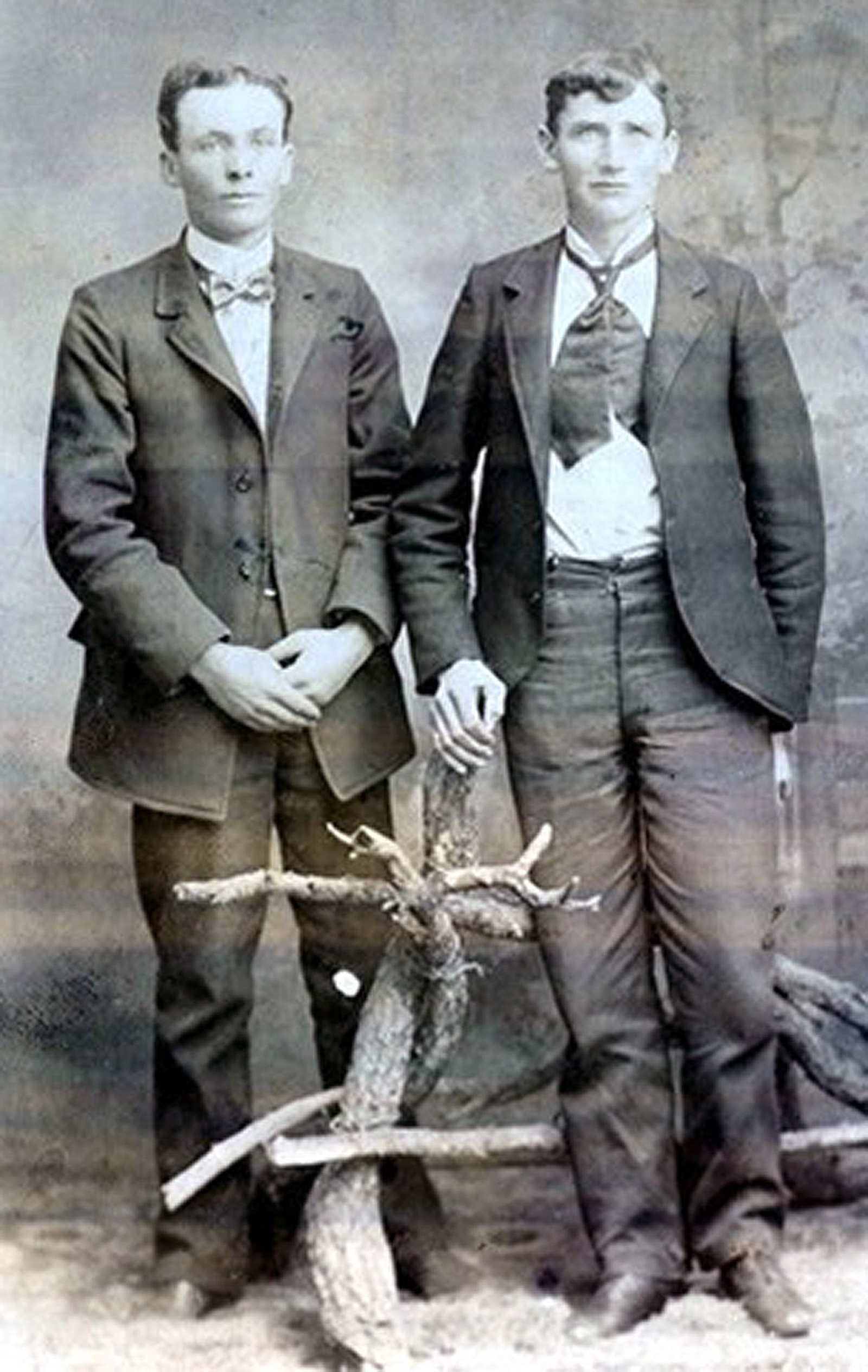 Ed Wilkes and Thomas Blacker
Ed Wilkes and Thomas Blacker
Let us again quote from a previously written history of the family:
"It seems Mother Nature provides a way for a family to provide room in a home as well as to provide necessities. With daughter, Mary, and Grandpa Isaac Loveday coming to live with them, something had to give to make room, for the family was still in the enlarged log house of four or five rooms. This meant eleven in the dwelling, and of this number at least six were adults or nearly so.
"We don't know that this situation speeded up a romance, but there was a twenty-four year old bachelor in the small community, and a twenty-four year old girl moving into 'town' to live with her parents, and with this, one will have but little guessing to do to figure what might come next.
"Also, son Tom, the oldest son at home was now of marriageable age - 22 past - he had had his eye on a younger sister of the bachelor just mentioned.
"Whether Grandpa and Grandma Blacker had anything to do with 'clearing' the house of some of the occupants so there would be turning around room, we don't know, but it happened. Ed Wilkes, the eligible bachelor and Mary Blacker started keeping company, and Tom and Hettie Wilkes continued keeping company until their double wedding in the Logan Temple on the 10th of June 1903. Grandma Blacker, as most mothers do, questioned the marriages of any of her children, so she questioned these marriages. Usually, in any mother's questioning, it simmers down to the fact that she doesn't want to lose a son or a daughter, but uses as an excuse the question as to whether the intended companion is 'good' enough for her son or daughter. According to the reports handed down, it seems Grandma approached it from still another angle, "Why did two of her children have to leave home the same time and most seriously, why did two of her children have to pick their intended companions from the same family?" It was but a question in her mind to which she had to give voice, but the foursome knew she wasn't serious enough for them to consider postponing the wedding." (Born of Goodly Parents; p. 12).
Back in Almy, the two married children, George and Sarah Ann who had married Aunt Polly (Mary Bailey) and Archibald D. Nisbet, respectively, remained with the coal pits. As previously stated, Uncle George and Aunt Polly, lived in the house his parents had moved into years before and in which he was raised until they were married.
As with most young couples, their families started with Aunt Sarah Ann providing Edward's and Althera's first grandchild, son William. Within four or five months Uncle George and Aunt Polly presented the grandparents their first granddaughter, Marsena. The order of their respective second children was changed and another little girl came, this time to George and Polly with the young Nisbet family having another little boy in October of 1898. In Uncle George's family the little girl was named Althera (Allie) and Uncle Arch and Aunt Sarah Ann named their little boy after his father, Archibald Edward.
It was earlier stated that as the years passed, coal in the mines ran out and the miners, with their families, were forced to go elsewhere for work and this became the problem to Uncle Arch and Aunt Sarah Ann for by June of 1899 when their next son, John, was born they were in Diamondville over near present day Kemmerer. Sadness came to the family in August prior to John's birth in October, for ten month old Archibald passed away.
Uncle George and Aunt Polly remained a little longer in Almy than the Nisbets and had their first boy and third child, William John, in Almy in January of 1900. However, by February 25th 1902 when Edward George was born, they had pulled up roots to never return to Almy and had moved to Spring Valley, a desolate little valley east of Evanston with its only supply of water so sulfurized that it could not be used for drinking purposes. Barrels of drinking water were shipped in by rail and sold to the families for twenty-five cents per barrel. The mining company had constructed a few houses for their Spring Valley employees.
Two and one half years after the birth of young George, when their new baby, Mary, was born, they had moved to Cumberland, where they remained thru the years until their entire family was completed - ten children. Sadly, little Henry T., two and a half years of age had passed away in 1913, followed by his older sister Marsena, age seventeen, in 1914. Their youngest baby, Grace, was born, on the 8th of November 1915 and passed away on the date of her birth. Son William John passed away in 1916 when sixteen years of age. All were buried in Cumberland. Uncle George and their older sons remained with the mines, however, Uncle George, during a goodly number of his later working years, held executive positions and, for a number of years, served as Wyoming State Mine Inspector. After Cumberland closed down in the neighborhood of 1928 to 1930, the family moved to the Rock Springs and Superior and Reliance areas where coal was more plentiful.
Of the three boys of this family who reached maturity and married, George, Ephraim and Hyrum, only George lived to raise their families. Ephraim passed away when his first and only child, Eileen, was six weeks old. His wife, Lena Perner, then only twenty-six years of age eventually remarried to a Mr. Lenzi and, by the end of 1982 was living in Rock Springs. Ephraim was a young man of twenty-eight years at the time of his passing, on 16 Dec 1936 at Cumberland.
Hyrum married a young lady, Margaret States, and their little daughter, Sherry, was under two years of age when her father passed away at the age of, also, twenty-eight, in 1941. Margaret, with Sherry, moved to Laramie where, thru the years, Margaret taught school from the approximate date of her widowhood to and thru the decade of the 1970s.
With apologies to Sherry, this writer hopes she will not mind that I copy a most welcome letter we received from her. It is self explanatory, but Sherry's account should become a very important lesson to all of us.
March 25, 1975
Arvada, Colo.
Dear Loyn and Mabel,
I wanted to thank you for answering my letter. I'm sure you were very surprised to hear from me. I haven't had any contact at all with any of my father's family the past several years. I've been wanting to contact them. I don't know why my mother hasn't had any contact with any of them for all these years. I wonder if it was because of the Mormon religion. She sent my son, James, a couple of Blacker news letters for a project he was doing at school and there were three names with addresses. I wrote to all of them. I got a very nice letter from Earl Cazier. He suggested most of my immediate family would be around Rock Springs and gave me George Blacker's name and address.
I received the history of your parents yesterday. I've started reading it and it is very interesting. That will be wonderful for the children coming up. I've had to tell my children I don't know anything about their grandfather or his family except he died when I was three. That doesn't seem fair to them.
I enjoyed hearing a little about my grandparents. I have one picture of them and only four or five pictures of my father. I wish I could remember my father but I just don't remember him at all.
My mother never remarried and she has been teaching school in Laramie, Wyoming for the past 32 years. She was selected Teacher of the Year for the state of Wyoming in 1972.
I'm 35 years old. My husband, Rene, and I were married when we were both very young but we have always been very happy together. He teaches school in Denver. My son, James, is 16 and his life is basketball. He is 6' 1" now and he is hoping he will take after his grandfather Blacker's family and grow at least five more inches. Carrie is in the 7th grade and Scott is in the 5th grade. We belong to the Methodist church.
Thank you again for taking the time to write and thanks especially for the history of your parents.
Sincerely,
Sherry B. Shaffer
We had started our correspondence with Sherry as can be learned from the date of her letter which had followed our first letter to her. The above letter was received just a month prior to our call to the Leeds England mission, which apparently interrupted the frequency of our letters to her, however, there was a limited amount of correspondence.
A subsequent letter from Sherry which followed our mission is here copied:
15 June 1978
Arvada, Colo.
Dear Loyn and Mabel,
I guess you are home from England by now. Time passes so quickly.
I wanted to write and thank you again for sending me your book "Born of Goodly Parents". I was reading it again today. You mentioned once you were planning to write some more. Have you been able to do any more?
My daughter, Carrie, who is 17 is on a trip in Utah. She is in Salt Lake now and wanted to look up some information on our relatives at the Mormon temple or where ever it is they keep all of that information. I gave her names from your book. I'm anxious to know if she will find any thing. Where do they keep that information and can anyone get it? We don't belong to the church. Why do the Mormons feel it's so important to trace their ancestry? It's really interesting and I would like any information available, but I was wondering why it's so important to Mormons.
How is Earl Cazier? He was so helpful when I wrote to him. I feel very badly that I haven't written to any of you for so long. Uncle George wrote a couple of letters to me. I didn't know he had died until I got your letter of Jan. 1976. (We were in England at that date. L.B.) I felt then that I had waited too long before I tried to get in touch with any of the Blackers. I realize today that was no excuse for not writing to the ones who had been so helpful to me. I am writing to Earl today. I hope all is well.
Is there going to be a family reunion this year?
Thanks again.
Love, Sherry Blacker Shaffer
Shortly following this above last letter from Sherry, - it was probably longer than 'shortly' but, certainly, within a few weeks or a couple months her letter was answered and mailed, but the letter was 'returned to the sender'. Apparently they had moved. There has been no contact between us since but this one thing is sure, before this day closes, two letters will be prepared, one to Sherry's mother, Margaret, to the last address we have of her which has been several years. The other letter to Denver superintendent of schools to make inquiry as to where Rene B. Shaffer, Sherry's husband, might be located. The process may be long, but an attempt is going to be made to again locate Sherry and family. And while we wait the result we must continue and, at this point, back to Uncle George and Aunt Polly.
To all of us nephews and nieces, this uncle and aunt, were live storybook characters. While they lived apart from all other families of the Blacker clan, it seemed to be the nature of their employment which made it possible to have an annual vacation period - probably two weeks - during which time they would visit relatives. Most of us of other branches of the family were farmers and we but read of people having vacations, but we were never either smart enough nor ever had finances sufficient to have vacations. Too, the nature of the vocation - with farming to be done and animals to provide for - vacations never became a part of our social diet.
The writer's memory included the fact that miners fared better than farmers. Particularly did this appear so after labor unions became powerful enough to demand better working conditions, better hours and better pay which situation became effective following World War I which ended in 1918. It seemed that the remaining miners of the Blacker family always had beautiful, stylish cars. Invariably it seemed the Cumberland Blacker family took delight in big black sedans. Earlier Uncle George and Aunt Polly made their visits alone - that is, without children - however, of later years, their son, Hyrum, became their regular chauffeur on trips to their relatives. The shiny, black limousine was an attraction anywhere and seemed very much out of place when it was driven into a farmer's back yard and along side his buggy or wagon or even his Model T, but we kids loved the recognition and distinction that came with it.
While farm work had to go on despite the visiting dignitaries, we found however, that particularly the milking chores could always be done in just a little less time in order for us to join with the visiting guests in the evening's family get-together.
Both Uncle George and Aunt Polly were larger than normal folk - just a little on the plump side and in whose-ever company they were a part of, there was a lot of conversation and laughing. We knew in advance that by the time bedtime would come around our sides would be aching because of laughter. It was a thing out of this world to listen to Aunt Polly's laugh. In our experience, no one in all the world had Aunt Polly's laugh. One had to hear it to know what it was like and Uncle George seemed to have a faculty to keep her laughing. It has been said that movie- house operators would invite her to their shows in order for their paid customers to hear her laugh, for oft times, more interest was engendered from hearing her laugh than from the show itself. If people who knew her knew that she was going to be at an entertainment in which there was an element of comedy there would be nothing that would keep them away. It has been reported that, after an evening out and in the company of Uncle George and Aunt Polly, she would become the universal topic of conversation that evening and the next day with none of it being criticism in any form.
Without fail, before Uncle George and Aunt Polly left, at the conclusion of their visit, he would pass to every child in the home, a shiny silver piece, usually at least a half-dollar. All of our cousins reported that he did the same thing in their homes, and in case of an older bashful girl, he would exchange a dollar piece for a kiss, after considerable teasing. Indeed, a visit from Uncle George and Aunt Polly which, for years, was annually, was like a story experience from Grimm's Fairy Tales.
Uncle George and Aunt Polly sang beautifully together and he was in demand as a public speaker, both in politics and in church, and became known as a great funeral speaker. Even on those occasions, the discomfort of his celluloid collar (this was during the period when men's white dress shirts had detachable collars of celluloid which took care of the 'ring around the collar' problem) it was not al all uncommon to see Uncle George, half way thru his sermon - if it were a church talk or funeral talk - to reach up and untie his tie and remove his collar and put them on the pulpit or in his pocket and proceed with his talk, all this seemingly automatic, without disturbing his chain of thought or talk.
As earlier stated, the George Blacker family moved from Cumberland - closed down from diminishing coal supply - and moved to the Rock Springs area about 1930.
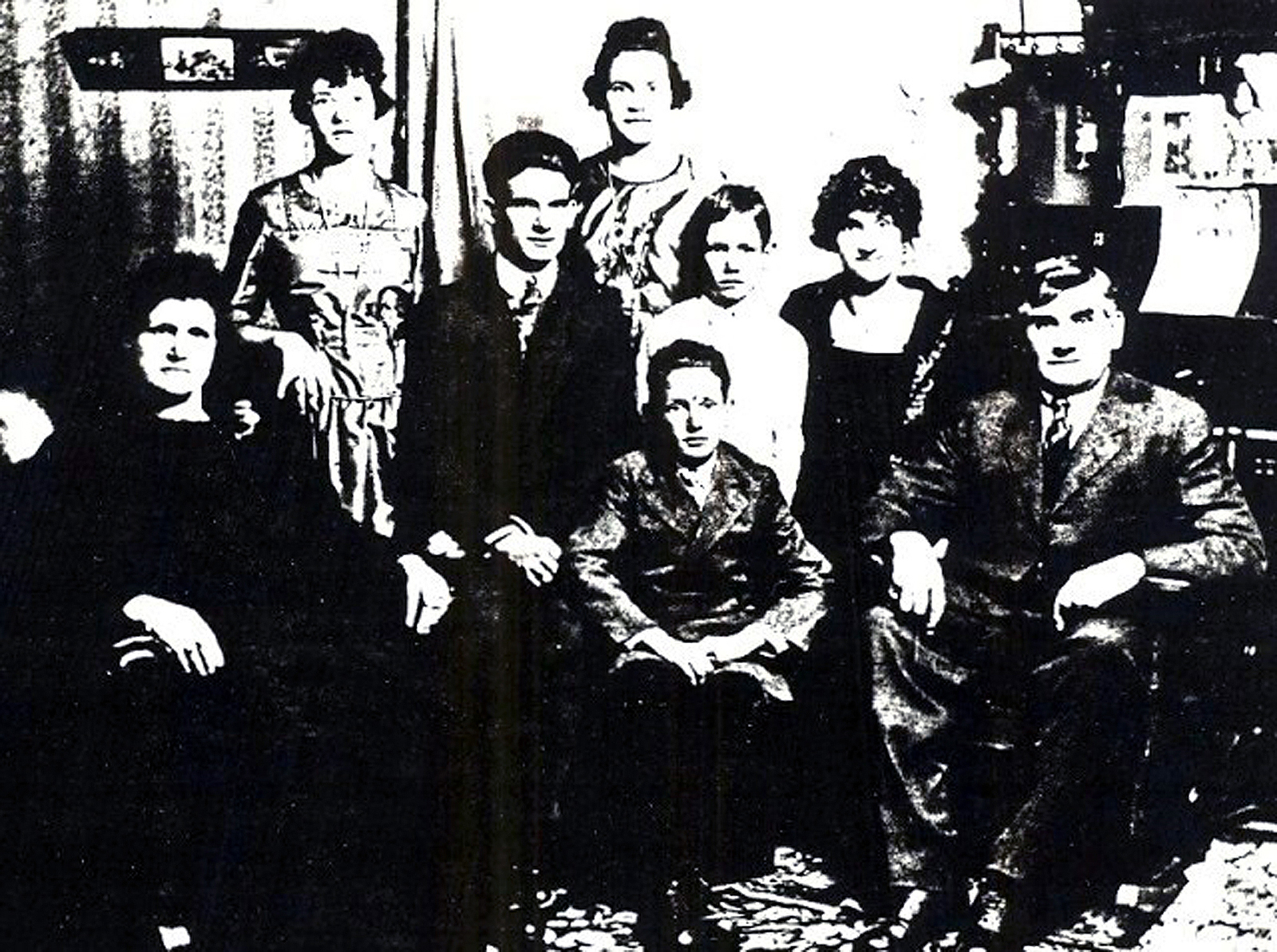 The George and Polly (Mary) Blacker family of Cumberland, about 1919
The George and Polly (Mary) Blacker family of Cumberland, about 1919
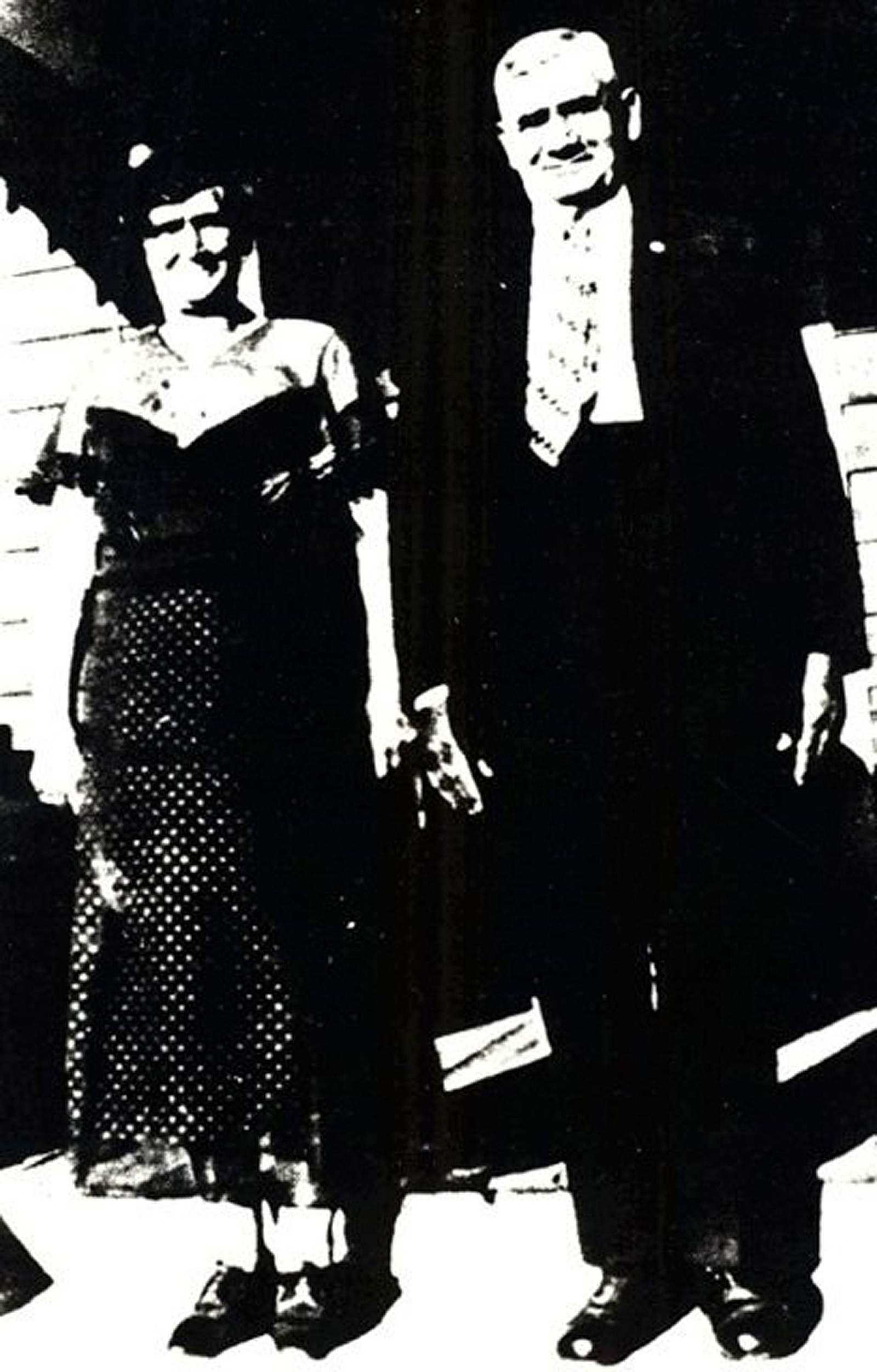 Aunt Polly and Uncle George, Cumberland, 1930
Aunt Polly and Uncle George, Cumberland, 1930
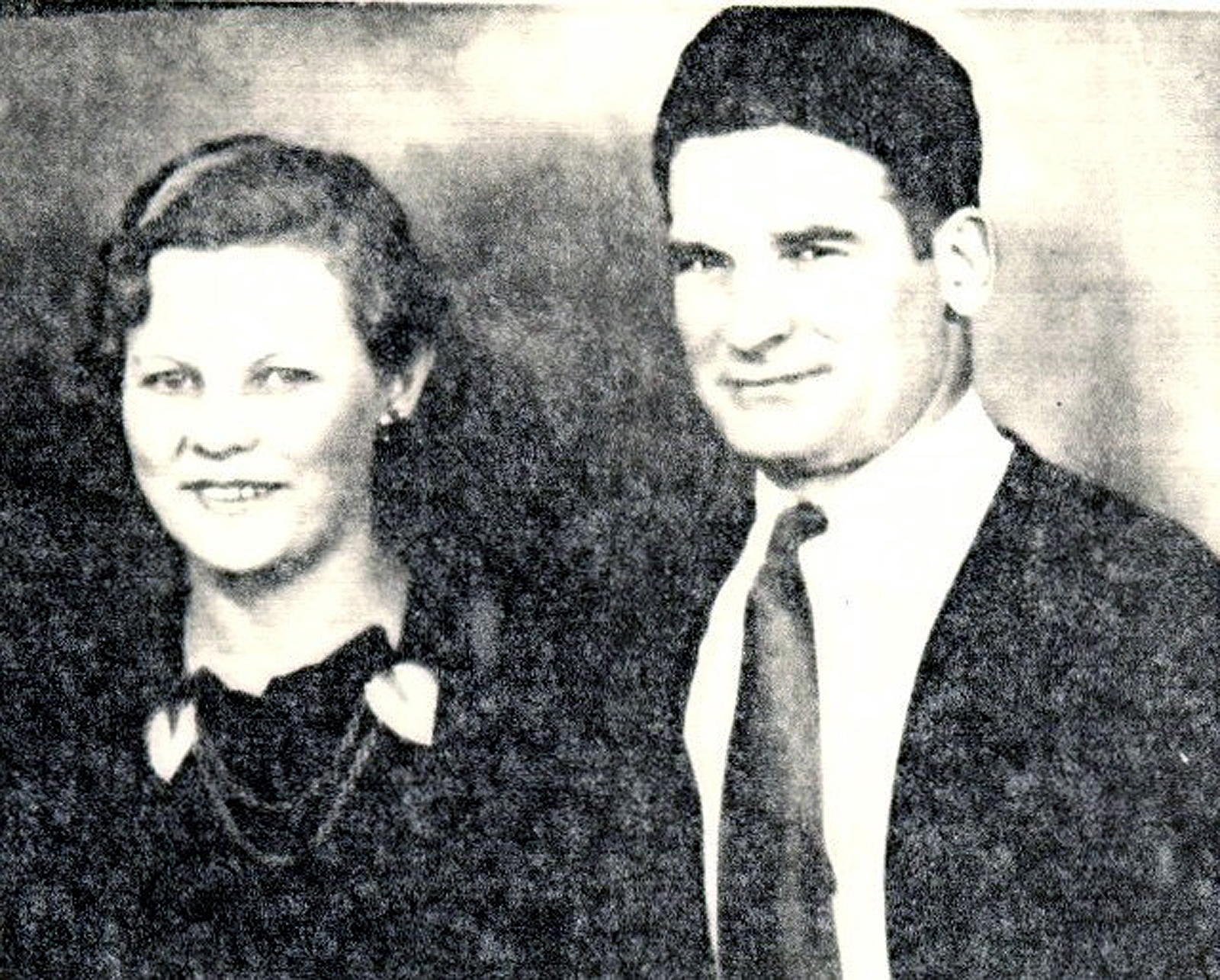 Ina and George Jr., Rock Springs, Wyoming about 1936
Ina and George Jr., Rock Springs, Wyoming about 1936
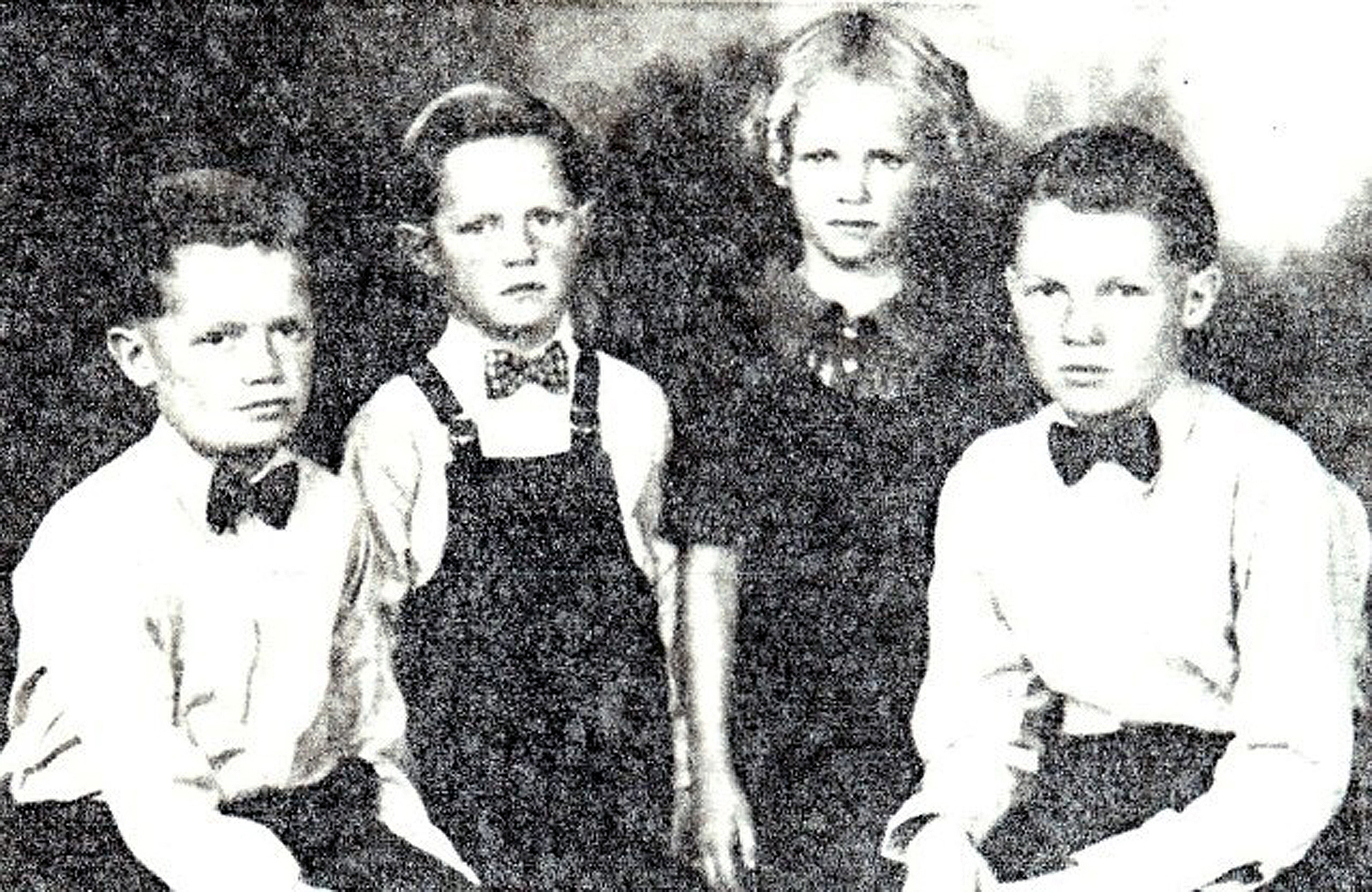 George Jr and Ina's children William, Kent Dean, Maxine, Keith
George Jr and Ina's children William, Kent Dean, Maxine, Keith
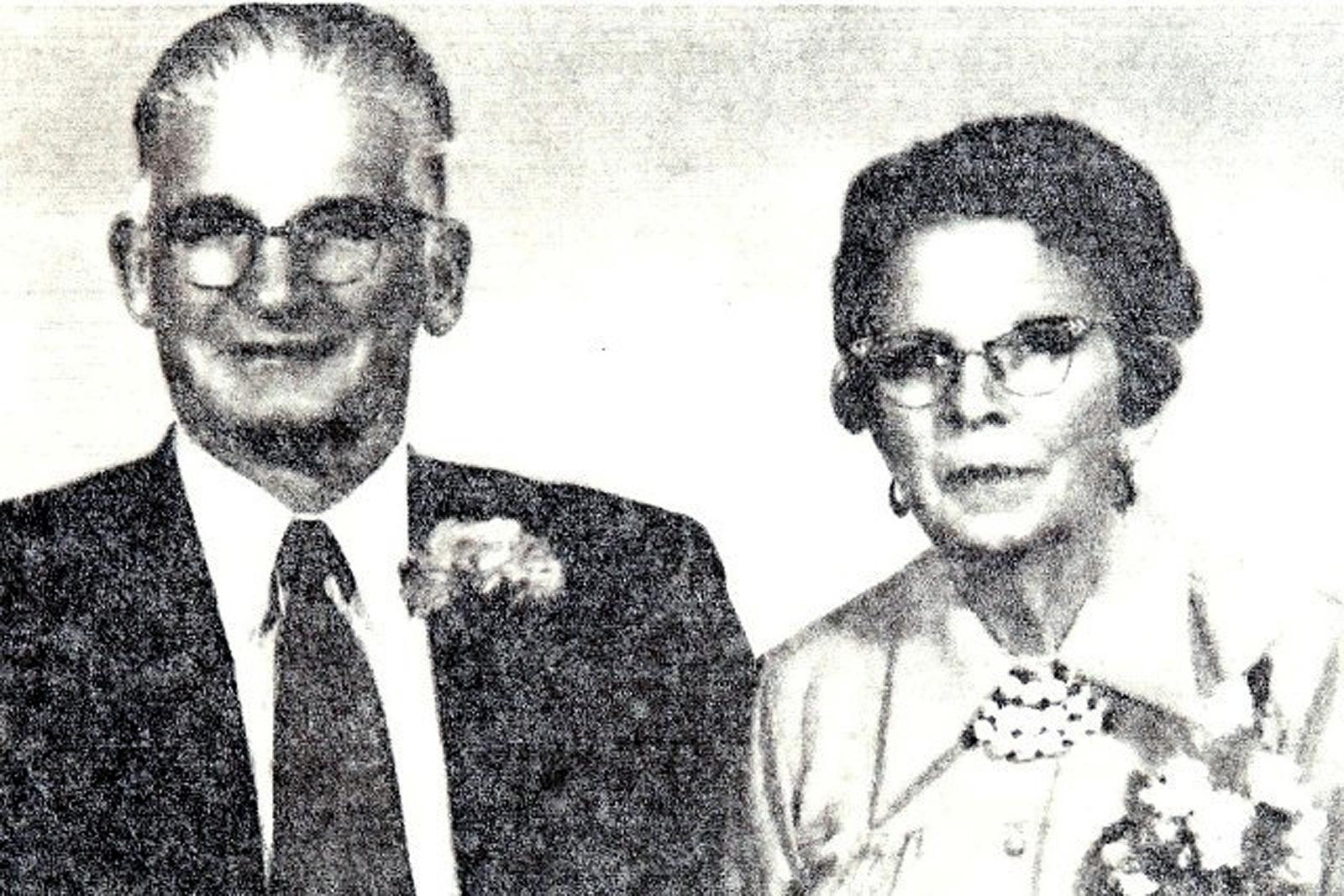 George Jr. and Ina on their 50th wedding anniversary, 3 December, 1974.
George Jr. and Ina on their 50th wedding anniversary, 3 December, 1974.
Let us return again to the Nisbet family, after leaving their story. At this time their third son, John, was born about six weeks following the death of their second little son, Archibald Edward, he having been named after his grandfather, Edward Blacker. They had already moved from Almy and found work in the mines in Diamondville just neighboring Kemmerer.
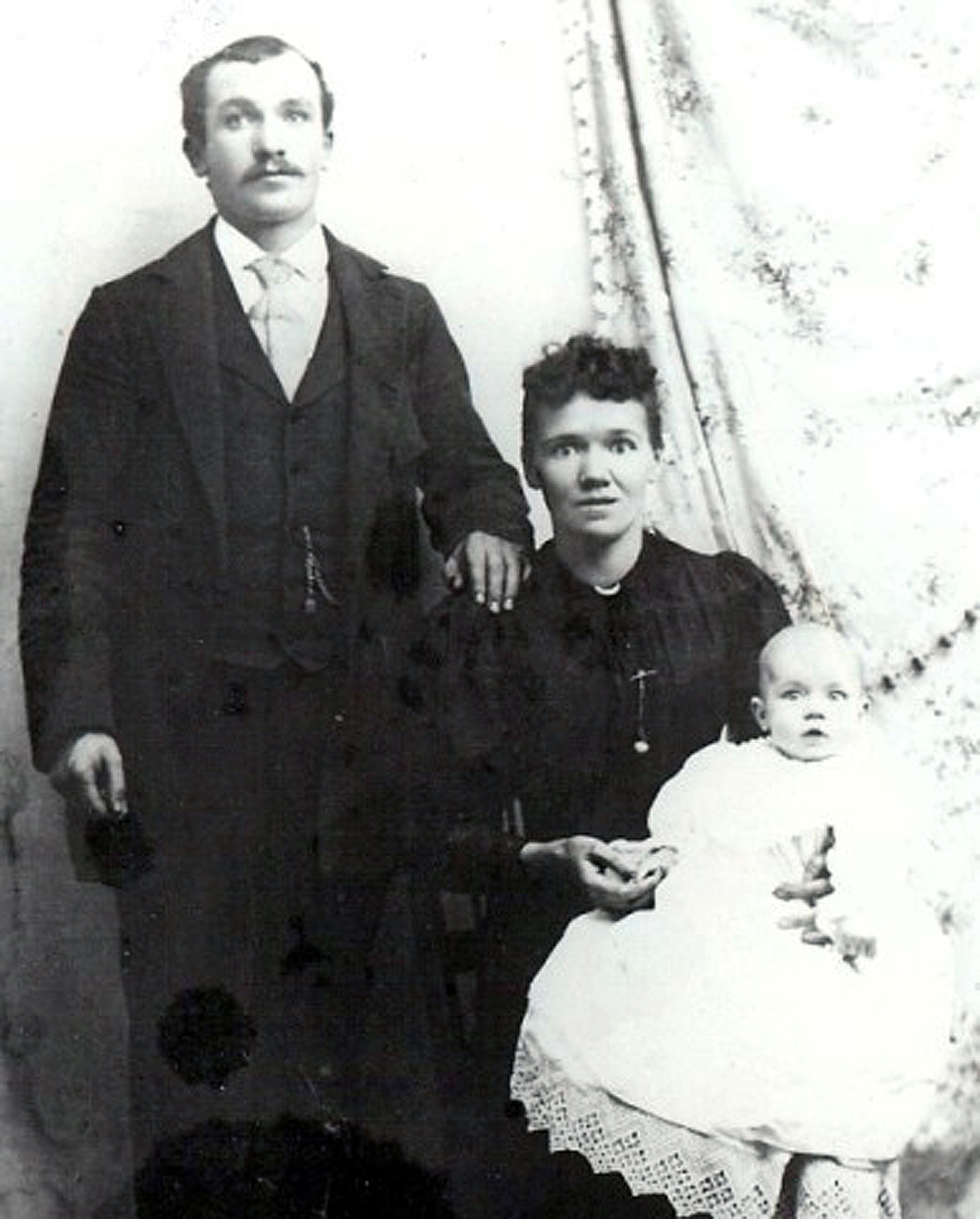 The Nisbet family in 1896: Uncle Arch, Aunt Sarah and William
The Nisbet family in 1896: Uncle Arch, Aunt Sarah and William
Their stay in Diamondville was brief for by the time of the birth of their first little girl, Merintha A., they were living in another little neighboring camp called Frontier, just to the north of Kemmerer with Diamondville being to its south. Whether or not the mines in Diamondville belonged to the same coal company as those in Frontier, this writer does not know. Such could have been very possible just as the coal company in Almy had several mines along the eastern hills of the Almy valley.
In this life we are not given all the answers for a seemingly overabundance of life's problems to fall on some families. Already mentioned was the passing of little Archibald Edward and but six months later, baby Merintha Althera passed away when but a few days over one month old. William and John remained the only two children of the family until in August of 1903, baby Dorotha was born and became the family's only living girl, for as mentioned, her two older sisters had passed away. Over two years later, as the family was preparing to welcome another arrival, Irene, and but six days before being born, the only living daughter, Dorotha, passed away. The family's living span in Frontier was indeed fraught with discouragement and whether such discouragement had anything to do with a move we are not prepared to say. However, within three or four years the family moved to a newly opened mine approximately six miles further north than Frontier to Sublette where, on the 3rd of May 1909, a pair of twin boys was born. Could it have been thought by the family that Mother Nature was going to make up for some of their past losses of family members? They certainly would have had every right to have such a hope when, but six days later, the youngest of the two, Durie, passed away. Downs was permitted to remain with the family.
Two years and two weeks later, another little boy, Clinton, was born. With all the disappointment the family had to this point it would appear the law of average would have favored him to remain with the family, but again, not so. He succumbed shortly after birth, this on the 14th of May 1911 nd the sorrowing family found it necessary to take him, in his little casket, back to Diamondville some probably ten miles away, for him to rest at the side of his two little brothers and two little sisters - five in all having died within the twelve years between 1899 and 1911. Out of a family of nine children, but four were to remain.
In Sublette, and possibly Frontier, Uncle Arch's employment brought him up out of the mine, for he became what is called in mining terminology, a tipple foreman, whose work is to oversee the unloading the coal conveyers as the coal comes from the mine. During those years, undoubtedly, most of the coal was brought to the top by, originally tubs or cars on wheels drawn from the shallow veins by man power to where the tunnels were large enough that horses or mules could be used, but later by cables operated by steam engines from the outside of the mouth of the mine. When electricity became more common, it replaced other forms of energy. The unloading of these tubs or cars was done, usually, into railroad coal cars at the local rail siding at the site of the mine. Certainly there would have been some advantages doing this type of work rather than work deep in the mines but, too, one can think of some disadvantages. Certainly it was not without an element of danger.
On the 11th of October 1912 another little girl arrived in their home and she was named Elva Adelia. It seems most likely, by this time, Uncle Arch and Aunt Sarah Ann had already made or were soon to make plans to leave coal mining for good. We do not know what brought on the final decision but, by the time of the birth of their next little girl, Olive Annice in Sugar House, Utah, near Salt Lake City, they had already had spent several months in Ogden where Uncle Arch worked with the railroad.
As we look back from today we wonder if his work as tipple foreman in Sublette could have brought him in contact with railroad people - he was emptying coal into the railroad cars, who knew of work in Ogden. They could not have stayed in Ogden long, for the family, especially Aunt Sarah Ann, was waiting for Annice's birth fifty miles south of Ogden in the thriving little town of Sugar House.
Actually, Uncle Arch had two brothers, Tom and Will Nisbet, who were operating a business in Sugar House in which they bought and sold feed, mostly for animals - a hay and grain business. And here it was that Annice joined the family on the 22nd of October 1914.
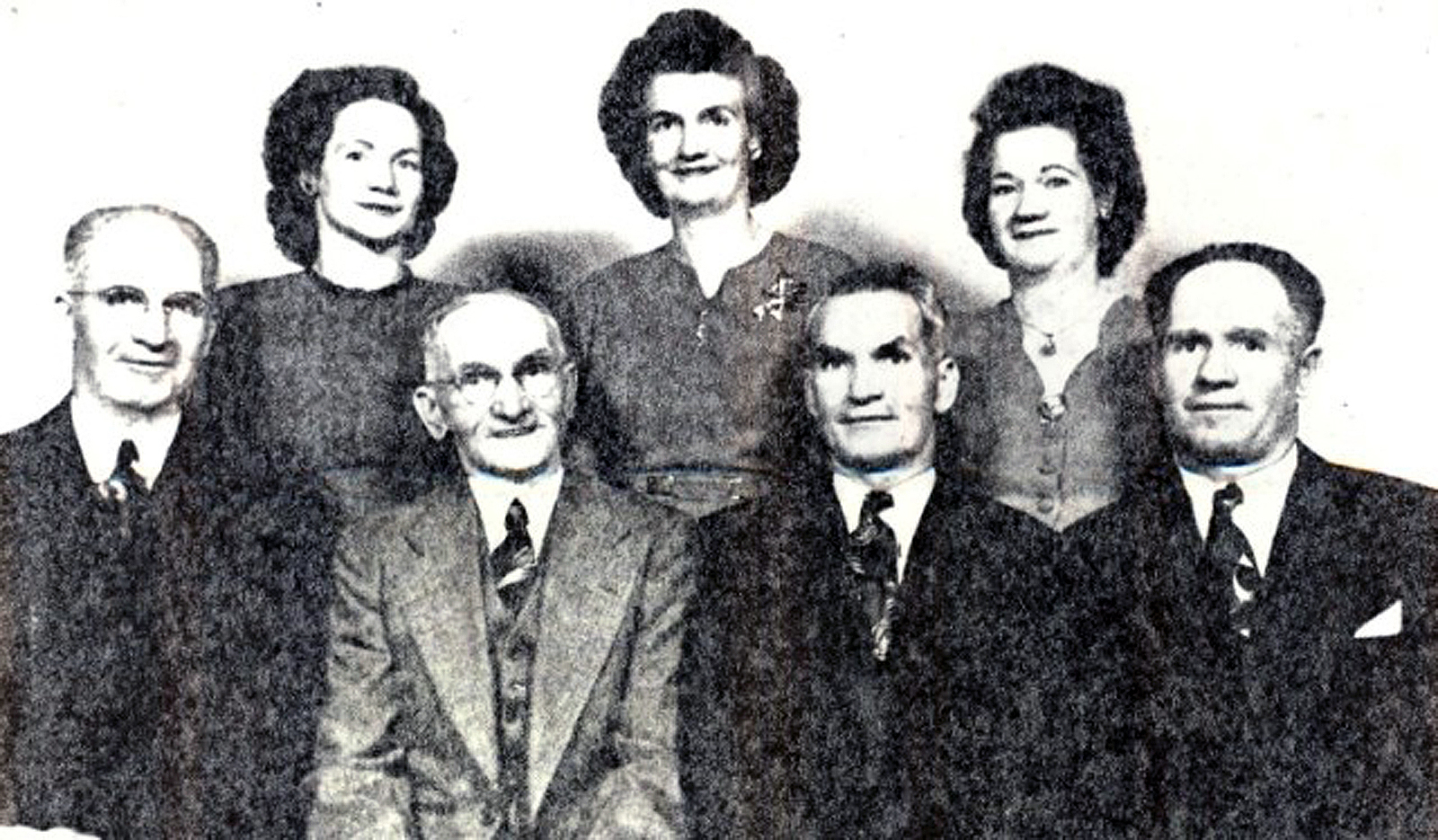 The Nisbet family in 1948. L to R: William, Uncle Arch, John and Downs. Back row: Annice, Elva and Irene.
The Nisbet family in 1948. L to R: William, Uncle Arch, John and Downs. Back row: Annice, Elva and Irene.
By this time, the family was growing up. Son, William, was 18 years of age, John was 15, Irene 9, Downs 5 and Elva 2, and lastly now, Annice.
During the next three or four years, the family continued to have great concern for Aunt Sarah Ann's health. While in Wyoming, particularly at Sublette, a sore on her forehead developed, which even with the aid of doctors, seemed unwilling to be healed. Subsequently, it was declared cancerous, but in those days, such a malignancy proved an enigmatic unknown, which even the doctors feared would be spread by surgery. A living death proved to be ahead for Aunt Sarah and how fortunate for her that she had an usually caring family, particularly, her husband.
With the hope she might find assistance in the fresh air of a higher altitude, the family succumbed to the persuasion of a purchase of a ranch or farm in the clean air of Bernice, Idaho, a ranching area of the Lost River country of central Idaho.
This venture did not prove helpful nor practical. It was from this locality that son, William, was inducted into the armed services, for World War I was being fought. The family then moved into the Rupert, Idaho area, where Uncle Arch found employment, first with the railroad but soon, more to his liking, a job with the Minidoka County Highway Department, where he worked for several years.
All thru the years, Aunt Sarah Ann was worsening and after ever so much suffering and all the kind care her family and other could give her, she passed away on the 26th day of August 1926.
In the meantime, William returned from the Service and found himself up in the Wasco, Washington area where over many years he successfully operated a lumber and hardware business.
John successfully operated an oil distributorship at Rupert until retirement. Irene married and remained in Rupert, Downs worked for many years on the railroad from Rupert. His wife passed away but a few years following their marriage and he has remained a widower thru these many years. Elva married Fred Blacker. They found themselves in the furniture business nearly forty years ago in Ontario, Oregon and ended up in their present business with their family in Willard, Utah. Annice became a schoolteacher soon after graduating from school and has remained in the lucrative profession thru all these years starting first in the Twin Falls, Idaho schools and has spent the most of the remaining time in the Portland, Oregon area.
Following Uncle Arch's retirement, he, a professed Democrat, was appointed by the local Republican administration of the time to serve as Rupert Justice of the Peace. At the time, his duties involved him in serving as the judge of traffic violators. This portion of his work was later transferred to the County Probate Judge, however, he continued with his assignment of Justice of the Peace, where he served with distinction for several years.
The Nisbet family was talented musically. When just a young man, William became proficient with the violin. John's voice was, literally, one of a kind. His singing thru the years has been greatly in demand. It probably is not often that a man's voice is classified as a sweet voice but his has been just that. Thousands of people have been thrilled to tears as he has sung, particularly, at funeral services for all religious denominations of the area.
Irene has spent practically a life time at the piano, as also, has Elva. These girls were and are both gifted as to 'touch' at the keyboard when serving as accompanists to others. The writer never remembers John singing when he was not accompanied by his family, earlier, of course, by his sisters and then subsequently by his daughters, Phyllis and Coralee.
And Elva's and Annice's duets with Irene accompanying!! If angels can sing more beautifully, they will have to come from out of this world. Their singing-together-years, naturally, were while they were yet girls at home. It would be hard to conceive of anyone, or pair, or group, who were more in demand, and while their singing seemed so effortless on their part, surely their schedule was demanding. And none of them ever hesitated when they were wanted or needed. All of them blessed the lives of many people, and in doing so, they will be the first to say that their lives were also blessed. They have shared their talents freely. See the Nisbet family chart in the family chart section of this history.
Of the Edward and Althera Blacker children, next in line following Uncle George and Aunt Sarah Ann is their daughter, Mary.
Mary's health was not of the best during her entire girlhood, yet, she remained up and doing. As has been mentioned on more than one occasion in this history, it fell to Mary's lot to live most of the time as a girl with her grandparents, Isaac and Mary Danks Loveday.
Mary was born in Mountain Ash in Wales in 1878 and was but a little girl of five, when she with her mother and older brothers and sisters, came to the states. Already her grandparents had raised their children to adulthood. It is true, one young Isaac Loveday, had not yet married, but he was an adult of 26 or 27 years of age when the Lovedays reached Almy. Otherwise, the grandparent's children had long been raised. Too, Mary's moving in with her grandparents provided a little more room in her parent's home. It is not to be pre-supposed here that the latter was the reason for her assignment with her grandparents.
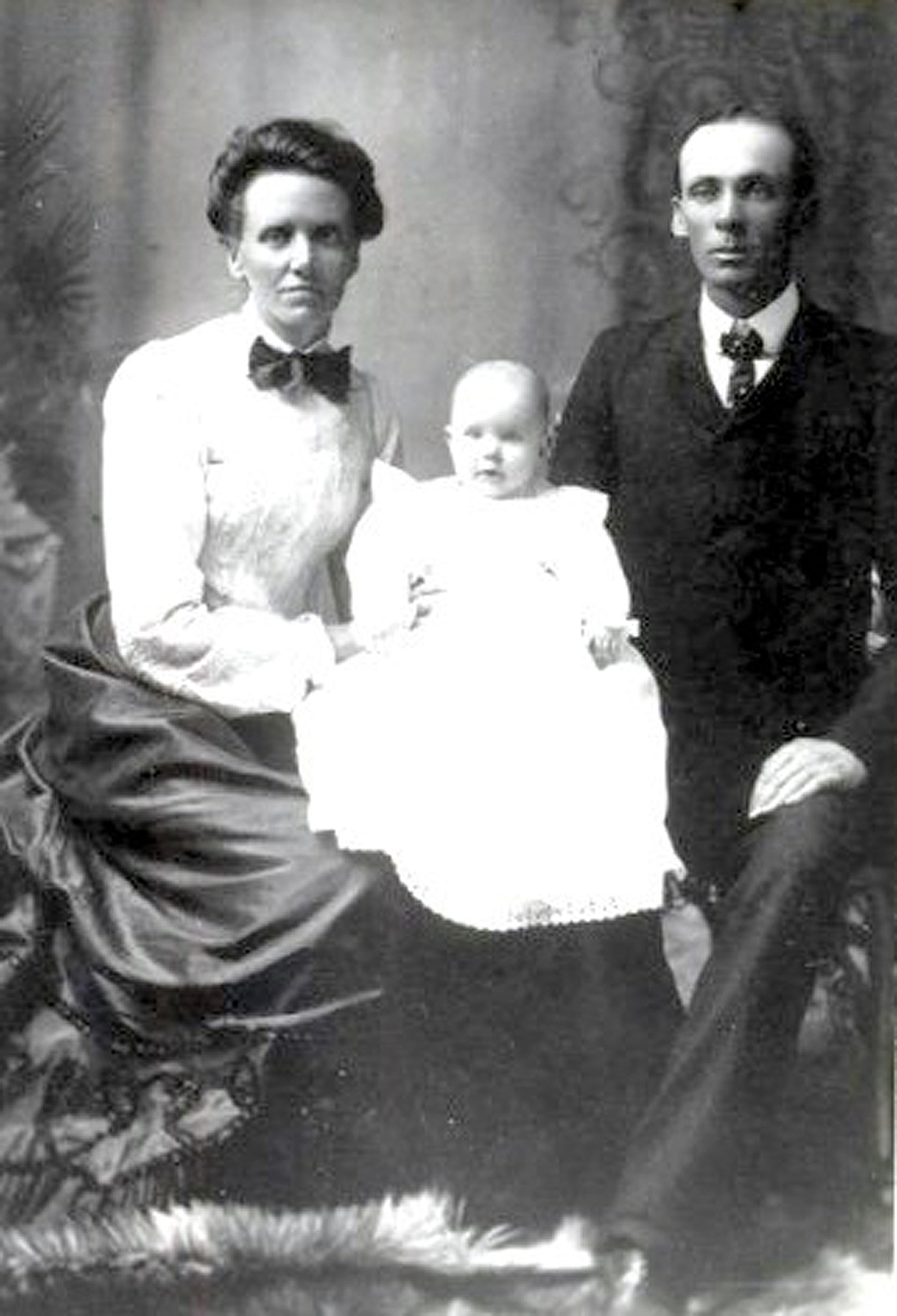
As has been cited elsewhere, Mary remained with her grandparents in Almy until her grandmother, Mary Danks Loveday, passed away on the 14th of April 1902. At this point Grandpa Loveday and Mary came to Star Valley to make their respective permanent homes.
Following her marriage to Edmond Wilkes in 1903 she and Uncle Ed moved to the Guy Dakin ranch where he was employed. Uncle Ed had previously been employed thru a mail contract with the post office service for eight years delivering mail from Afton to the Lower Valley, a distance of approximately twenty miles. He, with his brother, Johnnie Wilkes, had a contract for these years and, particularly during the winter months had many narrow escapes with his life.
Following his marriage, for several years, Uncle Ed hauled freight for the Burton Mercantile Company between Afton and Montpelier. On March 23rd of 1905 a little girl came to live with them whom they named Arvilla. When Arvilla was just a small baby, her parents moved to the little log house just north of the Swift Creek bridge on the road between Afton and Grover - just at the edge of the Afton city limits. The farm belonged to Uncle Ed's parents, but they were living in their new home in Afton just across the street from Burton's store.
While living at this home, on the 26th of May 1907 a son, Howard, was born.
Sadness seems never to be confined to the few. It has been and always will be a part of life. It is true some seem to have more than others, but by great odds, the majority of people face it somewhere or sometime. The occasion came to the Ed and Mary Wilkes family all too soon, for after less than six and a half years, wife and mother, Mary Blacker Wilkes, on the 28th of October 1909 passed from this life leaving a very saddened husband and little 4 1/2 year old Arvilla and 2 1/2 year old Howard. She was buried in the Afton cemetery on the other side of town.
The Wilkes family in Afton suggested and invited their son, Uncle Ed, to take his two little children, and with them, return to his parent's home. He also, felt was the wise thing to do, for his employment had to go on, for life for him and his little family was still to continue.
Just barely within a year's time he had persuaded Elizabeth Moffatt, the single young lady of the same age as Uncle Ed and Aunt Mary - actually the three of them within three weeks of each other's birthday - to marry him and assist with the care of his two little children which she did on the 28th of September 1910. To this union four children were subsequently born, three of whom lived to maturity, Mary, Lanore and Murray and each of them has had a loving brother and sister relationship to their half-sister, Arvilla and half-brother Howard. Indeed they were every bit as close to each other as any family could be.
When Arvilla reached the employable age, she found work and worked efficiently and most satisfactorily for many years as a telephone operator at the Afton telephone switch-board. She married Glen Humberg of Ovid, Idaho. For many years they resided in California and eventually returned to Salt Lake City where he passed away.
Howard married Lola Allen and was employed in the grocery business in Pocatello, Idaho, where their daughter, Myrna, was born. Howard passed away when but 25 years of age.
Click here to see the Edmond Wilkes - Mary Blacker family chart.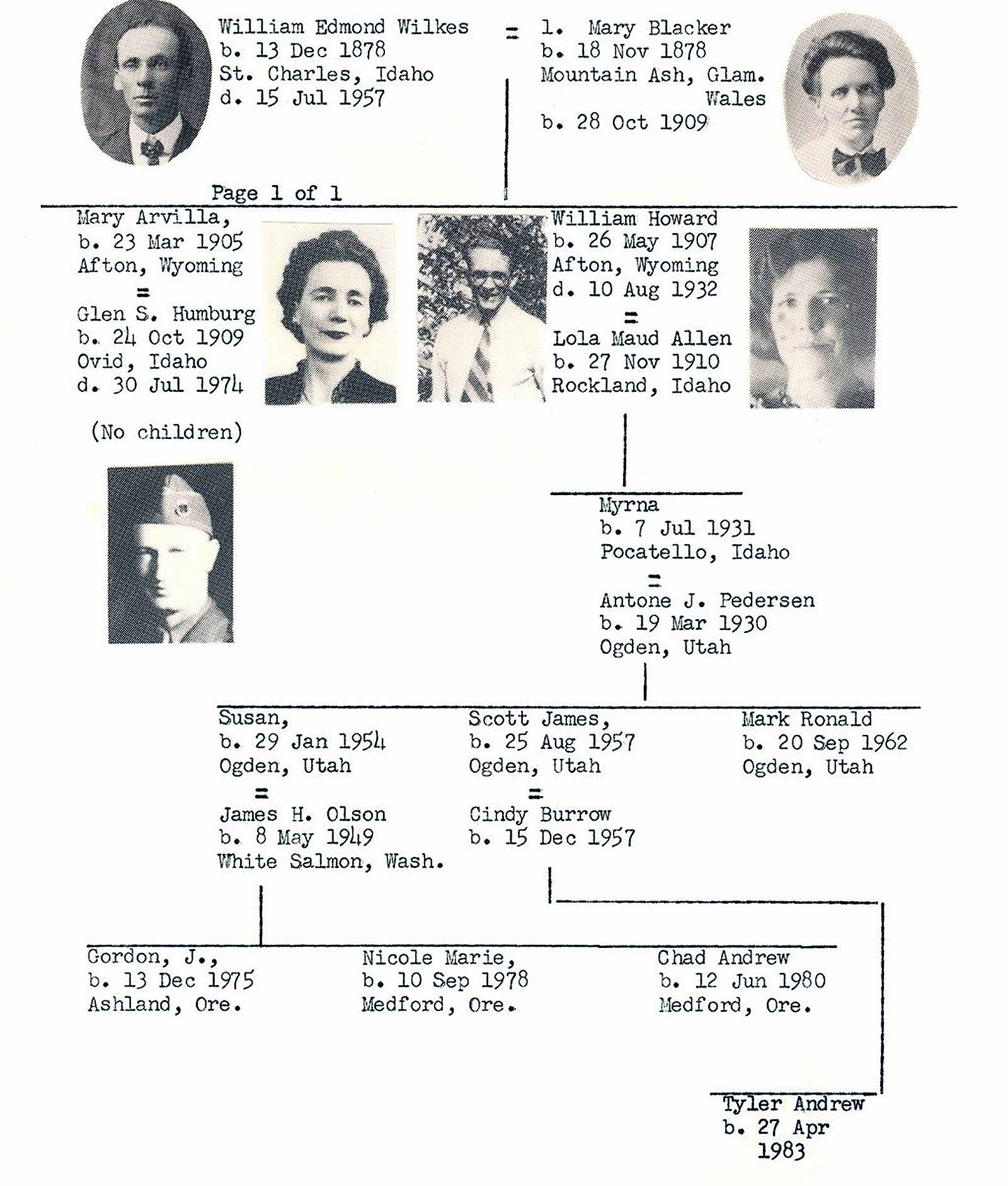
To the Thomas and Hettie Wilkes Blacker:
Following their marriage, this couple moved to a little log house just a few hundred yards from his parent's place. Undoubtedly he assisted on his parents' home place. If he was not already, he was soon to become employed by the Burton brothers on their meadow ranch across Salt River from the Blacker farm where he was to spend his full time. Uncle Will, the next Blacker boy in line to operate the farm was now about 17 years of age, a little young for full responsibility, however, we must remember that Grandpa Blacker was yet very much alive and would be for another seven years, so despite his failing health, it would seem the Blacker operation could continue on reasonably well without the full-time help of Tom, as he was known by the family.
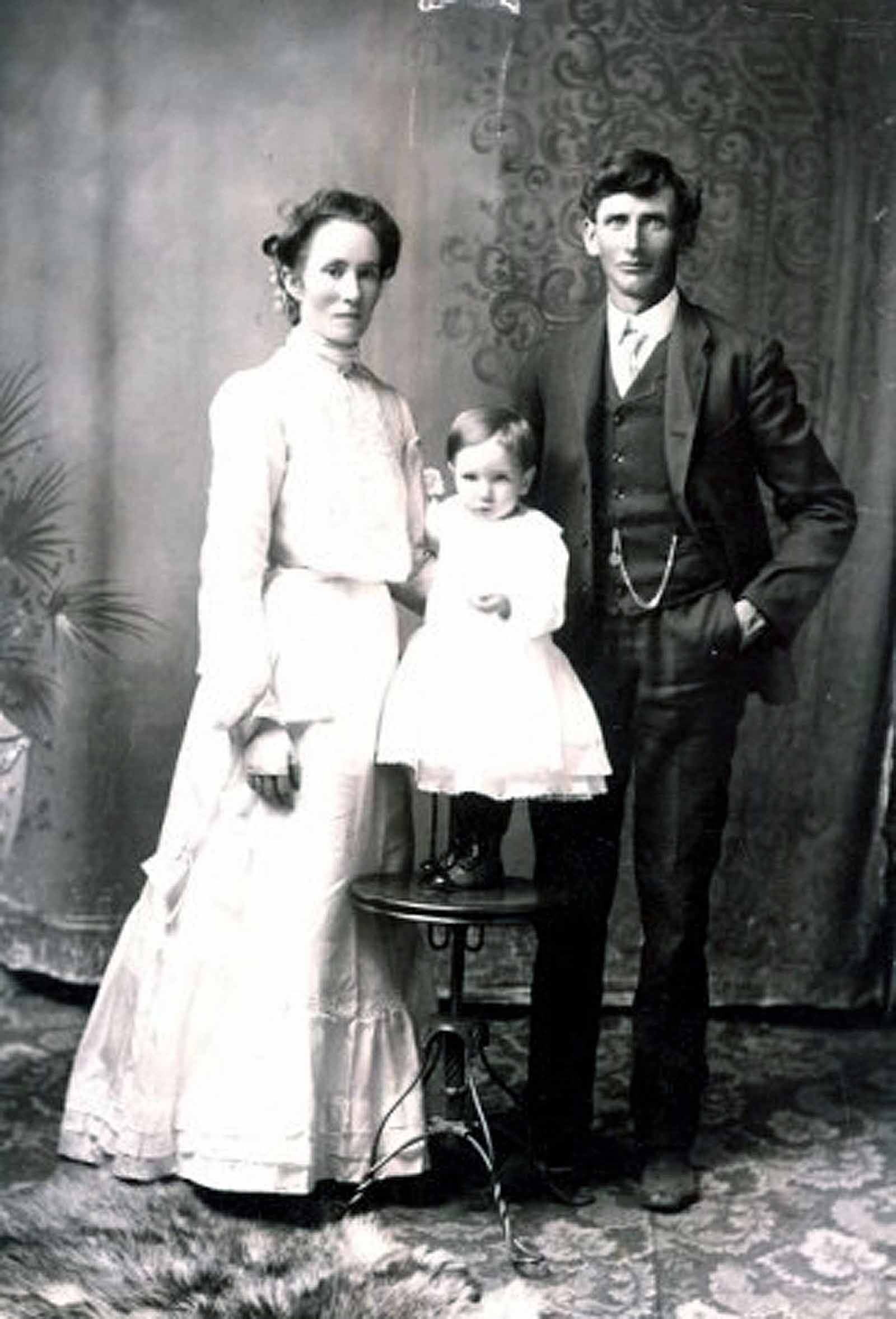
Whether first son, LeRoy, was born during the time the young couple was living in the little log house at the end of the lane a few hundred yards from the old home or whether he was not born until the couple moved across the river into their second home, another small two room log cabin, we do not know. We are aware that the actual birth took place at the Wilkes home in Afton, where the new mother chose to have her confinement.
They did not remain with the Burtons long, for within two or three years an opportunity afforded itself for them to purchase 40 acres, again with a two room log house, over on the Afton-Grover road one mile to the east and one-fourth mile north of the older Blacker home. We are not informed of the price and terms of this 40 acres, however, within an additional two or three years they purchased an adjoining 40 acres to the north of the first forty for $800. This last purchase would have been about 1907 or perhaps 1908. It was known as the Howland Forty stemming from the fact that a Mr. Howland was the previous and possibly the original owner. On this forty there was also a two room log house which remained empty and/or was used for storage for grain.
Prior to this time a second son joined the family, Theordore, who later succumbed to the then dreaded disease of whooping cough when but a year and half old. Less than six months later third son, Loyn, was born and a few months over another two years fourth son, Fred, came to claim habitat with the family, this in April 1910.
It was just six months prior to this date that Aunt Mary Blacker Wilkes passed away and back in the Edward and Althera Blacker home the angel of death had marked the day when Grandpa Isaac Loveday, Althera's father, was no leave mortality - the 11th of May 1910.
On a Saturday afternoon of late August of the same year, out of a non-consequential looking cloud in an otherwise, nearly clear sky, came a bolt of lightning, instantly killing a pet dog which was walking between two little urchin-appearing boys returning to the log house from their search for eggs in the barnyard. Their mother, (Hettie), was kneeling in the open doorway with her pail of water and her scrubbing-brush doing a Saturday chore in preparation of a clean house for Sunday.
After a moment's hesitation, which must have been attributed to shock, she arose to her feet, waved her two egg-hunting errand boys back from the already dead body of the faithful dog and further away from the house. She then hurried to the already burning bedroom where hot cinders were falling on the face of the baby, Fred, now four months old, who was sleeping on the bed of the only bedroom in the house.
Father Thomas, was binding oats in a field near Afton two miles away. How he got the message that his home was afire and his family had been endangered we don't know. Perhaps his first intimation was hearing and seeing the crackling of the lightning with the accompanying thunder, and then seeing for himself that it was his own home from which the tell-tale smoke was swirling up from the orange-red of the flames from the house.
To unhitch a three-horse team from a grain-binder, tie two horses to the binder, pull the harness from the remaining horse, get astride it and race to his burning home nearly two miles away - not knowing of the welfare of his wife and three children - to say the least, must have been traumatic. It must have seemed a forever-trip and all the time, naturally, fearing the worst.
What a relief it must have been when, as he neared home, he could see that the concerned neighbors who were much closer than he, had already arrived to give what assistance could be given. It had to have been one continuous prayer in his heart, and probably, audibly from his lips, as he persuaded the horse to maintain its fastest speed, for the safety of his family. What a relief it must have been as he saw them all mingling with the neighbors as the burning roof fell in onto every article of furniture and clothing they prided themselves of having. It wasn't much, but it was their all. Only the clothing, which was on the family's backs, was saved. but by good fortune, the family was safe.
An old wives' tale has it that when death strikes a family the grim-reaper does not leave the environs until three are taken. In the case of the overall Blacker family on this series of visits by the Reaper, he had a 'hey-day'. Before he left the Blacker environs there were taken Aunt Mary B. Wilkes, and Grandpa Isaac Loveday in October of 1909 and May of 1920, respectively. Grandpa Edward passed away on the 27th of November 1920, and one day later, little Harold Edward Gardner died, the three month old baby of Aunt Maria Blacker and Uncle Brig Gardner, whom we will introduce as our next-in-line family. Grandpa's and Harold's funerals were held as one.
As the reader will note, the Thomas Blacker account has been interrupted by one paragraph in an attempt to relate an observation in sequence of time of the overall Blacker family.
Now we return to the Thomas Blacker family review:

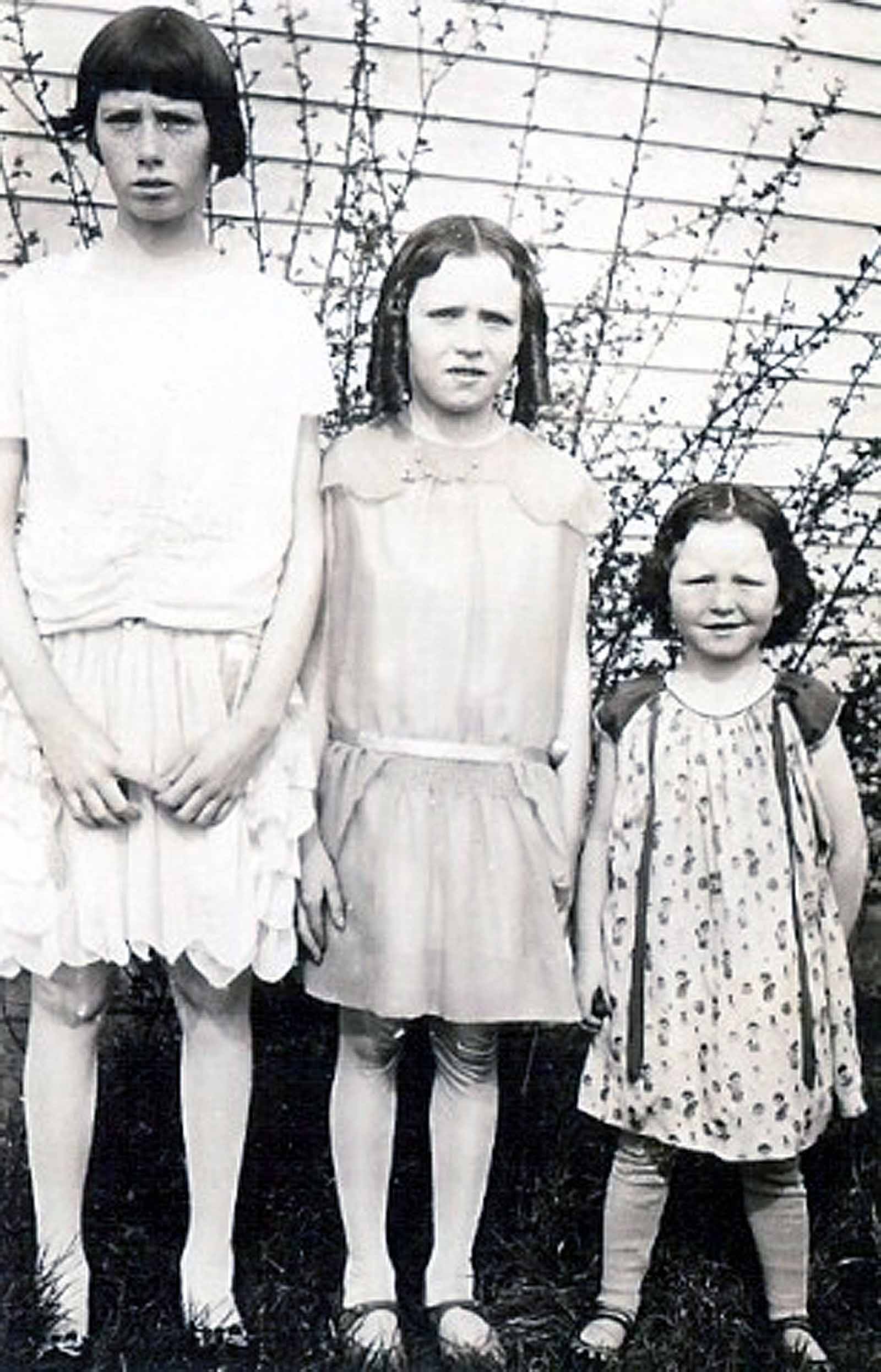
Their account in this history will be kept as brief as practical. A much longer account of this couple and their family was written by this writer well over ten years ago - 1971 - and is available in the family.
While Thomas and Hettie remained in Star Valley operating their 80 acre farm and a good-size herd of Holstein cows, their family continued to grow. Alma, the fifth son was born in 1912, Hyrum, number six in 1914, and following him in 1916 came a little girl, Afton, and then in 1919 another boy, George.
The short season of summer and the cold of the long winters, to a man who was particularly interested in crops from the soil, needled Dad to become attentive to the farming stories of the Minidoka Irrigation Project of south-central Idaho. After investigating, a move was made during the last two or three days of 1919 and the 1st of January of 1920, when the household goods arrived in Rupert, Idaho.
The inflationary prices of the World War I economy came to a close by the severe depression of the 1921, 22 and 23 years, and the new investors of high cost farm land were drastically affected by the economic reversal. The Thomas Blacker family was not alone in the painful experience, but their total investment plus previous holdings were 'gone with the wind'. There was nothing by way of choice to do but to throw their shoulders back and attempt a new start.
The experience was traumatic, but people had made adjustments before under like situations and so adjustments were possible again - not necessarily without concern and a degree of pain. There became a part of the readjustment and the family survived, in fact was enlarged. Following George's tour of being baby of the family in 1919, he was required to relinquish that status to a new arrival, Merintha, who made her debut into the family on the 8th of Dec 1920. Two and a half years later, sons in the family, eight and nine arrived to complete a threat Tom had made during the period in Star Valley, when he managed the Afton baseball team. He said then that he would produce a team of his own. Numerically, his threat was realized, but in the writer's memory he doesn't recall our father ever teaching us which end of the bat one is to take hold of when swinging at the ball.
On the 17th of Jul 1923, the twins, Earl and Verl, arrived. Whether it was purposefully designed that a family should not stop at #11, we don't know, but in this couple's case they concluded that an even dozen should round out the number of children, which was done when on the 17th of September 1925, third daughter and last of the twelve, a little girl, Marie, arrived.
Over the years the family's economic conditions improved. Actually, there was no other direction for them to go, for during the early 1920s, they were at bottom.
The temptation to return to Star valley was a reality, but just when the decision was to be made to do just that, an offer to lease an eighty-acre farm from the Amalgamated Sugar Company was accepted. That farm, located three miles west of the Minidoka County courthouse in Rupert, has, at this writing, been in the hands of the Thomas Blacker family for the past 60 years. In the meantime, all we children grew to maturity and have gone our separate ways. Marriages and family results are shown on the family charts in connection with this history and will be found starting in chapter eleven.
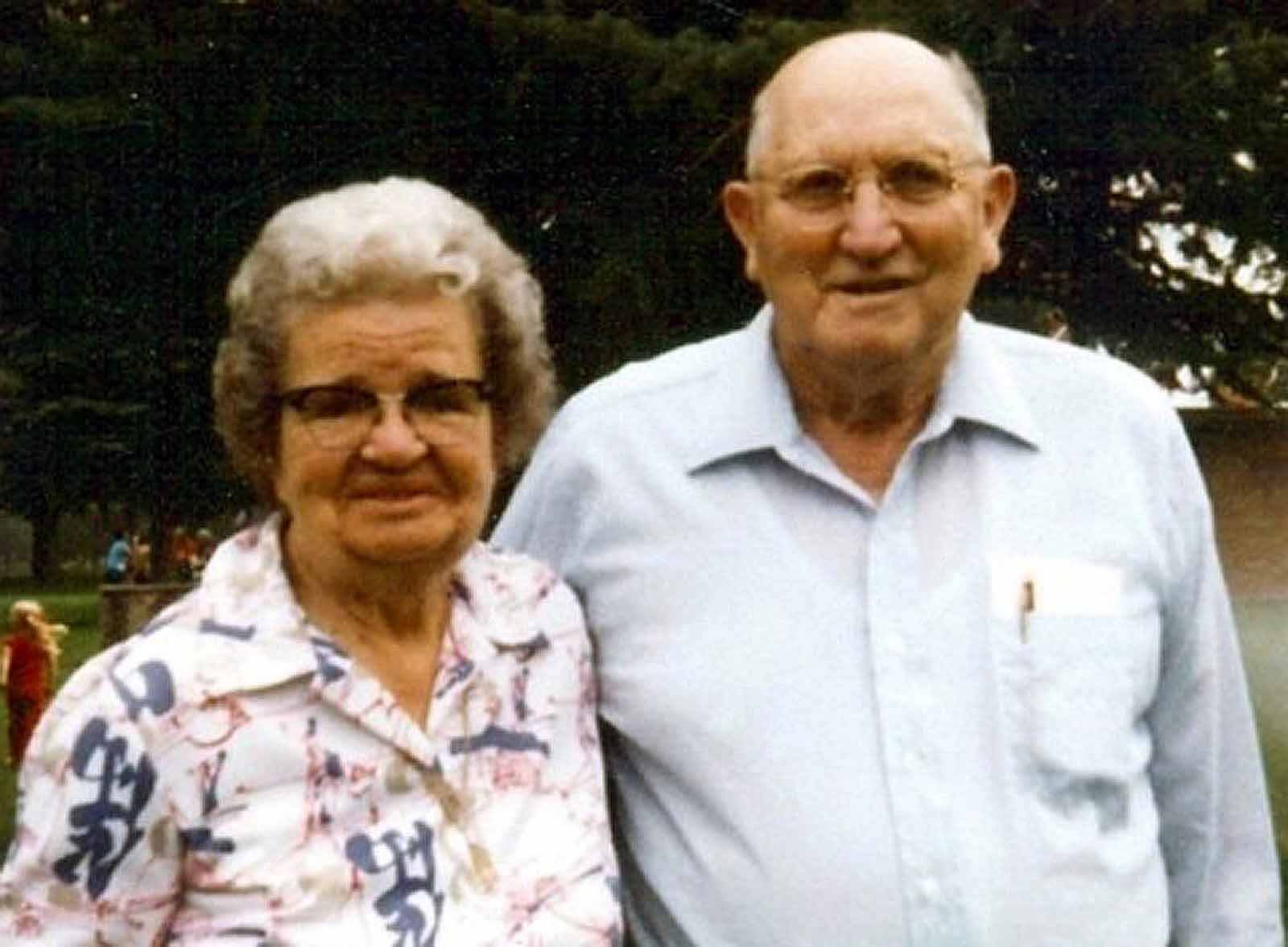 Hilda and Roy Blacker
Hilda and Roy Blacker
LeRoy started, after leaving the nest, with employment at such places as the creamery, the sugar company, the Minidoka Irrigation Company etc., but by the latter of the 1930s, returned to farming where he continued until retiring - at a reasonably early age - and then spent several years as the Minidoka County probate judge, which subsequently, had its nomenclature changed to judge of the Magistrate Court. This position, at the time of his retiring, was changed by the state legislature to having only attorneys at law as possible candidates. Church-wise, over the years, Roy has been active in many assignments including several years as bishop and since 1966 has served as a stake patriarch. All of his sons (2) are presently serving as bishops. Daughters are doing just as well.
Ever since the passing of our father, Thomas, in 1957, Roy has gently and faithfully assumed the responsibility of watching over the Thomas Blacker families which charge he inherited thru the principle of primogeniture or patriarchy as well as by direct assignment by our father as a part of our father's final instructions just hours prior to his passing.
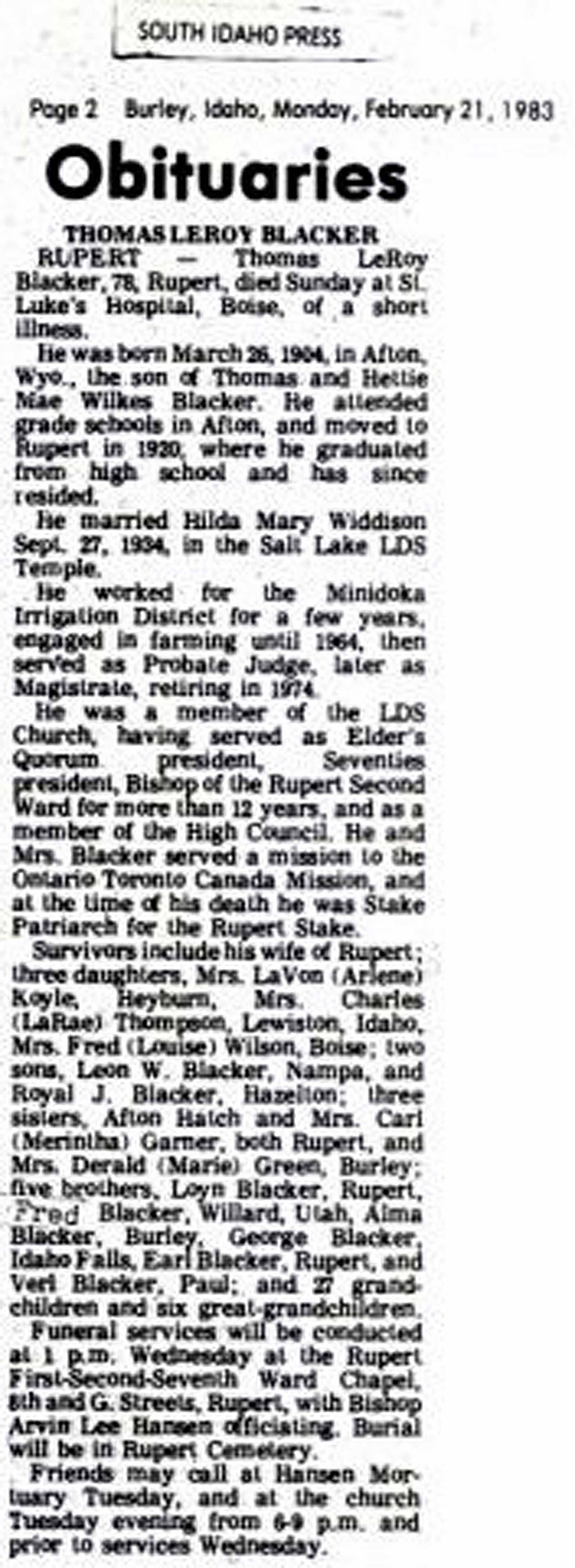
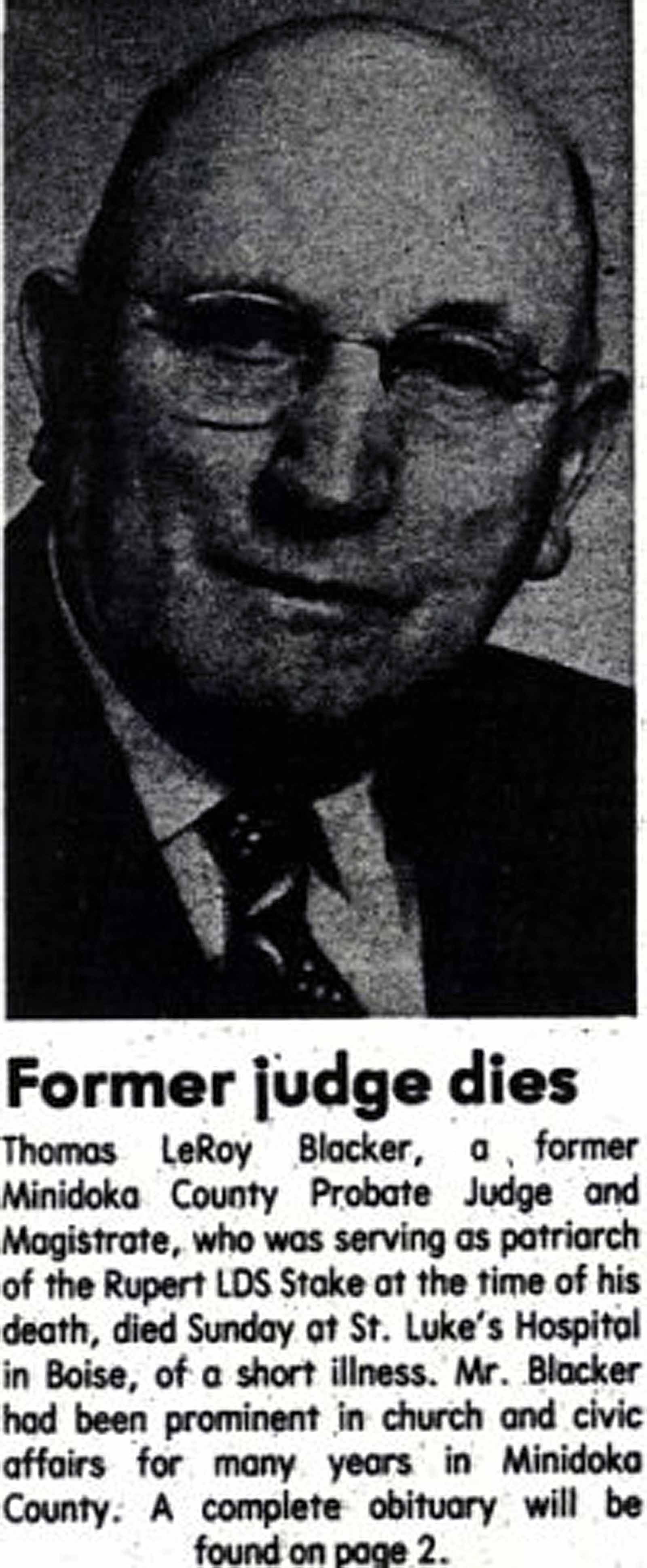
No one could have been more anxiously engaged in such an assignment and now that he, LeRoy, just yesterday – the 20th of February 1983 – left mortality, his ‘report’ to our father cannot help but be well received, not that he had perfected the family in his charge for we, seemingly, remained about as human as when his assignment commenced, but throughout he kept in touch. He knew what we were doing and knew where we were and often gave encouragement. Never a year passed but that he presided over the family reunion. Not all of us were present – there were those of us who preferred doing other things and going other places, but Roy could not be held accountable for others had the right of choice. He did with us and for us all that we would permit him and what more could have been asked.
He loved his family, those who shared his heritage, and if there were any who failed to love him, it has not been made known. Thanks so very much Roy. It will be hard to go on in your absence but, with the Lord's help we will.
Funeral services were held Wednesday afternoon at one o'clock on February 23rd in the Rupert 1st, 2nd and 7th ward building known as the Minidoka stake house located on the corner of 8th and G Streets. The life sketch was presented by daughter Arlene Koyle and two sons Royal, released as a bishop of the Hazelton ward after over six years service but three days previous, and Leon bishop of a Nampa, Idaho ward, spoke tenderly and lovingly of their father. The guest speaker was Roy's and Hild's former mission president, Elder M. Russell Ballard of the presidency of the Fisrt Quorum of Seventy
COOL HEAD AND SKILL BRINGS NATIONAL RECOGNITION
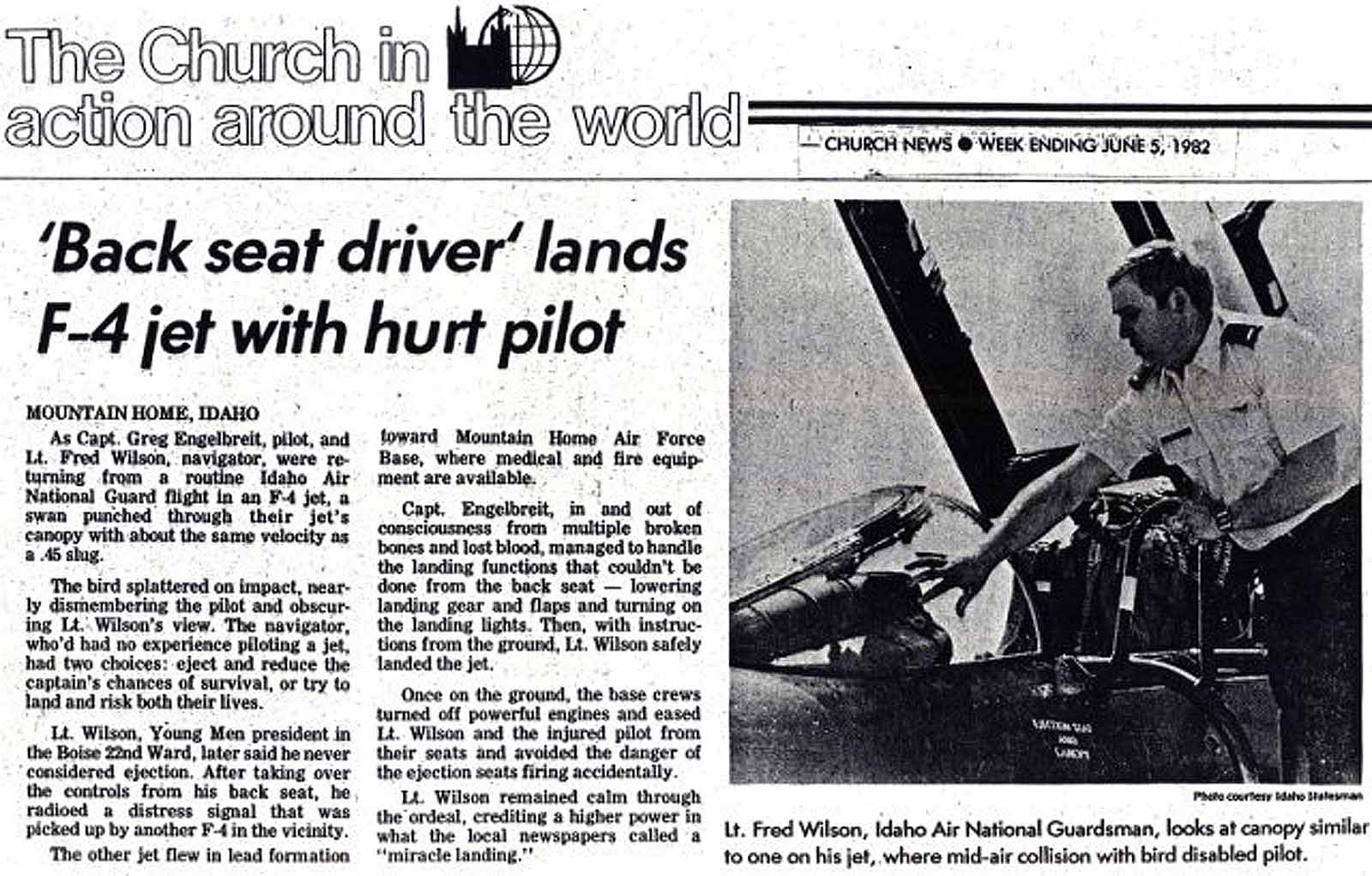
Fred Wilson, husband of Louise Blacker Wilson, daughter of LeRoy and Hilda Blacker became a subject of acclaim thru the news media - - national TV, radio and newspaper - - on 8 April 1982. One year later, less one day, a similar but not so dramatic experience happened.
Fred, with Louise, was invited to Washington D. C. on 13 September of that year for a special national presentation. That we might be accurate in our reporting we invited Fred and Louise to briefly present further details which was done thru his personal secretary, Louise. She wrote:
On September 13,1982, Fred received the Earl T. Ricks Award for superior airmanship and demonstration of the highest standards of crew co-ordination while flying an RF-4C, in successfully recovering from a night in-flight emergency that included aircraft damage and bodily injury.
Louise continues, "This award was given by the Air Force Association at its annual convention at the Washington D. C. Sheraton Hotel. We were guests of the association for six days.
"On April 10th, 1983 Fred was awarded 'The Distinguished Flying Cross for 'heroism while participating in aerial flight' as a Weapon Systems Officer near Mountain Home Air Force Base on 8 April 1982. He received this medal at ceremonies held at Gowen Field, Boise, on Sunday of the above date.
Fred was also involved in a second bird strike on 7 April 1983 one day short of a full year following his first encounter with a bird, the second time with a duck rather than a swan, near the City of Rocks some thirty miles south of Rupert. This time a duck came through the right front quarter panel of the canopy striking the pilot in the right shoulder. He was bruised badly, with lacerations, but no broken bones. Fred flew the aircraft the 15 minutes from there to Mountain Home and then the pilot, Major Dave Hudlet, was able to land the plane in spite of his injuries.
We are thankful that Fred, again, escaped injury. He's making a nervous wreck out of me, though.
Thanks, Louise, and to you, Fred, be careful with your driving. Perhaps those air-lanes are for the birds'. (Did we hear correctly, 25,000 feet?)
Fred and Louise live in Boise with their four children.
Following in age sequence, the children of the Thomas Blacker family: Loyn spent several years farming, which were interspersed with eight or nine years in teaching school in the Evanston, Wyoming area, three of which were spent in the Almy school district, the old home area of the previous two generations. Eleven years were spent in the furniture business in Ontario, Oregon with brother Fred, and subsequently the next nearly twenty-three years in the same business in Rupert.
Loyn's and Mabel's immediate family, not including in-laws, have spent over eleven years serving on full-time missions and the two of them a total of ten years on stake missions. She has served as a stake Relief Society president and he, many years on seven separate stake high councils in five different stakes. For the past twenty years they have served in the Burley Regional Genealogical Library and, in addition, the past three years as extractors at that library.
This news article appeared on the front page of The Minidoka County News on Thursday, July 3, 1969 and is self explanatory.
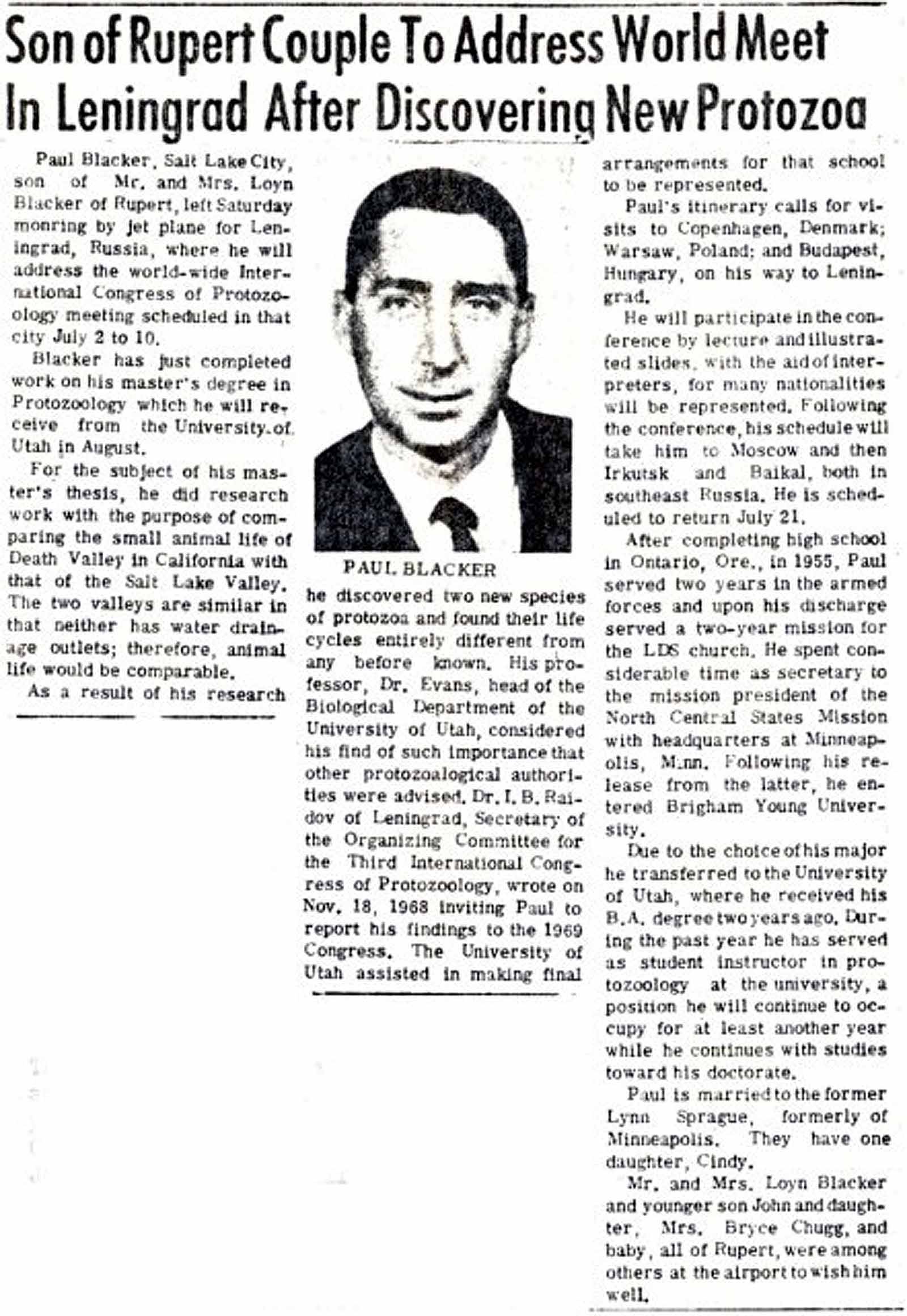
Paul returned from Russia by jet plane to Salt Lake City airport Monday, July 21, 1969.
In the early 1970s, Paul obtained his doctorate, and for the last several years has been employed as a senior scientist by Ford, Bacon and Davis Engineers, Inc., a world-wide engineering company. Stationed near the University of Utah complex, Paul heads his companies Environment Department, worldwide.
Paul's and Lynn's family, by February 1983, totals four girls and two boys with one granddaughter. Their home is in Alpine, Utah in Utah Valley
After two or three years in the service station business, Fred became employed as a clerk with Union Pacific and in 1945 got into the furniture business in Ontario, Oregon. By or before the mid 1960s, they moved to the Willard, Utah area where they made their beginnings in the large furniture operation they, and the next generation, are presently operating.
Fred served as second counselor to the stake president in the Weiser, Idaho Stake and when the Nyssa, Oregon Stake was organized, he served for several years as first counselor. After moving to Utah he was called as the bishop of their Willard ward where he served for a number of years.
After marrying Edith Jensen on 5th of April 1933, Alma moved to a rented farm two or three miles southwest of Rupert. They then purchased their own farm in the Emerson area - three to four miles west of Heyburn - where they eventually enlarged that 80-acre operation to include two additional 80-acre plots. Other than row crops,they had dairy cows and veered off into a small feed lot operation with beef cattle.
Alma and Edith sold one of their farms and purchase a nice home in Burley, where they have now resided for several years excepting spending at least four months of the year at their trailer home in Yuma, Arizona. Alma served in the Emerson Ward bishopric for several years.
Son, Hryum, early became a grocery store clerk and department manager in the grocery business in Ogden, Utah, where he worked for a number of years. He returned to Rupert and ran the old family farm for a couple years during and following World War II. He and Jessie and two daughters then moved to the Vernal, Utah area where they purchased their own grocery business. The entire family was greatly saddened with Hyrum's sudden passing away in 1948. Jessie and the two little girls continued with the business for a limited time and eventually they moved to Arizona, where the girls long since have married and have their families.
Daughter Afton married Horace Hatch, a local young man, who, following their marriage, farmed his parent's farm near Rupert for a number of years until they purchased one of their own three miles east of Rupert. During these years their four children, Myrna, Larry, Karen and Lorin grew to maturity and married. The two girls are gifted with music in voice and piano. The two boys have abilities, particularly in baseball and basketball, which has brought them local recognition. Karen reigned as Minidoka County beauty queen for a year while a senior in high school. Horace suddenly passed away about the middle of the 1960s and Afton has been alone for a goodly number of years. Her home is in Rupert.
George, Thomas' and Hettie's number eight, married Louise Hammer of the Idaho Falls area. For the first number of years, George worked for the local laundry and dry-cleaning establishment, among other jobs. Louise's mother had operated the Osgood Grocery store (four miles from Idaho falls) and persuaded George and Louise to take it over. They lived in the adjoining house to the store for many years, when a few years ago, they built a lovely home in Idaho Falls proper. Since then, while still operating the grocery store, George has been serving as a floor maintenance specialist at the Idaho Falls Hospital. He retired from this position at the end of 1982. Their son and all three daughters graduated from the Brigham Young University. A couple of their girls distinguished themselves on the BYU Volley-ball team.
Next in line, Merintha, married a local farm boy. Naturally, these marriage events for all of the children of the family were many years ago. Even Merintha by this time, has a head of nearly white hair to show - her husband, Carl, has kept his hair color a little better, but they are not kids anymore. One apparently had it easier than the other.
They have farmed and dairyed here in Rupert all their married lives. They don't stay home as they used to have to do when their children were at home. During the past year or two they have tripped themselves thru the Holy Land and have recently returned from a beautiful cruise in the Caribbean area of the world.
Their family is likewise musically inclined - a lot of talent. Oldest son, Terry is a master on the organ - pipe or electronic. Oldest daughter, Karlene, was a ballerina dancer since she could walk. Twin sons, Dennis and Doyle, have had a couple of seasons with the BYU talent troupes and have toured the U.S. and Europe. Their youngest, Shanna, equally shares in the family talents. Carl served for several years as bishop of the Rupert 2nd Ward. Merintha has practically run the full gamut of LDS Church women's organizations.
Earl, while yet single, found himself in Japan with the U.S. occupational forces - not old enough to catch early action in World War II. Returning, he married and settled down on the family farm, where they operate that and neighboring farms and also operate a sizable grade-A dairy. His wife, Margene Hunsaker, passed away in January of 1974, with four of their six children still at home between the ages of the youngest, 11 and 19, ages where a mother's help is vital.
As though angels were watching and preparing, Margene's sister, Ruby, had been a widow a short time and her children had reached maturity and married. Ten months following Margene's passing, Earl and Ruby married. No set of motherless children have ever had a better step-mother. She loved them and they loved her. Ruby has been one-of-a-kind. Within the week of this writing they have taken youngest son, Greg, to the temple and on to the Missionary Training Center on his way for a mission in Connecticut.
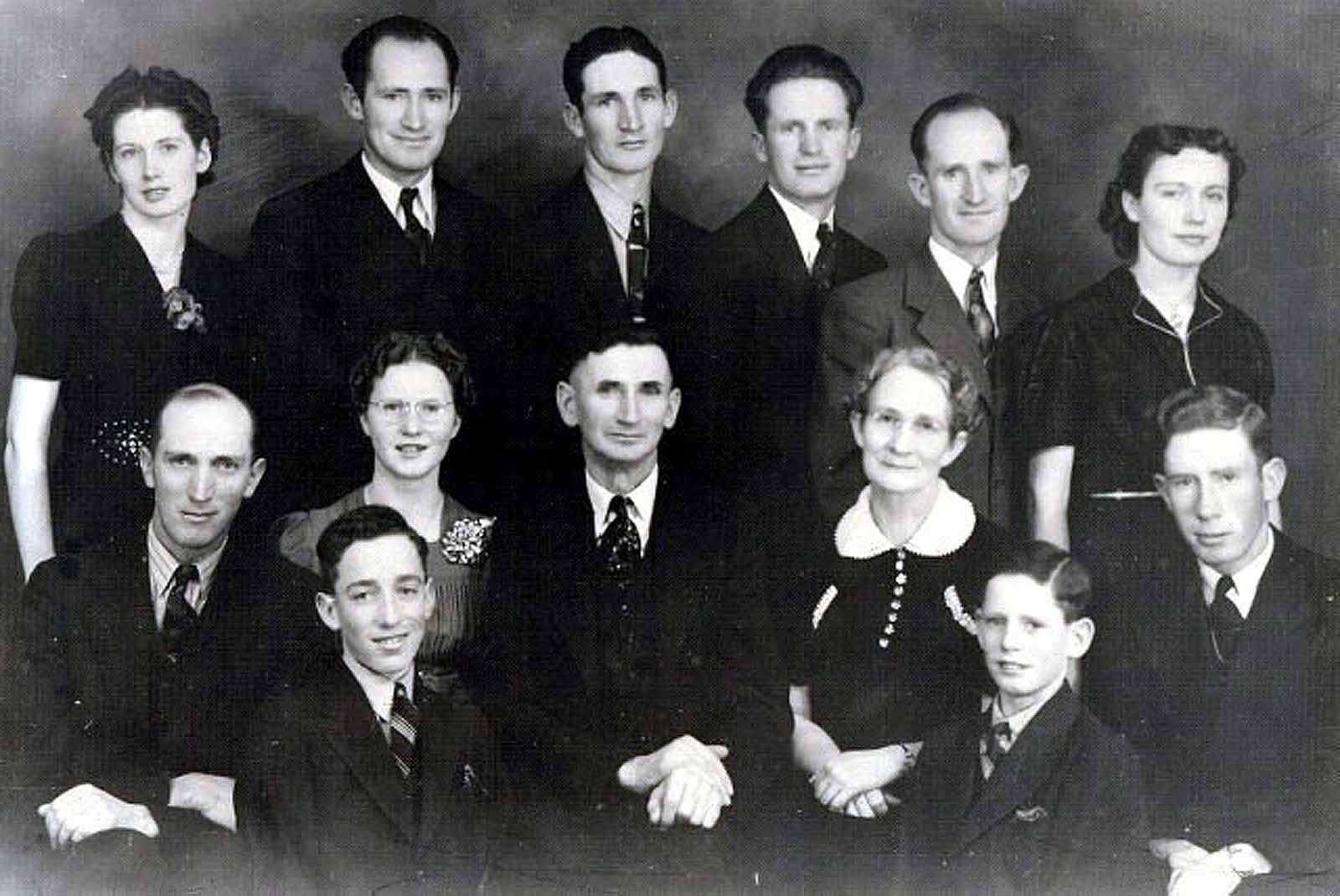 Front: Earl and Verl, Middle: Roy, Marie (Green), Thomas, Hettie, George, Back:
Afton (Hatch), Fred, Hyrum, Alma, Loyn and Merintha (Garner)
Front: Earl and Verl, Middle: Roy, Marie (Green), Thomas, Hettie, George, Back:
Afton (Hatch), Fred, Hyrum, Alma, Loyn and Merintha (Garner)
To Verl, a favorite brother: Verl was drafted into the armed services when little or no attention was given to health qualifications. Vertebrae problems have followed him all his life and the period of basic training caused a total breakdown from which he has never been able to fully recover, despite weeks and months in and out of veteran hospitals. Being of such a nature that he cannot be idle, he found work with the railroad and got along reasonably well for a few years, but, despite consideration on their part, he reached the point where he could not continue.
Verl married Doris Evans Moon, who had a few small children and a son, William, was born to this union. After three or four years she sought for and was given a divorce. Verl purchased a comfortable trailer home and has resided there ever since and is located near Paul, Idaho. Son, William, who is now 20 and unmarried, has stayed close to his father thru the years. Still industrious and very independent, Verl has as large a clientele as he wishes for the care of flower gardens, shrubbery, painting and other light yard work, particularly, during the spring, summer and fall seasons.
And on to the Thomas and Hettie youngest: Marie, the only red-headed girl, but accompanied by three of us boys. The Lord gave the best he had to the few. Marie married Derald Green, a son of the then stake president. Marie and Derald, likewise, have a family of musical talent - two boys, a girl and two boys and a girl again. All married with families excepting Donna who is a high school senior.
Derald and Marie started on a farm and still own it, but he has served as a rural mail carrier for many years. Several years ago they moved to Burley where they have a nice home.
The Thomas and Hettie Blacker family has stayed close to the Church. They had three sons serve what we classify as foreign missions as well as two daughters-in-law. They have had 18 grandchildren serve missions and of these 9 of their spouses have likewise served and the great-grandchildren coming of age with 7 of them already have or are serving. Included in the above figures were 'couple' missions by LeRoy and Hilda to the Canada Toronto mission and Loyn and Mabel to the England Leeds mission. Conservatively figuring the time spent on these combined - all foreign missions totals 79 years. Numerous stake missions are not included.
No attempt has been made to seek this same data from the other branches of the Edward and Althera families, however, it is well known that a great deal of missionary work has been done. A grand total would become amazing!
Aunt Maria's turn: She was the fifth of the Edward Blacker family to leave the little and crowded log cabin, she becoming married to Brigham Delos Gardner on the 7th of April 1904. The following excerpt is from son Delos' history of his mother, which he presented to a family reunion several years ago - in 1966. His account starts at the time the family leaves Almy:
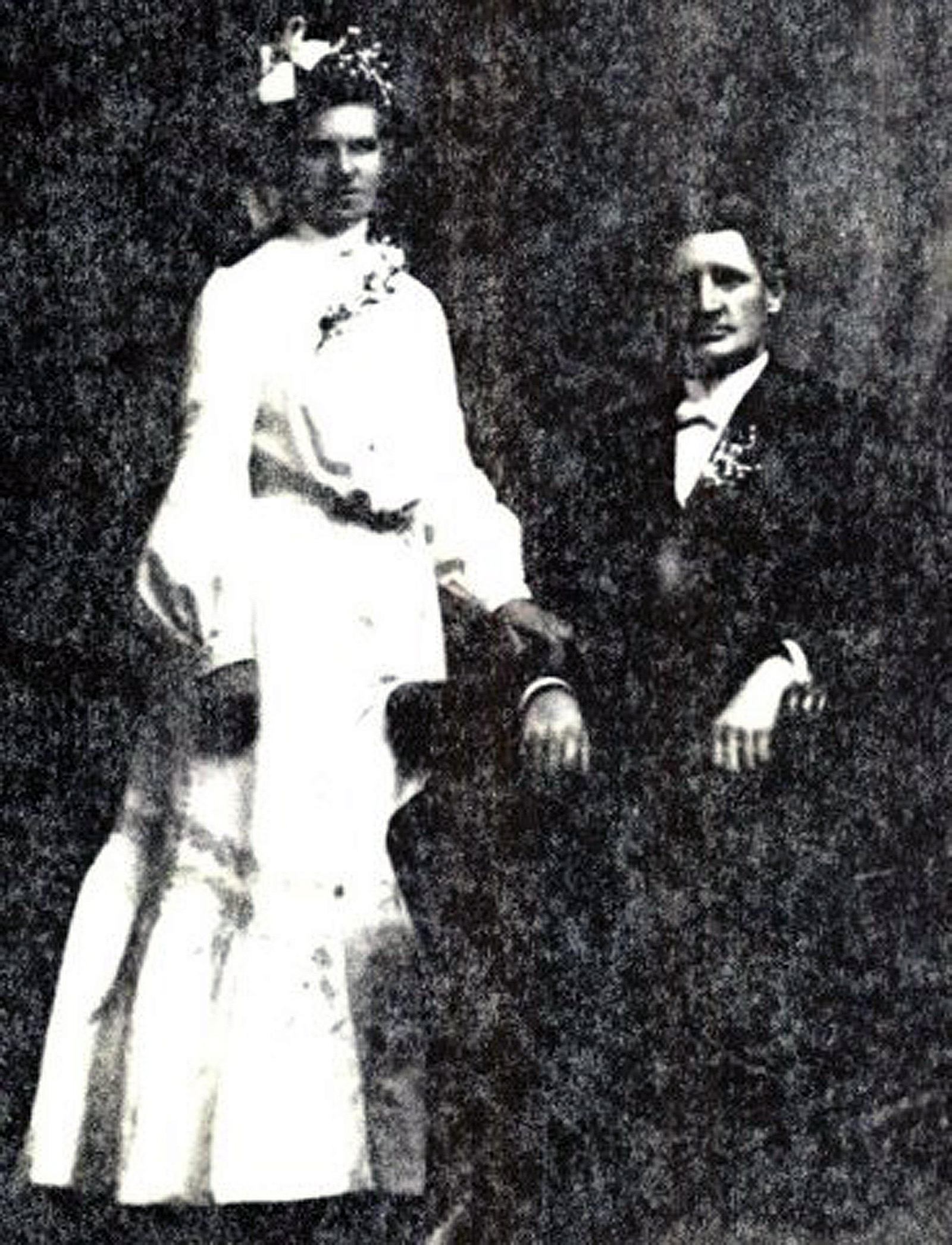
"Maria was the oldest girl at home at this time and she assumed her share of the housework. She had attended school in Almy to about the fourth grade and this was the extent of her schooling. She never attended school in Star Valley.
"Maria started working out at and early age and says she remembers crying at nights because she was homesick and wanted to be home. Her wage was $1.50 per week plus her board and room. She was a fast worker, a good cook, pleasant and willing and was much sought after to do house work though out the Valley. She had a beautiful soprano voice and can remember, as a young girl, singing in the choir and assisting with programs in church and in the community.
"Mother first remembered Brig (Brigham) Gardner as quite a roust-a-bout. She says that when Brig and his crowd came into a dance the folk held their breath and figured things would soon start popping and they generally did. However, they met and went together once before he went on his mission, corresponded once or twice in the two years that he was gone and both were anxious to see each other when he returned in 1903. The courtship began and on April 7, 1904, Maria again became 'Queen for a Day' when she and Brigham D. Gardner were married in the Salt Lake Temple. Mama tells of the trip to Salt Lake. They traveled by sleigh to Montpelier, Idaho (50 miles) and from there took the train to Salt Lake City. They stayed at West Jordan with the Gardners. Mama admits she was a little afraid and was timid about their teasing, but the 'Queen' in her coy, lovely way and with her pleasant, witty disposition assumed her role.
"The couple set up housekeeping in a small one-roomed house just north of the Blacker place. (Probably the same house Thomas and Hettie had first used the year previous. L.B.) If her days had been busy ones before her marriage, they really started humming now. Her first child was born January 13, 1905 and her 13th was born on May 14, 1925. Thirteen children in twenty years! There were seven girls and six boys. Harold Edward died on November 30, 1910 of pneumonia when but 3 1/2 months old. Grandpa Edward Blacker had passed away just three days before, on November 27, 1920 at the age of 59. A joint funeral was held and they were buried near each other at Afton, Wyoming.
"Mother has ever been a homemaker. She assisted Father in the building of a lovely, spacious new home in 1915 on the old place north of Afton. (Their home was on the Afton-Grover road 1 3/4 miles north of Afton on the east side of the road and at the point the road takes off to the west toward the first Blacker home situated one mile west of that point). The family moved to Rupert in 1921 where Maxine was born in August. The family moved back to star Valley in the fall of 1922 (into the same house they left). Until I, (Delos) was married in 1928 this family of twelve living children lived together with their parents under trying and humbling circumstances.
"Father's health had started failing but through it all, this wonderful mother played her part well. The last few years of Father's life mother was always at his side lending aid and comfort that was so badly needed. Father passed away on July 23, 1936. Within a period of a little over 12 years children had all married and mother had assisted in establishing 12 new homes giving aid and assistance as needed.
"For the past 20 years (this account was read by Delos in 1965) she has had her home in Afton and spends the winters, generally, in Utah with her children who live there, but is always happy to return to her own home. (At the 1965 family reunion Delos reported that, at that time, Uncle Brig and Aunt Maria could boast of 68 grandchildren and 32 great-grandchildren.
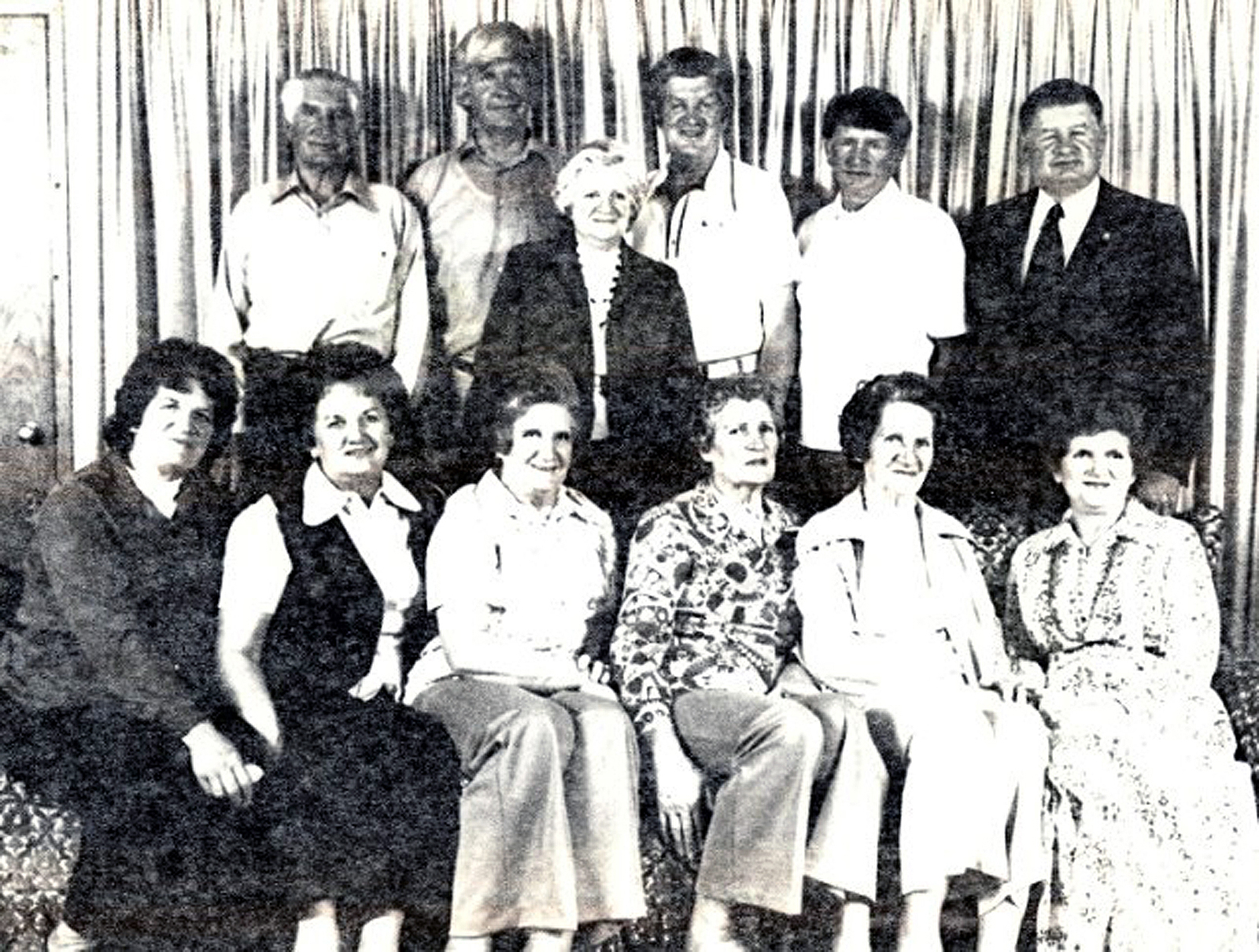 Gardner brothers and sisters about 1976. Back, Delos, Vern, Kenneth, Darrel,
Lincoln. Middle Elna. Front, Genevieve, Maxine, Dorothy, Marguerite, Allie,
Cumorah
Gardner brothers and sisters about 1976. Back, Delos, Vern, Kenneth, Darrel,
Lincoln. Middle Elna. Front, Genevieve, Maxine, Dorothy, Marguerite, Allie,
Cumorah
Perhaps this compiler of this particular family history can do no better than to quote a Salt Lake Tribune story of the boys of the Gardner family which was written by a professional sports writer, Bill Coltrin, for his Sunday's contribution for 8 Feb 1970. Twelve years have passed since this article was published and no attempt will be made here to supplement the described activities with that which has transpired since that date to the end of 1982 - the final date of this Blacker history. Certainly the five family represented by the boys of the family plus the seven families represented by the girls of the family, will have already completed this story and it all will be found in the 12 family histories resulting therefore.
This news article is the titled: "Gardners Like Work, Sports and Each Other". A prelude declares the objective, 'The Family That Plays Together - They all believe in their religion and in hard work, play and study. They take pride in belonging to this kind of family'. It may be suggested that the reader refer to the family chart commencing on page 240. The news article starts -
Everyone knows that Kenny Gardner is a star basketball player for the University of Utah.
But did you know that a cousin, Greg Gardner is on the Ute frosh team? That cousin Mike Gardner is head coach at Davis High School? That cousin Joel Gardner is head coach at Spanish Fork? That cousin Gary Gardner is head coach at Tooele High School?
That three more cousins, Scott Gardner, Terry Gardner and Mark Gardner are on the Clearfield High School team?
That ex-basketball playing cousins, Delworth Gardner and Harold Gardner are doctors? That ex-basketball playing cousin, Kem is an attorney?
And very few know that Kenny's little brother, Steven, is in the 7th grade at North Davis Junior High School and is as 'rough' as they come"?
All of this became possible when five brothers, who with seven sisters were raised on a 60 acre farm in Star Valley, Wyoming, migrated to Utah and settled in the Clearfield area.
Now a 60 acre farm is not exactly a gold mine, but all of the five brothers went to college, all are wonderful citizens, and all can be proud of the way they've raised their sons and daughters.
There are a lot of sons and daughters - when the mother of the five brothers died two years ago she could county 67 grandchildren; that is the she could count them if she could get the boy grandchildren in off the basketball court long enough to stand up and be counted.
The five brothers who came down from Star Valley are Delos, Lincoln, Kenneth, Darrell and Vern, known all over the nation back in the 1940s as Big Vern, All American basketball player of the University of Utah.
And now, to end the confusion here are the sons of the five brothers - Dr. Delworth, Dr. Harold and Joel are sons of Delos. They played their high school ball in Wyoming where Harold was all state as a prepster for two years and playing for the University of Wyoming.
Joel was an all-stater, came to BYU where a leg injury slowed him down and he is now coaching at Spanish Fork.
Lincoln's sons are Gary, the Tooele coach who played on the Weber Junior College team which went to the national finals. He also was all-state at Davis; Kem, now the lawyer, who played at Davis and is still playing M-Men ball.
Then there's Danny, who played everything at Clearfield and won the state high jumping crown; Greg was an all around star, best in basketball and baseball at Clearfield, now a Ute Frosh; Phil is on an LDS mission on the east coast.
Scott is a senior, playing for Clearfield and Rulon is playing on the 8th grade team at North Davis Junior High.
Kenneth's sons are Kenny, the great Ute cager who was Mr. Everything at Clearfield a few years ago; Terry, on the Clearfield team this winter and Steven, the rough and ready seventh grader.
Darrel's sons include Mike, now coaching at Davis, who had a great athletic career at Davis high school, all-state in both football and basketball. He was a three-year regular for Brigham Young University. Mark, a junior on the Clearfield squad this winter, is Mike's brother.
Vern's best cager is Allen, who plays 9th grade basketball even though he is only in the 8th grade and he has three brothers, Vernie, Fred and Shane. Shane is still in kindergarten, and even for a Gardner that is a little young for a basketball player.
So that's the list of the sons of the five migrants from Wyoming. They have been fine students and athletes in basketball, football, baseball and track and field.
Aside from Vern, their fathers all were best known as boxers. Darrel even fought professionally and pretty good, too. Linc was an Intermountain AAU champion and so was Ken.
Linc's battles with his friend and fellow BYU student, Jack Stringham, are among the fabled fights in Utah amateur history.
The fighting fathers discouraged their youngsters from boxing and in between the homes of Darrel and Linc in West Point, there is a basketball court, lighted of course, so the kids could play late at night.
Here it was that the sons started playing - after they had done their chores around the 'farm'. With the big families and the farming background in Wyoming it is natural that the Gardners raise a lot of their own food.
Work is an important thing in the lives of the Gardners and no one could accuse them of being lazy. In Clearfield, a couple of service stations and a drive-in hamburger stand keep the kids busy when they are not playing some sport.
They may have been great heroes in high school and in college but on Saturdays and during the summer they were greasing cars or frying hamburgers in Clearfield.
On the other hand, the businesses had to sort of take care of themselves when a game was or is on involving one of the kids. All of the Gardner tribe go to all of the games. Darrel recalls missing only one game while Mike was at BYU and Kenneth has missed seeing Kenny play at Utah only once. He had a fair excuse - he was in the hospital.
So the next time someone tells you that it isn't possible to pull yourself up by your bootstraps, tell them the story of the Gardners.
They all went to college, but they worked their way through. Vadal Peterson, who coached Vern in college, says that all Vern got was a job - he didn't have the so-called full ride, but he was All America.
All of these five fathers have held more than one job at a time to keep the family going. If you are waiting to hear anyone of them complain, forget it.
And what is their secret for raising fine families? They believe in their religion, hard work, hard play, hard studying, good personal habits and the pride of being a member of a fine family.
Gals, you must appreciate that to keep this yarn on one page of the Tribune, the story had to be confined to your brothers and their offspring. But after talking to the brothers for some hours, one thing is certain - they think you're great.
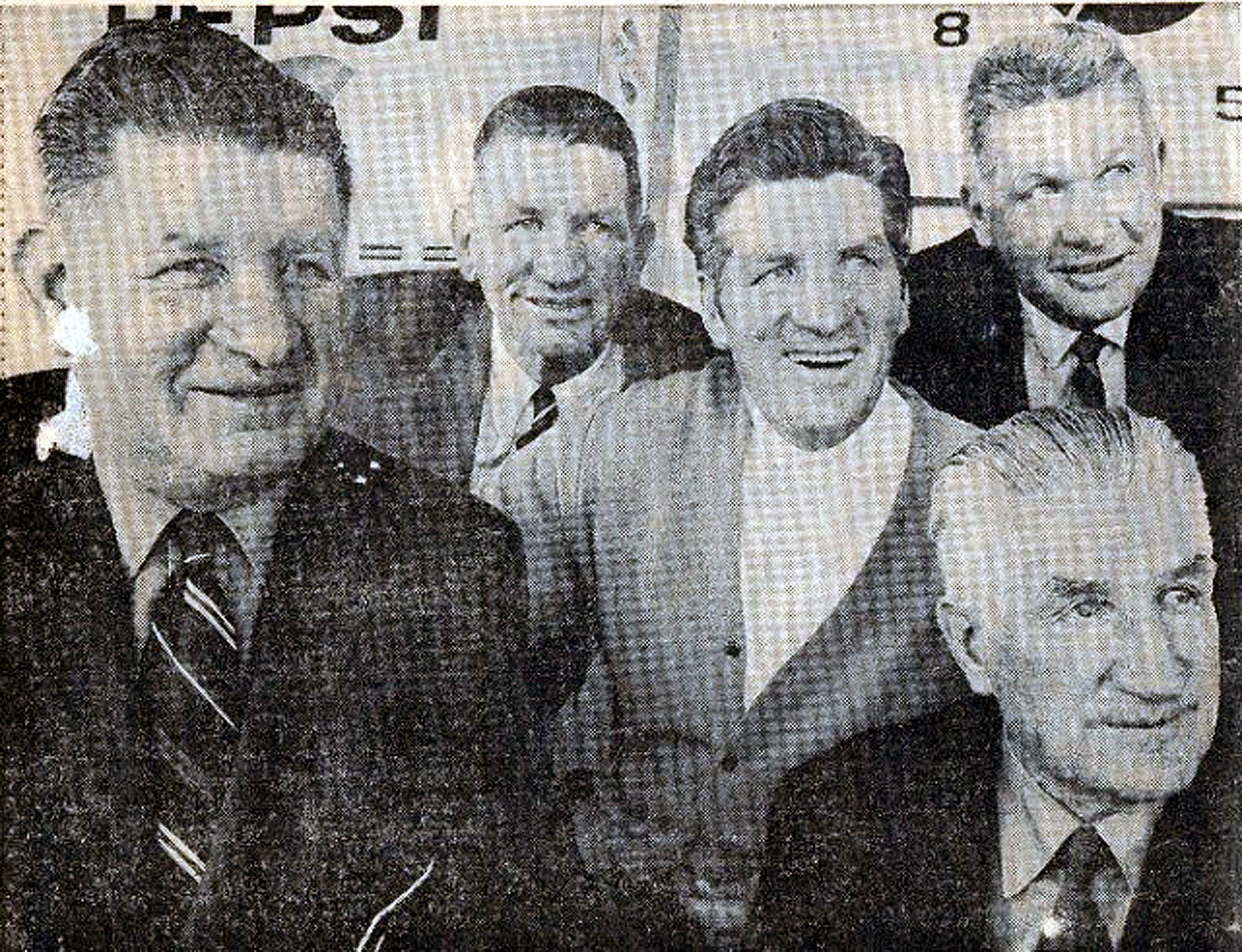
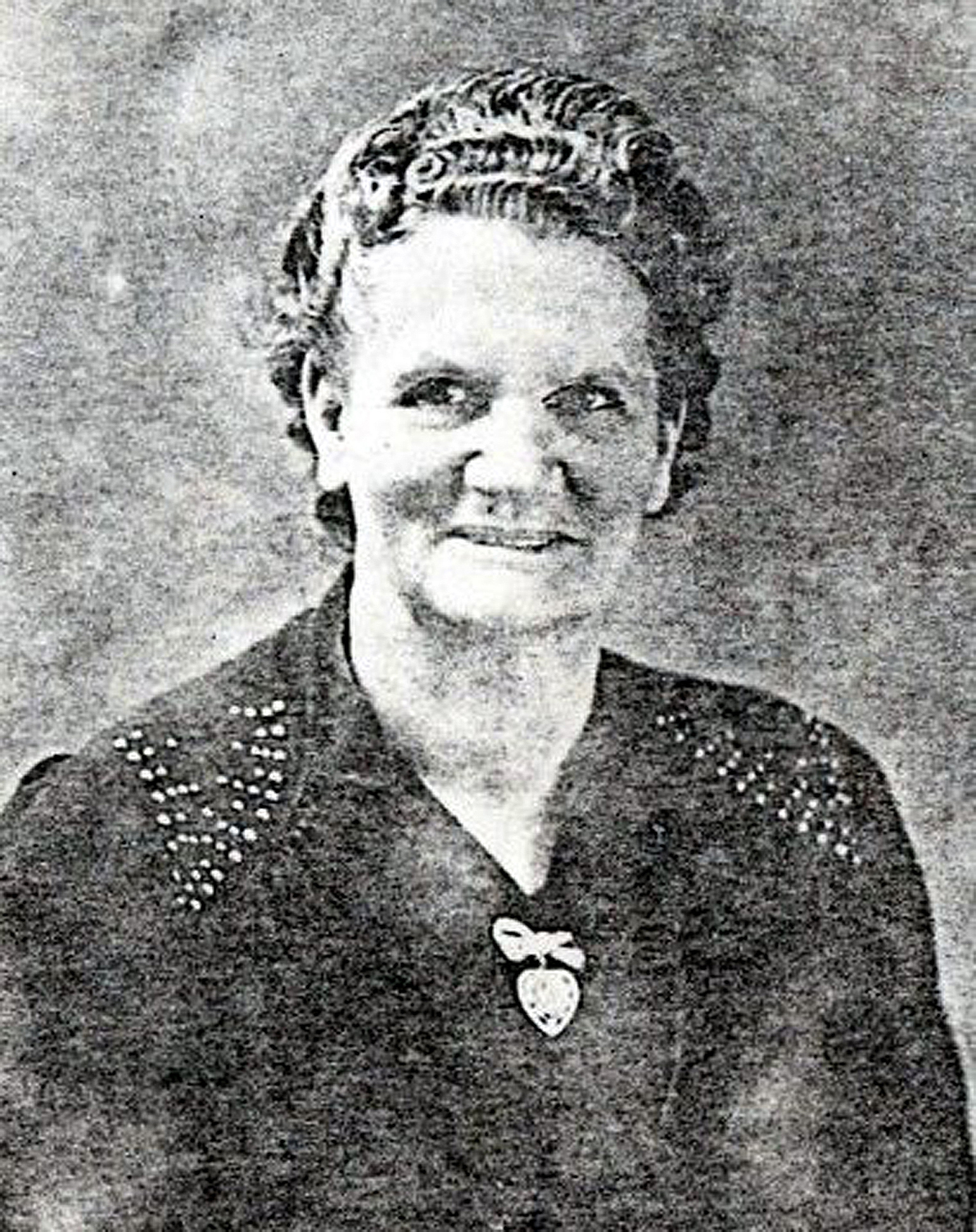
And so ends a family story as seen thru the eyes of a professional sports writer. After all, it seems the most important theme of the printed dissertation was 'family togetherness'. Win or lose, the family-member participant always became the family hero and with such sideliner fans how can any boy or girl feel neglected to the point that he or she would not have the will to do his or her best.
The girls of the family were as equally endowed as have been the boys. Were their story told it would be just as amazing as the story of the boys, perhaps more so. What an achievement it would be were one of their number, perhaps a son or a daughter or a grandchild, compile the experiences of each of these daughters of this particular family and let each, in turn, become the topic or subject of a chapter and combine the seven under the title of "The Seven Sisters".
May it be suggested that the reader turn to the family charts to assist in determining the accomplishments of the daughters and daughters-in-law - co-creators with God, and as one great man has said, "The greatest good one will ever do will be within the walls of his or her own home."
Church and church activity has been the importance to all in the Gardner family. The full story is not in the hands of this writer, but mention should be made of the many years Delos served in the Star Valley stake presidency before he moved to Utah. He and Lorean were called to serve a two year mission in Australia. Approximately six months prior to the regular release time, his mother, Aunt Maria, passed away and the missionaries were permitted to return home for the funeral and were assigned to Indiana to later complete their two year assignment. Their final release came in 1968.
Lincoln and Phyllis were called to serve an 18 month mission in New Zealand in the spring of 1981 and were released and returned home just prior to the 1982 Christmas season. A few years prior to their mission, Lincoln was released as a counselor in the stake presidency and called as a stake patriarch - this two or three years prior to their mission call. Naturally, he was not released as a patriarch when called to their mission, but still retains that assignment.
Daughter, Cumorah, was called to serve a mission and, at the close of 1982 at this writing, she is still servicing in the Washington, D.C. temple.
In 1933, daughter Allie married Hillary Hyde and to them have been born two sons and two daughters. Their home has continuously been in Afton where, for many, many years, Allie taught school until her retirement. Hillary has farmed and has been employed in Afton until, also, his retirement.
The other girls of the family have served as secretaries and general office work in Utah and at Hill Field, such as Marguerite. Dorothy has been a nurse most of her adult life both in Afton and the Veteran's Hospital in Salt Lake. Elna, likewise, has raised a family and has been a school teacher. Cumora was a long time high school teacher of English and Speech in Clearfield and, like her sisters, has raised a family. Maxine has specialized in secretarial and office work and Genevieve is a long time employee of Hill Field. Vern, the youngest son, has been known as "Big Vern". He followed school teaching and is currently teaching math in Bonneville High School in Ogden. Also, he has spent considerable time coaching. We must not overlook mentioning that Lincoln is a former school teacher, having taught in the Big Horn area in Wyoming. He, as with most of his sisters, taught in Afton at one time or another.
It should be noted that the Gardner Brothers' enterprise with the Big Vern oil stations was eventually purchased by Vern and JoAnne and family. This transaction took place during the early 1970s.
Now we will turn to the next in line of the children of Edward and Althera, Uncle Will.
With the previous accounts of these children, the accounts generally commenced with their marriage. As the reader will recall, we have had a taped interview with Uncle Will and some of his pre-marriage history should be related prior to our account of him after he married. At this point we will intercept the account where he is relating of the construction of the new home on his parent's farm in Afton, this, following the passing of his father, and several years following the last two marriages of the family, Tom's and Maria's. We had just left him telling of the deaths of Grandpa Loveday and Grandpa Blacker, both from the old log house. and both in the year 1910. The initials, "L" for Loyn, and "UW for Uncle Will are the same as when we were transcribing his tape earlier.
L: That was in 1910 when they passed away?
UW: Yes, in the fall of 1911, I went down to Willow Creek canyon and I cut saw logs and in the winter would go down with the sleighs and haul them back. I had met Ella during this time and I was engaged to her to be married. Instead of building a house for her I got this timber out and built a house for Mother.
L: That would be the present house standing there now? Of course even that is an old house now.
UW: It's an old house now, but it was a nice house when it was built.
L: Yes, I remember when the house was new, before it was finished. It was a nice house.
UW: I remember when we were up there logging - there were seven of us up there. We were pretty near through hauling our logs down to Turner's mill down in Turnerville. We had a big snowstorm and it happened this night - we used to go up on the side of the hill where the logs were piled and we would take a log down to the mill in the morning. We would return and load up in the evening and would drive out to the point of the hill where we would leave our sleighs. We had out camp back in the canyon, up where the spring was. This particular night it snowed and snowed and I had a dream. I dreamed that I was in a snow slide. It was so real that when I came to I was out of my tent outside.
L: You scrambled away from the imaginary danger.
UW: Yes, I was, maybe a block away from the other camps because I had been up there with Elias Michaelson (a neighbor) who had got thru with his logs and he had left for home. I woke up and went up and woke the other fellows up - it was four o'clock in the morning and I told them that I thought we out to get out of there for I dreamed that I was in the snowslide. Skinner (the leader of the crew from the Lower Valley) was what you would call a 'jack-Mormon' and he swore at me and he said, "You Mormon - censured - go back to bed".
Well, I went back to bed and in a few minutes he hollered down to me and said, "Blacker, we'll take you at your word and we will get ready now and hitch up and take the logs down. I'll have one of my boys stay here in camp and he will have breakfast for all of us by the time we get back", so we harnessed up the horses and got out on the point of the hill. All this snow had come and we just couldn't get our loads started because of the depth of the snow and the loads were heavy. It happened that, at this time, Skinner had two outfits, one of his sleighs on the lead and the other behind our loads. The rest of us were in between, so we decided that he should take his team off the rear load and put on the first sleigh with the other team and break a road for us.
Well, they finally got started and we got down about a quarter of a mile or a half mile below where we made a turn in the canyon and a snow slide came right in behind us. We just got around this bend and a big wind came and hurled snow until we couldn't breathe. We all stopped and got down by the side of our sleights. Skinner said we might as well go back, 'the slide is in now'.
When we went back we saw that every tree, every piece of timber was all gone. Skinner's last sleight which was left behind was found the next summer in little bits of pieces. My tent was just knocked down, but it hadn't been moved. The edge of the slide had just touched the edge of the tent. If we hadn't gotten out early or, if we had waited until breakfast and had been out on the point of that hill, none of us would have lived through it. There wasn't a thing left - it just took everything.
L: What a remarkable manifestation that came in the form of a dream!
UW: Yes, and several years afterwards, after I had left Star Valley and went back on a visit, I met Skinner and he told me - he came up and shook my hand and put his arm around me and said, "Will, I have often thought about your dream and if we hadn't have done it, we wouldn't have been here today".
L: What an interesting experience. I haven't heard you tell it before.
UW: I have never told it too much. You know it says that "Old men would dream dreams and young men visions". If it hadn't have been for that dream we would not have been here now. Now, to go on - I got enough logs out for lumber and the next summer we built Mother's house.
In 1913 I got married - on January 23rd, and we lived in part of Mother's house.
L: This was in the new house?
UW: Yes, until I bought the forty acres - the old Anderson place.
L: You and Uncle Hyrum had been running the farm on the old place?
UW: Yes, Hyrum was not too well, for he had a bad heart.
L: You were married in Logan?
UW: In Salt Lake on the 23rd of January.
L: You picked the winter time. UW: Yes, Archeso Corsi drove us out the morning we went out.
L: You went to Montpelier and then took the train?
UW: Yes, we went from there on a train. We stayed in Montpelier all night.
At this point in the interview Uncle Will gave a little history of Aunt Ella and her girlhood - that she had lived with Aunt Luella Wilkes - no relation - from the time she was about twelve until they were married. After missing some of the interview we here return agin to the interview to the subject of early Star Valley.
L: As the Edward Blacker children were growing up: Afton had grown from a little town - of course Afton has always been a little town - but it certainly increased for people moved into the Valley and it developed during these years. About your early social life and activities - were they handled by the church? Of course, there was the Afton ward.
UW: All we knew at that time was home parties and dances because we didn't have movies. Maybe once in a while there would be a traveling troupe come in such as Tom Cutler had a dramatic troupe which traveled around the country and they used to come over to Star Valley once in a while in the winter time. That's all we knew excepting some home talent once in a while. Practically all we did was dance.
It would have had to have been during the last of 1917 or early in 1918 that Uncle Will and family moved from Star Valley to Paul, Idaho, where they partnershipped a farming season with Aunt Luella Wilkes and son, Edgar. By the next year, the summer of 1919, they had contracted for the purchase of a farm in the Big Bend district south of Rupert some four to five miles. There they farmed for a couple years when the severe depression of 1920-21 became a catastrophe to farmers due to rapid price decline of farm produce, which wrought havoc with the more recent purchasers of farm property. This not only affected Uncle Will but also his brother, Thomas, who in the fall of 1919, purchased a farm in Rupert as previously described, and, also, Uncle Will's brother-in-law and sister and family, the Brig Gardners who had purchased a farm in Rupert in 1920. All three families lost their investments.
After losing his farm and all that he had, Uncle Will, fortunately, found employment with the railroad on the section. They moved to Heyburn into a railroad section house for a while and later into another residence which they leased.
Uncle Will's and Aunt Ella's first three sons, Roderick, Kem and Worth were born in Afton. Blair, Rowene and Arlo were born in the Rupert-Heyburn area. All six births were within the period from 23 June 1914 and the 11th of September of 1924.
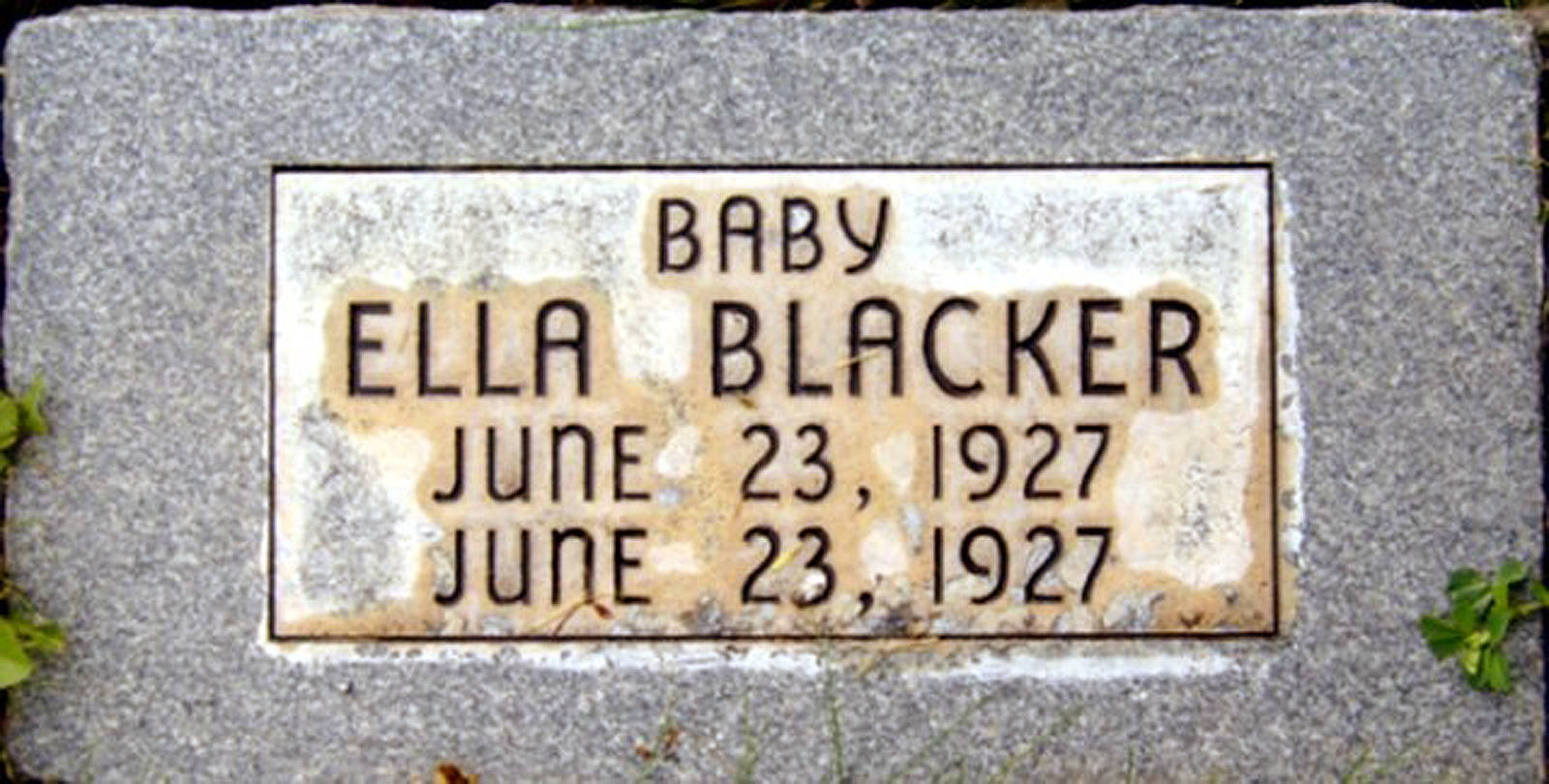 Will and Ella Blacker's daughter. Buried in the Heyburn, Idaho cemetery.
Will and Ella Blacker's daughter. Buried in the Heyburn, Idaho cemetery.
After three or four years on the section, Uncle Will and Aunt Ella concluded there were little prospects ahead for their family's future. Word reached them of prospects for work at the new Manache, Washington Dam. With three or four other men of the area, Uncle Will went up to find employment, which he did for a while, but ended up with employment on a canal project in Ellensburg. It was here that the family joined him, and it was from here that Roderick graduated from high school.
One dream they had always had, and especially Aunt Ella, was that their children were going to be given an opportunity for college. Considerable history could be written of their next move, this time, with Uncle Will remaining with his employment at Ellensburg. Aunt Ella and children went scouting for a home in a college town and ended up in Corvallis, Oregon, the home of Oregon State University.
For a year or more, Uncle Will continued with his employment in Washington for they were now into the 1930s and the great Depression had hit hard. The older boys were attending Washington State which was an agricultural college and each - Roderick and Kem - found part time jobs on campus. On one of Uncle Will's visits to his family, he found employment on the college farm. He took the job, but he then developed a problem with his feet, which, he reported, was related to rheumatism. This completely crippled him to the point he couldn't walk, except, at times, on crutches. This condition lasted for about three years.
In the mean-time, and soon after reaching Corvallis, enterprising Aunt Ella decided to take in boarders - students, boys only. First she provided mainly sleeping rooms, and soon thereafter, board and room. She soon got more business than she could handle, even with the help of the boys, so she did some hiring and later had an opportunity of getting hold of improved housing.
While attending college, Roderick and Kem joined a unit of the national guard and Kem graduated as a Second Lieutenant. Roderick graduated with a degree in forestry and made that his life's work. In the meantime, Uncle Will recovered from his foot disability, and obtained work for five or six years as a custodian at the college. Worth graduated with a degree in agriculture and made his life's work in that field. By the time Arlo and Blair finished school, World War II had started. Blair was but 20 when he completed the university and received his degree and loved flying. His one desire was to fly the big bombers overseas, but Uncle Sam had other work for him. He was assigned to an air-force base in Arizona as an instructor and it was on one of his flights in connection with that assignment, that his plane crashed. His body was brought to Corvallis where he was buried. He died 20 Jul 1942.
Kem made his career with the U.S. Military and was stationed in Hawaii at the time of the bombing of Pearl Harbor. He achieved positions of distinction during the military career, making several secret missions to the War Department in Washington D.C. He served in Australia and went up to New Guinea, Lai, and the Philippines with the title of Major Lieutenant Colonel. His assignment was with the most difficult of the U.S. invasions in that area of the Pacific and was he closely associated with General MacArthur.
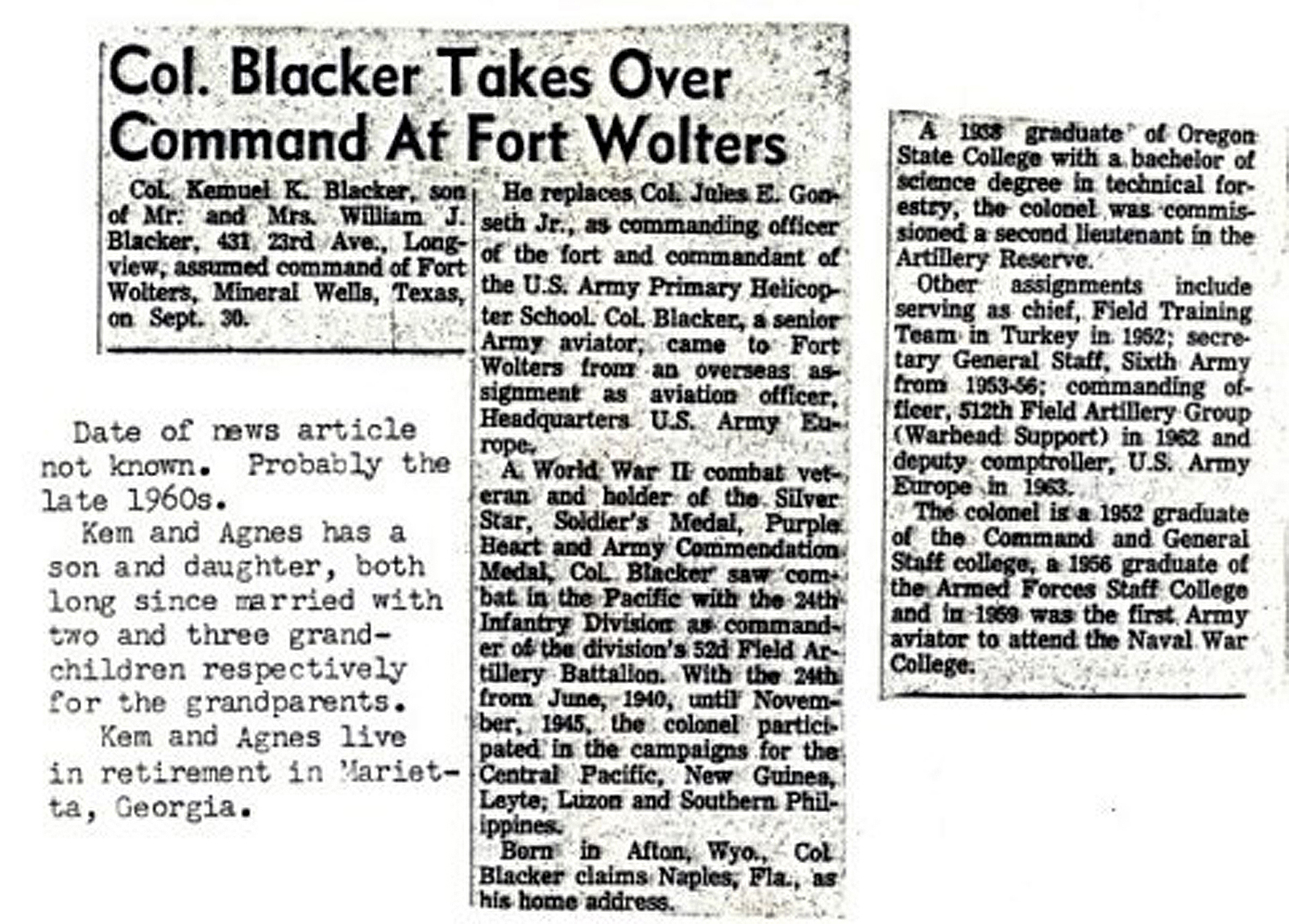
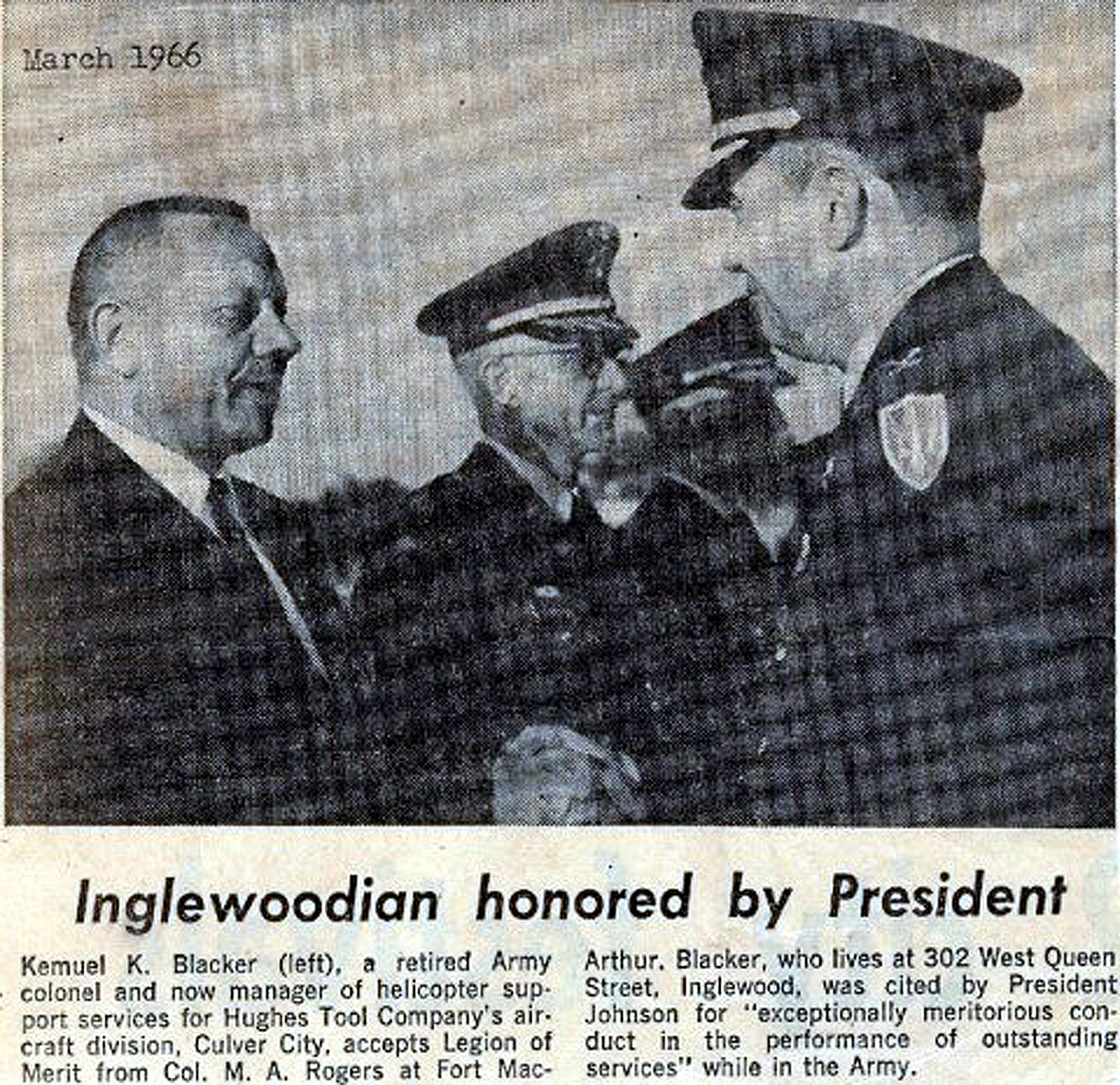
Rowean assisted her mother while they were in Corvallis, and undoubtedly attended school there. She married Lawrence (Bud) Amos on the 18th of February 1942 and had three children. Rowean and Bud lived in Long View, Washington, where he was employed in the timber related industries and it was here Uncle Will and Aunt Ella moved to make their home near Rowean in their last retirement.
It is with regrets that we report so little data on Arlo. He was born in Heyburn on the 11th of September of 1924. Undoubtedly, most of his schooling would have been in Corvallis. He married Irene Carroll, 30 September 1947, in New York City and was divorced in 1958. He remarried, this time to Avril Dunson in Ocean Beach, California. Arlo had no children, however, they adopted a boy and a girl, Rocky and Sherry.
Arlo also, followed the military and lived in the San Diego, California area for several years and was last transferred to the Island of Guam where he suffered a fatal heart attack and passed away on the 22nd of Oct. 1975.
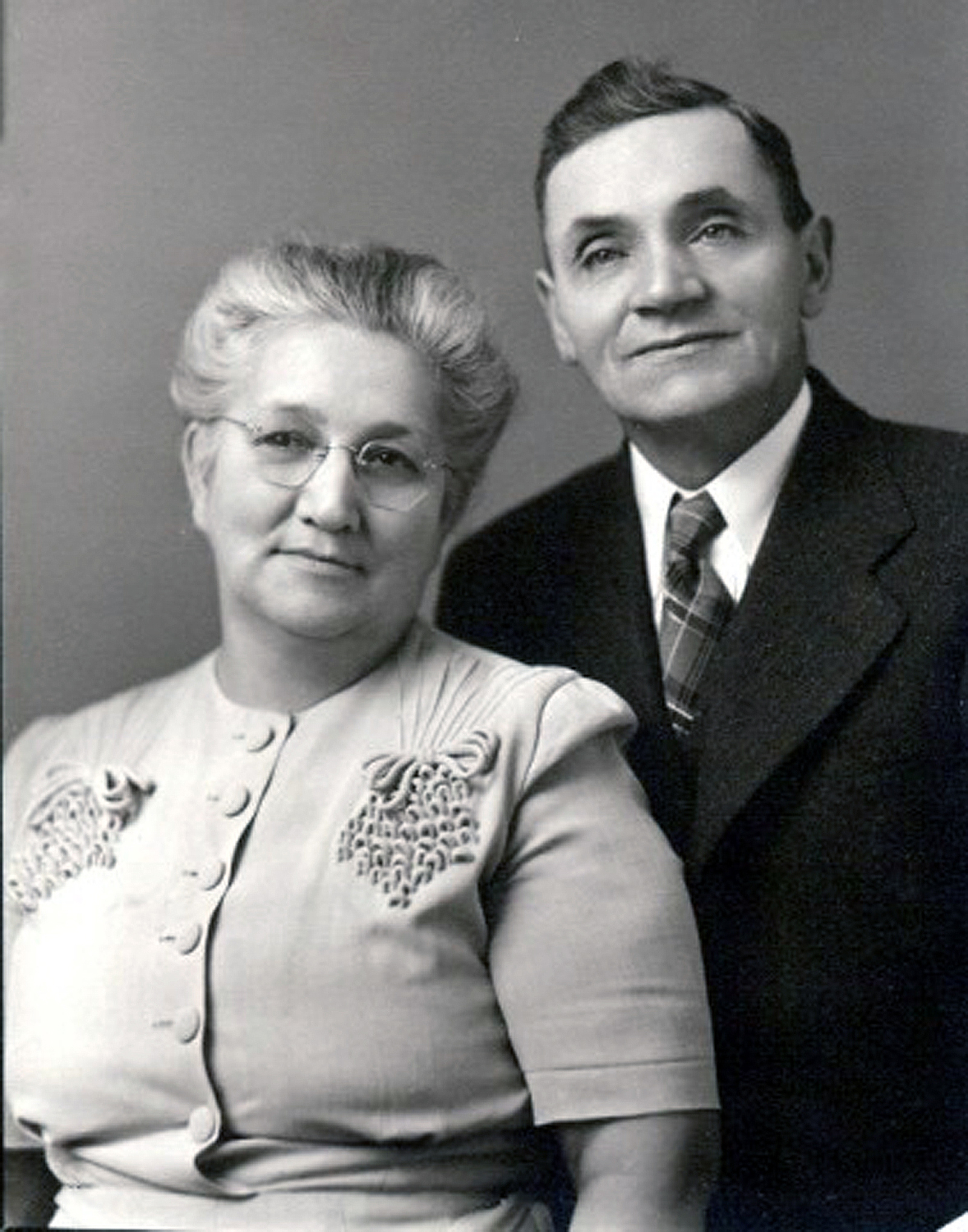
Following their family leaving home Uncle Will and Aunt Ella did considerable traveling from Alaska to Mexico and to most of the states within the U.S. Uncle Will claims they became known as the "Blacker Gypsies". They enjoyed this touring period of their years until in about the year 1950, when Roderick's wife, Martha, became seriously ill at their home in Durango, Colorado where Roderick's forestry work took them. Uncle Will and Aunt Ella sold their home in Corvallis and moved to Colorado to assist with Roderick's family. However, Martha passed away in 1950. Later circumstances took them to San Diego to be near Arlo and while there Uncle Will obtained employment at a military site as a janitor and Aunt Ella purchased and operated a small cafe for a few years, until such time as she was stricken by a stroke - partial at first but sufficiently severe that she had to retire. They then, returned to be closer to their daughter, Rowean, who, with her husband, Bud or Lawrence Amos and children, were living at Richland, Washington. Due to a transfer in Bud's work in the timber related industries, they moved to Longview, Washington located in the almost extreme southwestern part of the state just across the great Columbia River from Oregon.
Her health condition gradually deteriorating over the next few years, Aunt Ella passed away on the 18th of July 1970. For the next nearly eight years, Uncle Will lived alone. but under the watchful eye of his family. Quite regularly he made his pilgrimage to the annual reunion back in Wyoming, Utah or Idaho, as the case may have been.
He was never one to complain and even when his frail body became considerably stooped and his mobility became very much impaired, whenever inquiry was made of him as to how he felt he would invariably respond with his unique chuckle and turning his head upward for his eyes to look into the eyes of the inquirer, would again repeat what he always would say, "Fine, I'm just fine."
Seven additional weeks are all that he would have had to have to have reached his 92nd birthday but his literally worn-out physical body needed rest and so he succumbed on the 18th of February 1978 in Longview, Washington.
Both he and Aunt Ella were buried in Corvallis, Oregon in the plot they had previously arranged as their final resting place. The Edward Blacker family and descendants have never been the same since uncle Will's passing. The time came when he was not physically able to make the long trips to the reunions, and it seemed the family no longer retained the same incentive to meet. The enlarged Blacker family had scattered itself over several states, particularly western and cousins who knew each other had their own respective families. Second cousins - and sometimes first - did not know each other and seemingly failed to sense an obligation to maintain any type of family relationship, which their parents and grandparents had so hoped could be maintained.
For several years Uncle Will served as president of the Edward Blacker Family Organization. There has been no reunion by the overall family since. It is true, several branches of the family have organized and are holding regular annual reunions. Certainly this is good and most proper and, possible, sufficient. An old cliche has it that 'blood is thicker than water' which, perhaps, explains the natural interest for folk of the same 'roots' to keep in touch with each other. After all, we are what our ancestry made us and so each family is quite unique from another family. That which we have in common provides a natural inclination to family association and it is good.
Chronologically in the Edward Blacker home, Aunt Merintha follows Uncle Will, but she had married and left the family nest well over a year prior to her next older brother. Fortunately we have a copy of a brief history written by herself, Merintha Althera Blacker Williams, which was mailed to us by her son, Grant, in the early spring of 1965. A copy was originally included in a family letter of 1 May 1965, which was mailed to approximately 100 family member homes. We thanked Grant for the valued account and thank him again at this time. Aunt Merintha's account is as follows:
Merintha Althera Blacker Williams - born July 7th 1888 at Almy Wyoming. I went to school in Almy for just two years. During the years in school and prior to that time, I did a lot of singing at church, at school and at various other social functions.
My mother was a lovely seamstress and I can always remember the pretty dresses she made for me. When I was nine years old Father and Mother and the family moved from Almy to Afton, Wyoming and I lived there until I was married. Our first home in Afton was a very small two room adobe and I really don't know where Mother put all of us. There were Father, Mother, Tom, Maria, Will, Hyrum, Fannie and myself and later Kem was born. My mother always worked hard and her 'pet peeve' was cleanliness. She once said, "Never be ashamed of patches as long as your clothes are clean". We always had plenty to eat and we were taught to work and to enjoy our labor. We were all active in the Church. I sang in the ward choir and taught a class in Sunday School and, of course, I loved to dance - even though the music was sometimes terrible. Will and I won several prizes for our waltzing.
I met my George in Frontier, Wyoming. I was visiting my eldest sister, Sarah Ann, and her husband, Archie Nisbet who, at the time, were living in Sublette, Wyoming, about seven miles from Frontier. I was waiting for a stage coach to go to Sublette when along came a locomotive and a nice young man who was the engineer who asked me if I wanted to ride on the engine with him. So up I went into the cab with the young engineer and away we went to Sublette. In the mean time I learned that his name was George Williams.
That was the beginning of a long and true romance. The summer before we were married George went with me to Afton so my family could see what kind of a man I had 'fallen' in love with. I guess every one approved, as we were married in Afton at Mother's home on October 25th 1911. Bishop Osborne Lowe married us. When we were married, George did not belong to our Church.
(A personal excerpt, by her son, Grant, was written in his letter referred to the above, interrupting his mother's story. Speaking of his father long after his parents had married: "Dad, upon awakening each morning would make his coffee as Mother would not, as she did not believe this to be right. One morning the coffee pot had not been put on the stove and Mother wondered why. The reason: Dad had finally decided to become a Mormon. I don't know whether the conversion was due to his beliefs or whether he got tired of making his own coffee.) We again continue with Aunt Merintha's account:
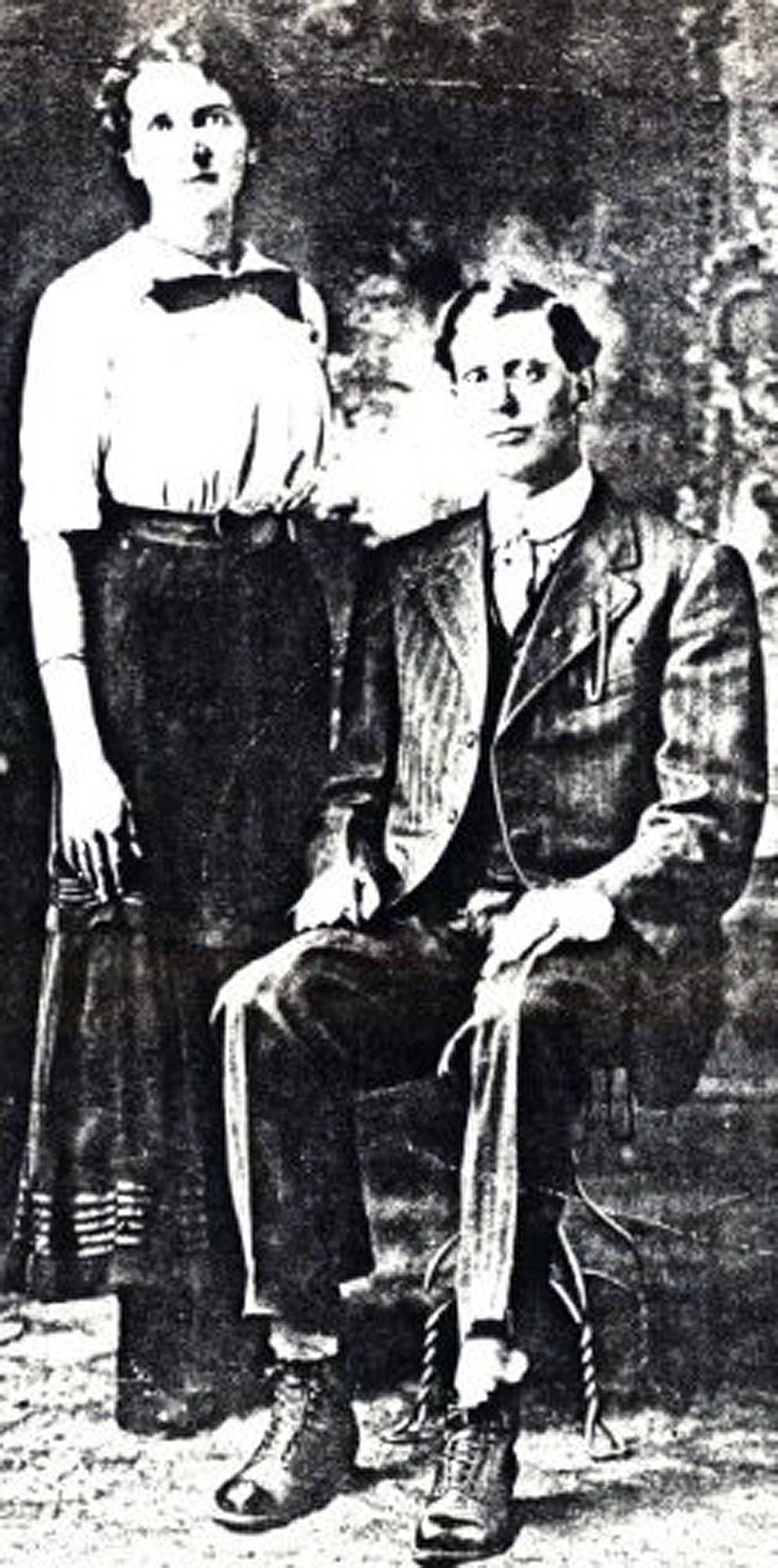
George Williams did become a member of the L.D.S. Church and was baptized by John McPhie on August 3rd 1918.
Richard Grant was born May 2nd 1913 and Ella was born August 6th, 1917. Our two children were born at Kemmerer, Wyoming.
George and I were both active in our ward. George was in the Sunday School and he was Ward Clerk for many years. I was president of the Primary in Kemmerer, later holding the same presidency in Salt Lake City. I taught boy's junior seminary and was the chorister in Sunday School. I have always been active in Relief Society work and was a counselor in this work.
We lived in Kemmerer for 21 years. Grant had finished high school and was in Salt Lake City attending the University of Utah. He was staying with Marie and Kem (Aunt Merintha's brother) but the winter of 1931-32 Kem became very sick and I went to Salt Lake to be with Marie from December until death took Kem on June 10th 1932. After the decease of Kem we decided to live in Salt Lake where George worked until he was pensioned at the age of 70. (A working life time with the railroad.)
Marie and her young son, Kay, lived with us and Ann was born November following the death of Kem. The morning Ann was born, George took Marie to the hospital and stayed there until the baby arrived. We certainly did love Marie and her two children - they were just like our own. Before Marie died she said to us, "Oh, Uncle George, you and Auntie have been so good to me and my children." (she used our names as the children had for years). Marie was a fine woman and was very good to George and me and I can't express how much we have missed her.
Ella's husband was killed in a car accident and she and her daughter, Ann Caldwell Cannon, came from Reno, where they had been living, to stay with us. George and I love those two girls, Ella and Ann, and our little great grand-daughter, Rebecca. During my long illness I can't express how wonderful Marie and her daughter Ann and son-in-law, Ron Astle, were to me and the great help they were to my George.
Grant had left the fold early and after receiving his doctor's degree decided to remain in California. Although we see little of him we hear from him about once a week and he has a fine family and really don't know how people get along who don't have children.
On the 25th of October George and I celebrated our 53rd wedding anniversary. (This anniversary was in the year 1964). How I prize those years we have spent together. What a blessing it is to have your sweetheart for so many years. George has taken such good care of me throughout our lives that I wonder how I could ever go on without him.
Living in Salt Lake since 1932 has given us a chance to make an abundance of good and true friends. Even though we are now growing old (she was 78 and he was 84) I cannot but feel that my life with George and my family has been full and beautiful.
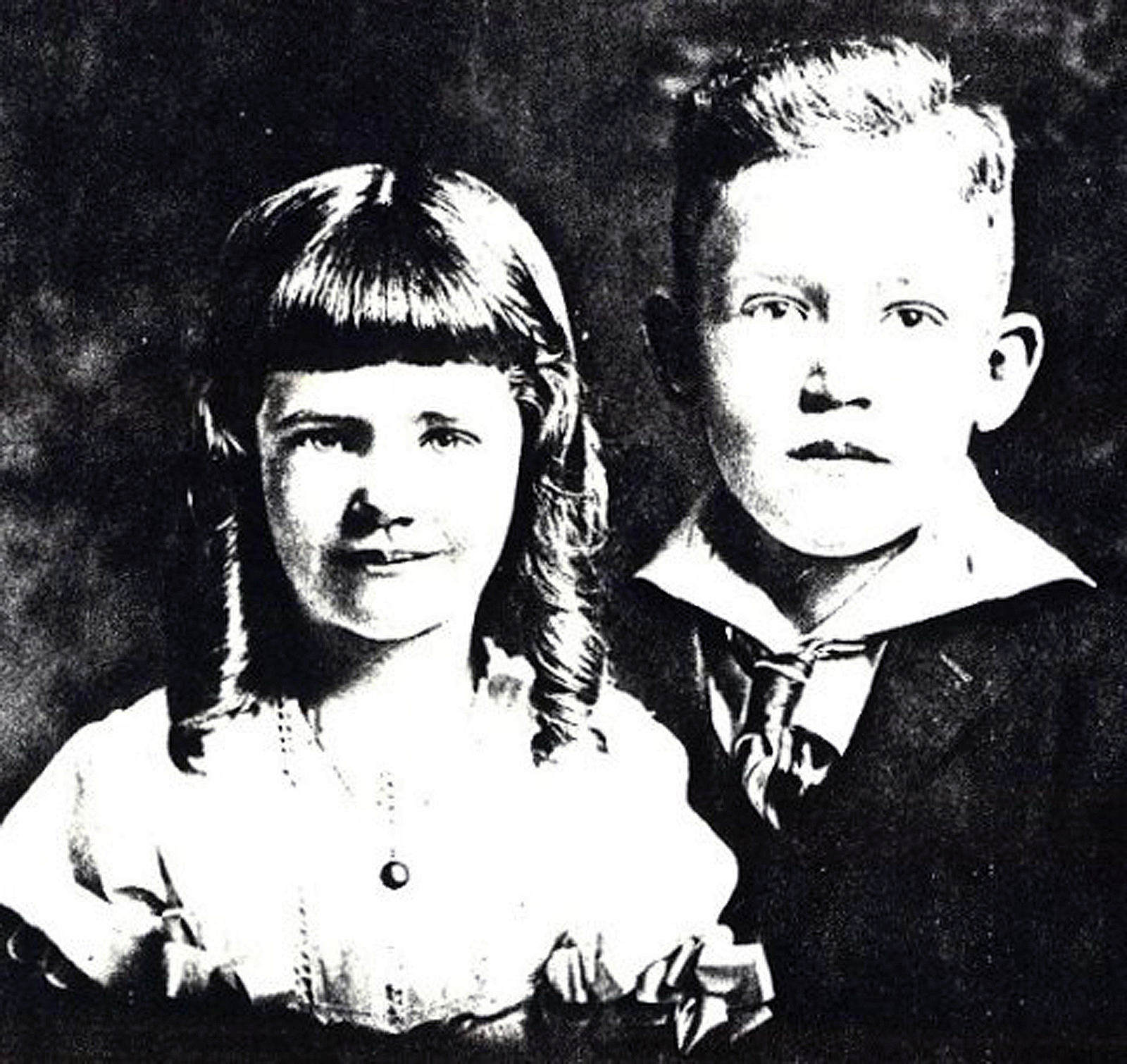
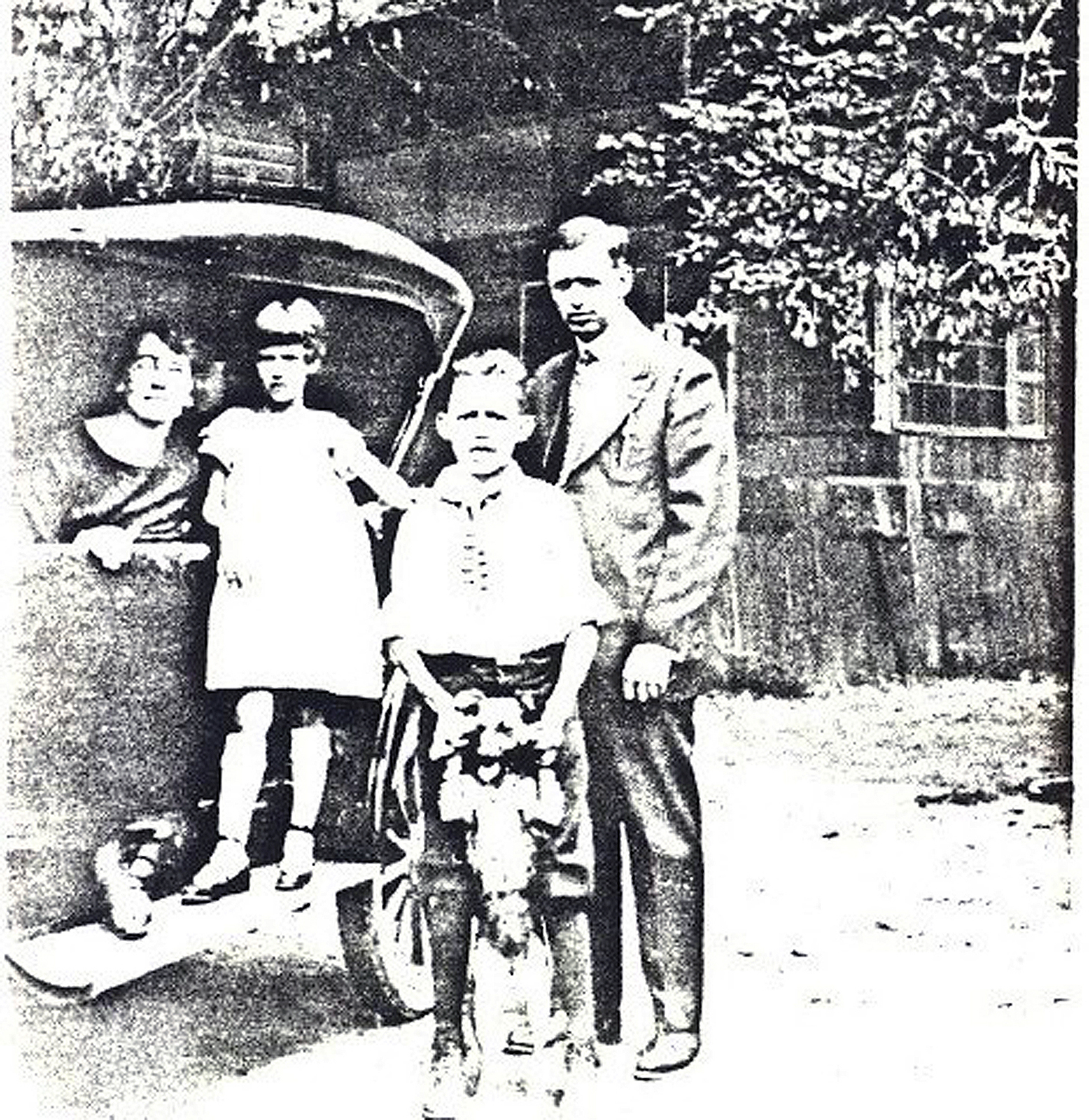
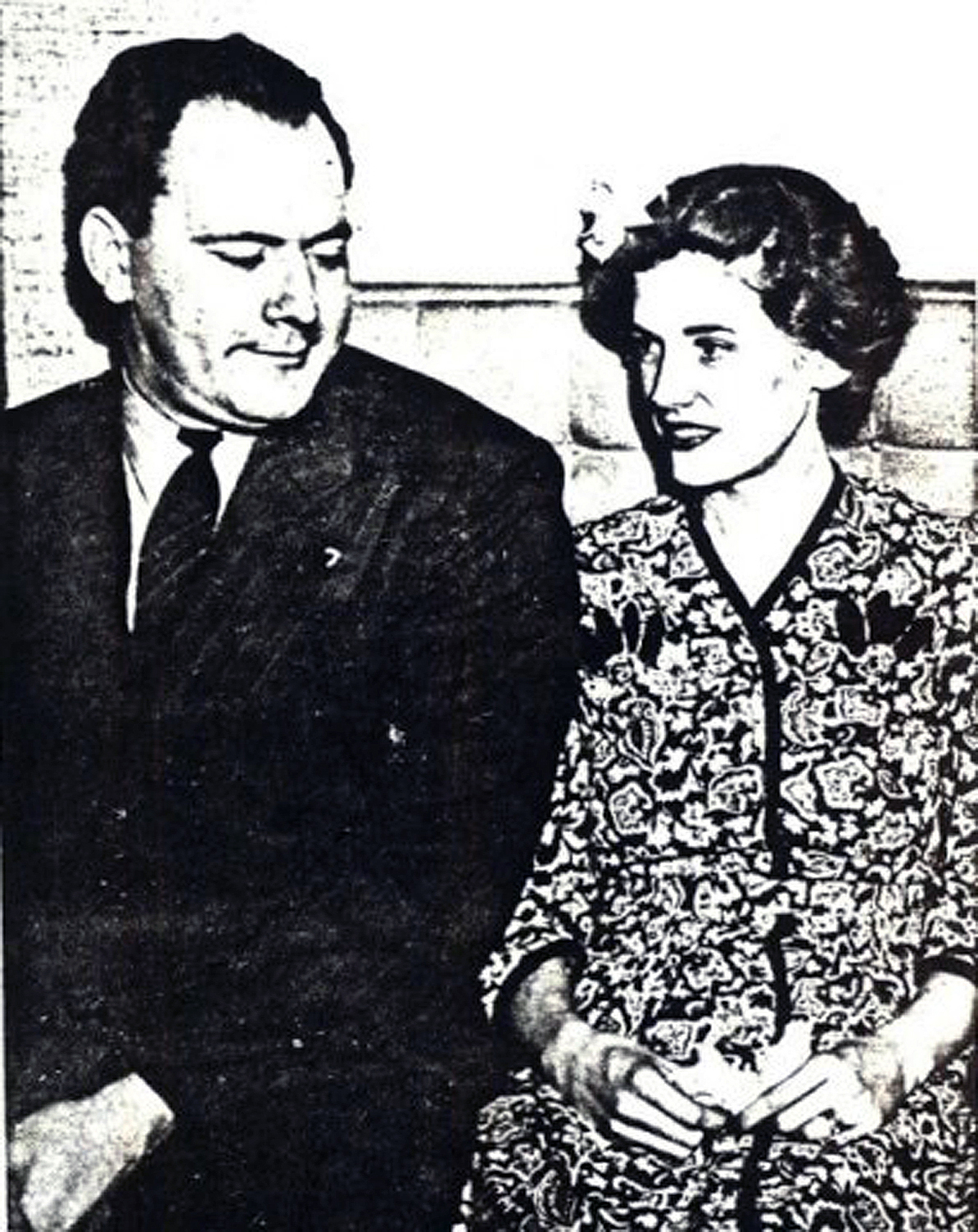
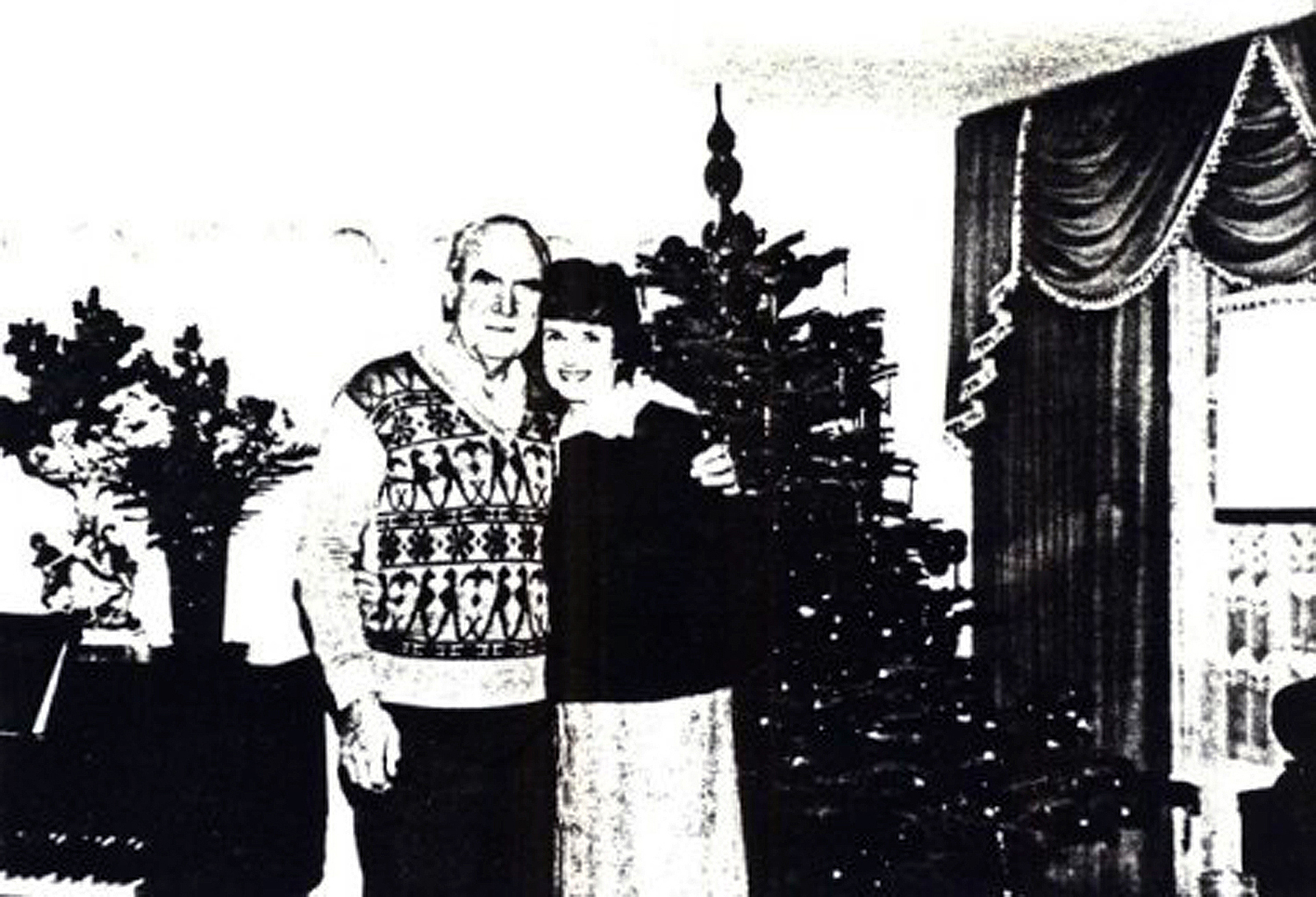
As the family chart will show later in this history, within a year of when aunt Merintha wrote the above account, she passed away on the 7th of March 1966. She was buried in the Salt Lake City cemetery.
Uncle George Williams remained alone at their home on 12th Avenue in Salt Lake City for several years until it became advisable for him to go to daughter, Ella's and Harry's home in Santa Rosa, California where he spent the last few years with their loving care. In fewer than another 5 months he would have reached his 96th birthday when he passed away in Santa Rosa. His body was brought to Salt Lake City for burial at the side of Aunt Merintha. His death occurred 31 Mar 1978.
A SHORT HISTORY OF GEORGE AND MERINTHA BLACKER WILLIAMS
By daughter, Ella Williams Empey
"My account of my Mother, Merintha Althera Blacker and Father, George E. Williams will start in Kemmerer, Wyo., where Grant, my brother, and I were born. Dad built a house for Mother (Dad was so handy, he could do most anything with tools) which consisted of a living room, dining room, kitchen, bathroom, one bedroom and a closet with ground for a little garden and chickens - - way at the back. Dad loved flowers and we always had a beautiful manicured lawn and flowers of every description that would grow in Wyoming. Grant went through high school in Kemmerer, played the saxophone in the school band, played basketball and was student body president. I always did lots of singing and was chosen several times to do plays, both in the community and school. Mother was always active in the Church and she loved the young people. She directed young people's choirs, worked in Mutual and the Primary. She always said, "If I had a million dollars, I would give it to the Children's hospital in Salt Lake for all those wonderful children."
"As we grew up Dad wanted to move to a community where we children would have more opportunities and when Grant was ready for a university education he decided on the University of Utah. He went ahead of the family for his freshman year, and lived with Aunt Marie and Uncle Kem Blacker while attending the U. The time had come, and Dad had enough seniority with the railroad to ask for a transfer and we moved to Salt Lake in 1932. (Just a side comment), When Uncle Kem took sick in Dec. 1931, Mother went to Murray, Utah and stayed with Aunt Marie to help her with Uncle Kem and baby, Kay and was with her until Uncle Kem passed away in June of 1932. Dad, Grant and I were in Kemmerer and Dad took care of us while Mother was away -- he never once complained nor would have had it any other way.
"We moved to a home on 9th East and 5th South in Salt Lake and Aunt Marie, now a widow, moved in with us. Mother and Dad were so happy to have them, and I know Aunt Marie thought of them as her parents. Mother took care of Kay while Aunt Marie taught school. Then Ann was born (Dad took Aunt Marie to the hospital to await the birth) then Aunt Marie and baby, Ann Marie, carne to our home and Mother took care of the two children until Aunt Marie wanted her own home and moved to Murray, Utah where she was teaching school..
"Then Mother and Dad bought a home on Third Avenue in Salt Lake and lived there for the next 40 plus years. Aunt Marie and Kay and Ann were just part of our family. In all the years we were in Salt Lake they spent every Thanksgiving and Christmas with us (until Kay and Ann became a little older and wanted to be with friends, particularly at Christmas, but always had dinner with us) and Marguerite Gardner was with us, too. Marguerite lived with Aunt Marie and helped her for years while the children were small. After each get together, when the children were little, Dad would carry them to the car, tuck them in and Aunt Marie would chug and jerk away (she was not a very good driver) and Dad would always laugh and say he would be thankful when they got home. Then in about an hour, Aunt Marie would call to report her safe arrival. This was an arrangement they had agreed on, so Mother and Dad knew Aunt Marie and children had gotten home and were alright. We loved Aunt .Marie and family so much and I mow Kay and Ann loved Mother and Dad, as Kay paid a wonderful tribute to them at Dad's funeral in Salt Lake in 1978.
"Grant graduated from U of U, married Marjorie Erickson and during their marriage found it necessary to move in with Mother and Dad. Once again, our parents opened their home and Grant and Marge stayed with them a year or so.
Marge was a nurse and this was when Grant decided to get his doctorate in optometry and went to Los Angeles to school. Marge stayed with Mother and Dad and once again they were parenting their family. Marge, too, loved my parents for their goodness to her. This separation was bad for the marriage and Grant and Marge were divorced. Grant got his degree, moved back to Salt Lake and became an optometrist with his first office on Main street and later married his nurse-receptionist, June Mackey, and they had four children.
"During this period, I (Ella) graduated from South High School in Salt Lake, was always active in all things musical and went to the U of U where I met Joseph H. Caldwell. We were married in the Salt Lake Temple after a two year courtship, spent two years in Ogden, Utah then sought our fortune in Reno, Nevada. It was a good move for us. Joe was made General Agent for Occidental Life Insurance Company. We had a daughter, Shirley Ann, born in Salt Lake in 1939. We were active in the Reno Ward. I worked in MIA, Primary, very active in choir and all ward music and Joe was in the bishopric and held many ward and stake positions. Our lives seemed so perfect in every way, then on June 13, 1952, Joe was driving to Carson City, Nevada to do some lobbying for the State Insurance Assssociation, when an intoxicated truck driver hit the car head-on and instantly killed Joe and two other very prominent Nevada insurance men. Needless to say, things completely changed for Ann and me and once again Mother and Dad came to our rescue. We sold our home in Reno and moved in with Mother and Dad for one year until I got my 'feet on the ground'. I can't express the gratitude I feel for the love and help they gave Ann and me during this year - - and always. I don't think a grandmother and granddaughter ever had a more wonderful relationship than my Mother and my daughter, Ann. What special memories for all of !
"Dad retired from the railroad, after 45 years, in 1952, at the age of 70. He was compelled to retire - - R. R. Policy, and he often said he didn't kow why you couldn't work as long as you wanted to and were able. But he never stopped building, doing his own yard work, cooking and housekeeping, when Mother was so ill, until he came to Santa Rosa in 1973 at the age of 90.
"Ann and I moved into our own home in Salt Lake after the year with my folks. Ann went to high school in Salt Lake and graduated from the U of U with a BA in English. She met Anthon Gannon at the U, finished her education and waited while Tony served a mission in Australia.. They were married in the Salt Lake Temple in June 1962, moved to Cambridge, Mass., where Tony got a law degree from Harvard University and then lived in New York for the next 10 years. Then, much to our joy, they moved to the west coast, LaCanada, California. They have three beautiful daughters, Rebecca, Elizabeth, Jennifer and a powerhouse boy, Anthon S. III.
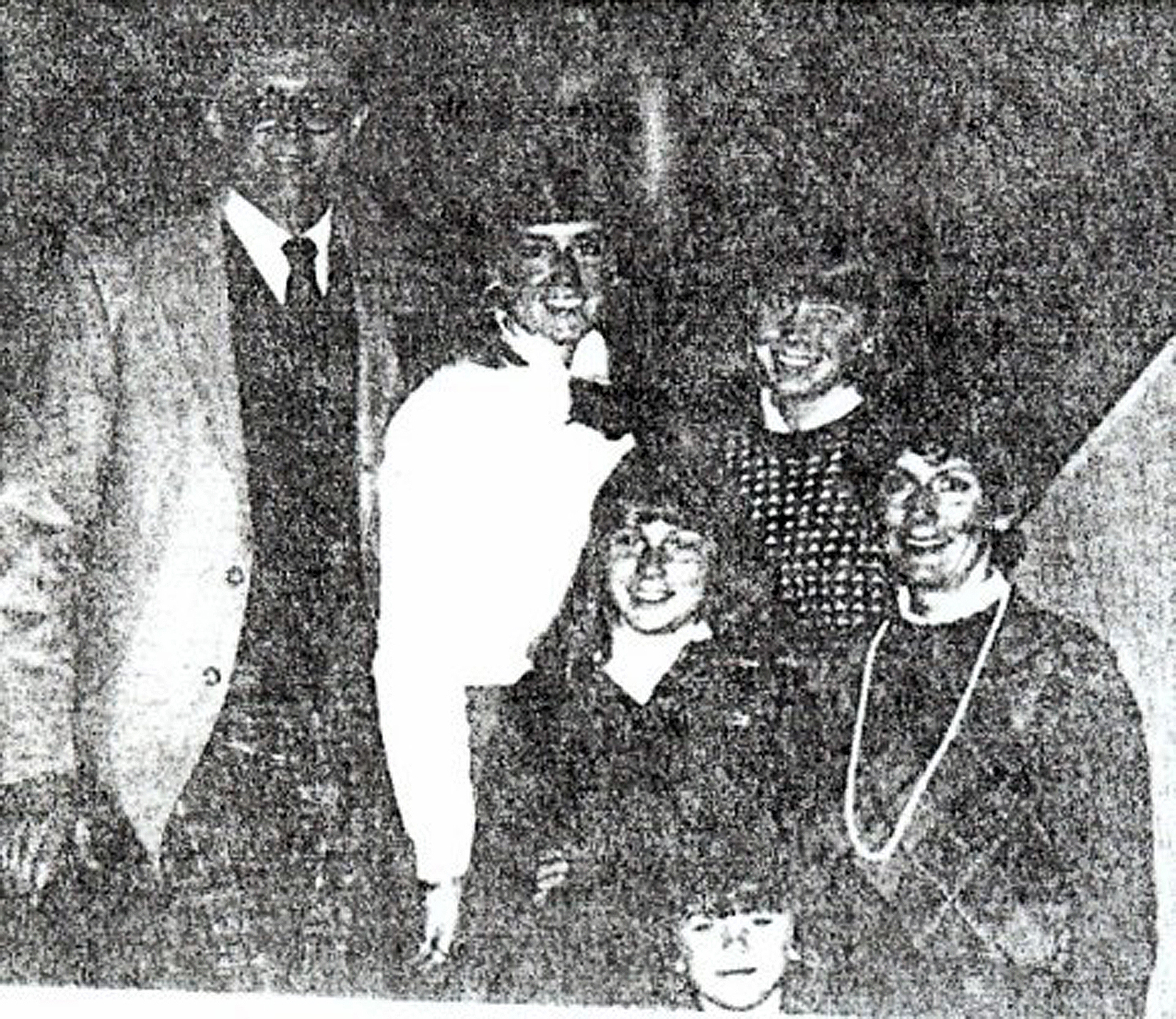 Back row, 1 to r: Anthon S. Cannon, Rebecca and Elizabeth, 2nd row: Jennifer
and Shirley Ann Caldwell Cannon. Bottom center: Anthon S. Cannon III.
Back row, 1 to r: Anthon S. Cannon, Rebecca and Elizabeth, 2nd row: Jennifer
and Shirley Ann Caldwell Cannon. Bottom center: Anthon S. Cannon III.
"After moving to our home in Salt Lake, I (Ella) got my life together. Worked 5 years at KSL Radio and 5 years for Western Airlines. During these years I sang with the Salt Lake Tabernacle Choir, first under the direction of J. Spencer Cornwall and, after he retired, under Richard Condie. Such wonderful experiences I had in those years. Went with the Choir to Europe, sang the Messiah in Carnegie Hall in New York City, made recordings with Eugene Ormandy and the Philadelphia Orchestra and had many spiritual and grand experiences those ten years. My daughter, Ann, also sang in the Tabernacle Choir at the same time I did and so we have many beautiful memories to share.
"In 1962 I met and married a wonderful man, Harry C. Empey. We had been high school friends and some 30 years later decided to marry and make our future together. We moved to Santa Rosa, California where we still reside. I could never have hoped for a better mate - - at this writing, 1983 - - we have been married 21 years and hope this is just the beginning. Mother did not know Harry, as she was so sick when I met him, but when Dad lived with us from 1973 to 1976, he learned to love and appreciate Harry who took such good care of Dad, night and day.
"Back to Mother and Dad. Mother's last years were sad, as she was very ill and Dad took constant care of her. What a wonderful, caring companion he was. Still taking care of his lawn and flowers, all the cooking and house work and his dear Merintha. I was with Mother and Dad on March 7, 1966, holding Mother's hand, when she passed away at the age of 78.
"Dad lived alone in the Third Avenue home for another seven years. We wanted him to be with us in Santa Rosa, but he wanted to be independent and live alone as long as possible. Then in the fall of 1973, when Dad was 90 years old, we insisted he give up the home and be with us. He did so begrudgingly, but I'm sure he realized the time had come when he needed someone to care for him, after all the care he had given others..
"Dad passed away on March 31, 1978, just 5 months before his 96th birthday and we returned his body to rest beside my mother, Merintha Althera Blacker Williams. My love and gratitude to my wonderful parents, who made all things possible for me."'
Returning to our story of Grandma Blacker and her family living on their farm north and west of Afton and following Aunt Merintha's and Uncle Will's marriages, Uncle Hyrum became the senior son, now just 21 years of age and who now had the full responsibility of managing the farm - this probably in 1915 - for Uncle Will remained on the farm with Aunt Ella until after their eldest son, Roderick was born in June of 1914.
About this time a war-scare with Mexico had fronted, and a unit of the Wyoming National Guard was organized at Afton and a call for volunteers was sent out and young men - young married men as well as singles - were encouraged to join. Two of the Blacker boys - both married - Tom and Will, found themselves drilling to the martial music of the Afton town band on frequent occasions. How well the writer of this account remembers his going with other members of the little family, in the white top buggy, after milking time in the evenings, to witness and thrill with the sound of the music and the waving of the flag as the small guard team went thru its drill formations called out by an out-of-town military man by the name, I think, Major. Such could have been his rank. Of this I am not sure, but what a spark of excitement the entire Star Valley 'military' created in the, otherwise, monotonous events of daily living in the quiet Valley.
The war scare became very real during this particular summer, for a call came that the Star Valley National Guard unit was to report to a man in, as can now be recalled, Cheyenne. It would seem very possible, and quite likely, that Uncle Brig Gardner may have also been included in this group. Due to a heart condition Uncle Hyrum was not included.
What a sad morning it was when the families of Star Valley took, particularly, their husbands and fathers to Afton in their buggies and/or wagons only to return home without them and, in most instances, to a herd of milk cows which had to be chored night and morning, as usual. It was summer time and both the Blacker families involved had water in the irrigation ditches which had to be cared for, for there were growing crops in the fields.
It would seem from this later perspective that the local guard officials, with their enthusiasm in their efforts toward national security quite overlooked the fact that in any national emergency the 'home' front, likewise, had to be maintained. The latter could not be supported by taking heads of families from their homes, herds and farms.
Sufficient protests of various descriptions, and from sufficient sources, reached a higher echelon of command After the Star Valley unit had reached Cheyenne, a second look was given the newly arrived fathers and farmers with children and herds and crops, and within a week's time there was a reversal of assignment, and among others, Will and Tom Blacker returned home with honorable discharges.
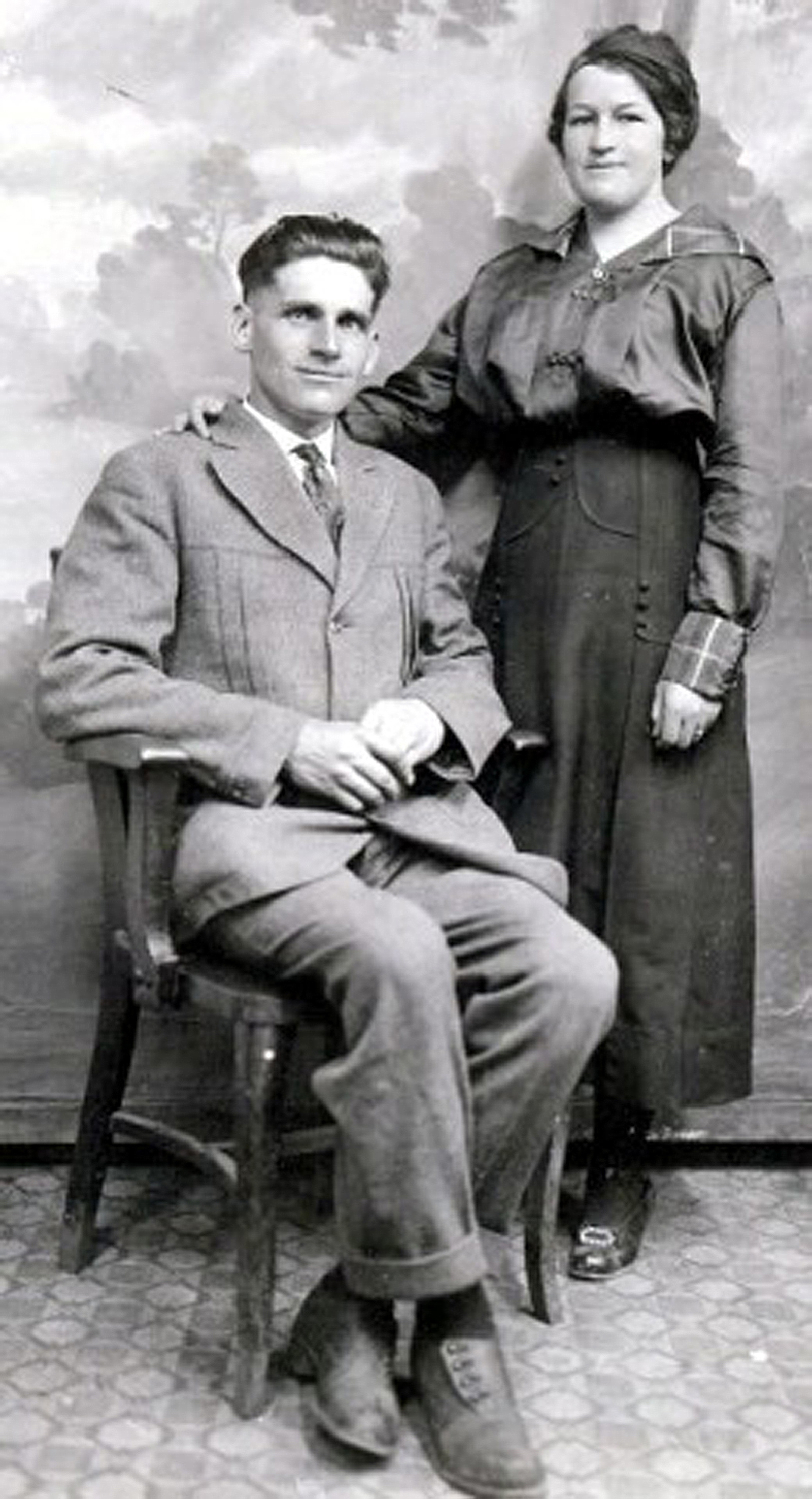 Hyrum Blacker and Elva Cazier married 23 January 1915.
Hyrum Blacker and Elva Cazier married 23 January 1915.
As earlier stated, Uncle Will purchased the Anderson forty, one half mile east of the original Blacker home, which was approximately the time of which we are referring to the National Guard experience. Most likely, Uncle Will's move made possible another important family event. With Uncle Hyrum next to have the responsibility of becoming the man of the farm as soon as Uncle Will left, there came an opening in the new house for him to introduce a wife to the family. With the type of situation existing so far as living room as concerned, it is quite possible Uncle Hyrum, now well over 23 years of age, had already had to postpone marriage until a vacancy was brought about. Of this we are not sure, but it seems very plausible, nevertheless, be that as it may, a marriage between Hyrum Blacker and Elva Cazier took place on the 23rd of January 1915.
Grandma Blacker's family of the unmarried portion was getting smaller. There now remained Aunt Fannie, a gal who had to play an important roll as milk maid and general chore girl on the farm. She was now 21 years of age herself. She had seen a lot of service in caring for the farm animals and working in the hay fields in its harvest as well as, during the snow seasons, distributing the hay to the animals at feed time. Also, at home, was youngest son, Kem. Kem, as so with his brother Hyrum, had not been well since childhood. He, more so than his brother Hyrum, seemed not to have been meant for the farm. Due to a heart condition and lameness in his feet, he was limited when it came to exerting work. He was, at this time, the only one of the family attending school - high school in about his junior year, for he was 17 years of age and he was a good student. The handwriting had been on the wall thru the years that, of necessity, his future would have to be off the farm.
Whether it was a year or two before, or approximately the time of Uncle Hyrum's marriage, that the following occurred, probably prior to. One fall, Uncle Will and Uncle Hyrum, as many families did in Star Valley, took their team and wagon out to the Bear Lake country, possibly even over the mountain from Bear Lake to Cache Valley in Utah. They made the trip for their winter's supply of foodstuffs, such as potatoes, perhaps wheat, onions, cabbage and other storable vegetables, apples, pears etc. etc. and/or any other needs which the 'outside world' could offer, which were scarce in Star Valley.
While on this trip, these two young men were approached by an apparently deserted mother with a family of children. She was searching for help in caring for her children. The result was that Ivy, a young girl of about 12 years of age, came with them to their home to be provide for. Her mother did not have the wherewithall to keep her.
Ivy became endeared to all of us of even the enlarged Blacker families. Whether by design or not, Ivy became very much an outdoor girl. During the several years she made her home with the Blacker family, she served as well as any hired man. This was her nature and her choice. As she grew older, she was able to handle cattle and horses as well as any man. It seemed nothing to her, as she was to mount a bare-back horse, to throw her right leg over the horse's back in order to straddle it, and off she would go with the horse on a run.
For several years, Uncle Hyrum sponsored a milk-carrying route by horse and wagon - or in winter time by sleigh, and as Ivy became older, it became her chore to drive the milk wagon to the creamery at Grover, a distance of five or six miles total from her place one way. There were milk cans - eight and ten gallon size cans - placed by the side of the road on milkstands by individual farmers. These stands were elevated to the proper height for transferring to the wagon without the milkhauler having to make the initial lift. Rather often some of us older kids - 10 or 12 years of age - would have the assignment to go with Ivy to assist. (Usually not more than one helper on a trip). The milk route commenced at Uncle Hyrum's and going east along the first mile stretch, milk would be picked up from the two Mickelson homes, Uncle Will's, Oz Gardner's, and coming to the Afton-Grover road, pick up the Kennington's, Uncle Brig's and traveling north toward Grover, the Tom Blacker's four or five cans, to the Will Gardner's, Ad Jensen's etc., and to as many as had contracted to have their milk hauled and to the creamery about one mile west of Grover, back toward Salt River.
We kids used to love to take our turn going with Ivy, not only for the ride and the conversation ,but also, when at the creamery, we never failed to go to the big cheese vats where the attendant would permit us to take a handful or more of curd which, even to this day, is the writer's choice of cheese products. Some of the farms who may have had pigs would buy back from the creamery, the liquid residue from the creamery processes, the whey or, as we called it, swill, for the feeding of pigs. Cans of this were delivered to the proper places as well as the empty milk cans on the return trip.
Ivy remained with Grandma Blacker for eight to ten years. She eventually returned to the Cache Valley area and married and raised a family.
Back to Uncle Hyrum and Aunt Elva: This writer remembers Uncle Hyrum very well, with, perhaps one of my earlier memories being of the time the folk arranged previously with Uncle Hyrum to stop at the house while on the same milk route as described in connection with Ivy, but before Ivy had joined the family. This stop was for the purpose of giving me my first haircut. Uncle Hyrum held the distinction of being the family's barber. I had reached five years of age and due to my auburn colored hair being inclined to curling had been kept in ringlets. Dad's ill kept promise before any of us were born was that if he had any red-heads, their heads would be kept shaven. The first of the three of us who had red hair proved his lack of full intent, for it took five years to get as much as a hair cut. The writer can remember well the sunshine morning when Uncle Hyrum stopped in with his barber scissors.
Uncle Hyrum was popular and a friend to everyone, young and old alike. He had a beautiful singing voice and was very much in demand for entertaining purposes, as well as being constantly in demand for funeral services. He and his neighbor, Arling Gardner, of about the same age sang beautifully together.
It was Uncle Hyrum who loaded his sleigh with household goods of the Thomas Blacker family and assisted in their moving from Afton to Montpelier on their move to Rupert - this on the 29th and 30th days of December 1919.
Previous to that, the writer remembers well his spending several days of a couple summers assisting with the derrick team during haying seasons, as well as one monotonous chore of one summer spending a few days along walking back and forth thru a large oat field south of their house pulling up yellow blossomed mustard plants. It was customary for Uncle Hryum, following dinner, to take a short nap on the living room floor before going out for the afternoon. There was nothing for me to do but to accompany him, but I was at the wrong age. Too old for babyhood naps and too young for daytime oldster's naps. These have always remained dear memories.
The young couple - Uncle Hyrum and Aunt Elva - opened their home to two babies, each in their turn, Alberta and Talmage, the latter name due to Uncle Hyrum's high respect for one of the general authorities of the Church at the time, James E. Talmage. While yet a young man Talmage suggested that he become known as T.C.
Uncle Hyrum was not permitted to remain long with his little family for on the 22nd of January 1921, actually one day less than six years following their marriage, he passed away, leaving a heartbroken wife and mother with two small children, Alberta then just past her fourth birthday and Talmage not much over a year and a half.
Following Uncle Hyrum's passing, Aunt Elva returned to her previous employment in Afton, as a telephone operator. Within a short time, her parents had moved to the Kimberly, Idaho area and to be near them she secured a position in the Kimberly telephone office where, for many years at that place and subsequently in Twin Falls, even to her retirement age, she worked at the telephone office.
In the mean-time, she met Lee McCrackin and married him in Twin Falls where, for many years, he served on the city police force. To this union was born a son, Ronald, who grew to maturity and married and has a lovely family. Their home is also in Twin Falls.
Aunt Elva, as of the year's end of 1982, is at an advanced age. After living alone for several years following the death of her second husband, she lived with her son, T.C., and wife, Lily and family, until it was concluded that a rest home, where better help could be given, would become her home and it is there that she presently resides - in Caldwell, Idaho.

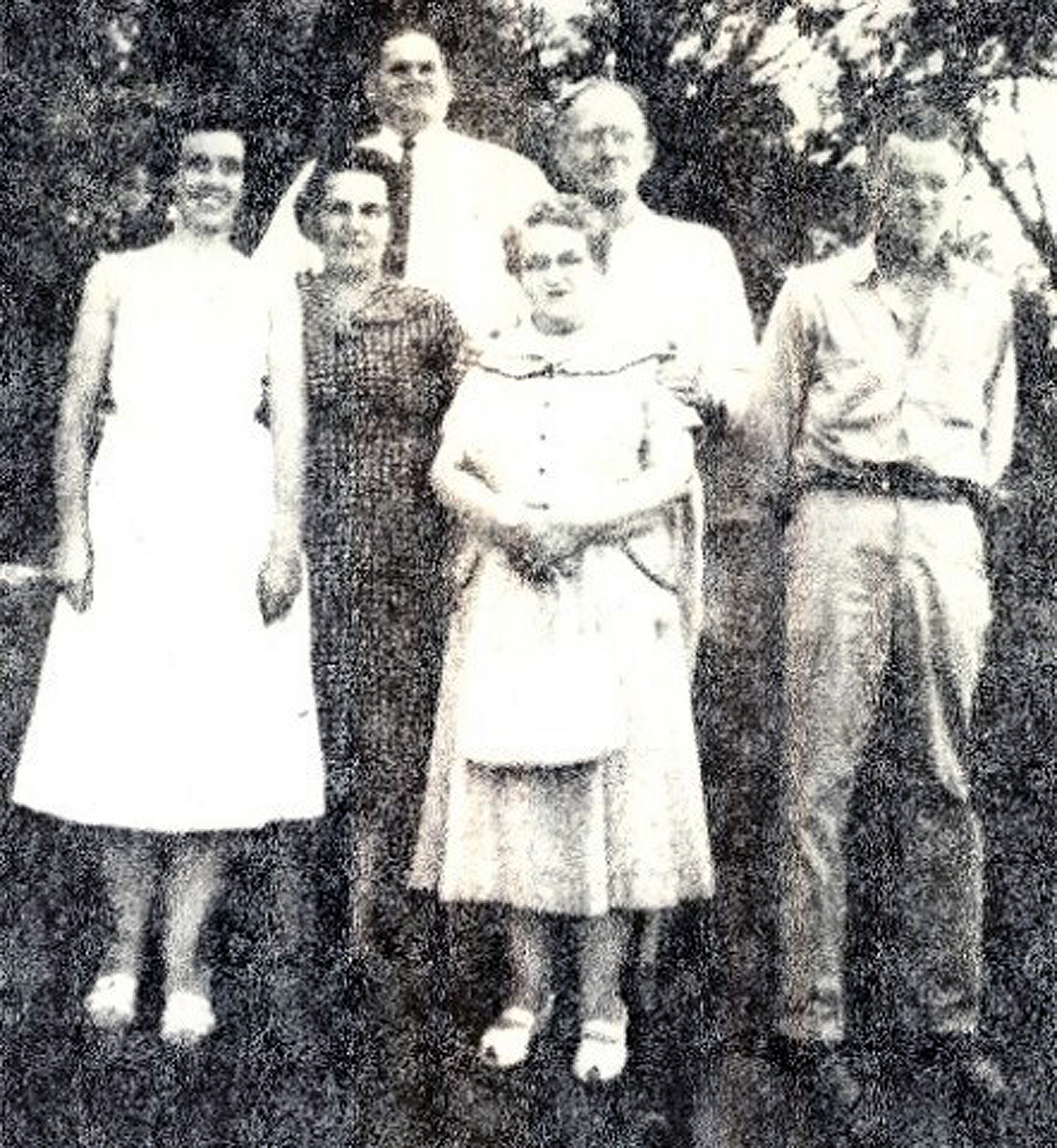
Alberta grew to maturity under the care of her mother and later stepfather and she also, worked as a telephone operator. After marrying Raymond (Buck) L. Buckman, they had three daughters, Marian, Barbara and Vicki. Buck's work required much moving about until they arrived in Ontario, Oregon, at the time, also, the writer's home town, and Mabel and I became close to Albert. She was an admirable person - quiet with a pleasing disposition. One had but to know her to love her. It became necessary for her to obtain a divorce, which left the responsibility of caring for her family to her.
With the encouragement of her big, but younger brother, she obtained a teaching certificate by graduating from the Boise State College. She obtained a teaching position back in Twin Falls, the home town of her mother. In the mean time, her daughters matured and the two younger ones married, while Marian, the eldest, found good employment in nursing.
In 1972, Alberta married William McCauley of Twin Falls, but continued with her teaching. Her new husband, Bill, was an employee of a trout farm in the neighboring town of Buhl. His own car was in the garage requiring service, so on the morning of 10th of April 1973, just eight months after their happy marriage, and prior to school hours, she took him to Buhl to his work. While returning at approximately 8 o'clock, she collided head-on into a 10-wheel potato truck and was killed instantly. Her burial was in the Twin Falls cemetery.
T.C. grew up with his sister in their mother's home as has been alluded. His school days were in the Kimberly and Twin Falls schools. He married Lily Cook and they became the parents of two girls and two boys. In turn, Eileen, Jim (James) and Kyle C., have married and each have a family of four, six and five children respectively. Youngest daughter, Janis, still maintains her freedom as of the end of 1982.
Through the years T.C. has become one of southern Idaho's most successful and influential business men, with presently, large furniture outlets in Nampa, Idaho and Ontario, Oregon. After serving as a Mormon bishop in one of the Caldwell, Idaho wards, he was called as stake president of the Caldwell stake. From this position he was released approximately a year ago after a term of approximately ten years.
From somewhere, surely Uncle Hyrum has been permitted to look down on his small but accomplished family and say to himself, "They are mine". His grandchildren, both Alberta's and T.C.'s children, are proving that their generation are "people of quality", as were the generation ahead of them, and the generation before that.
Again we return to the first Star valley Blacker home where, at the time of Uncle Hyrum's marriage, the remaining children with Grandma Blacker, were Fannie and Kem.
Aunt Fannie had reached an advisable age for any girl to have prepared herself well by first getting her feet squarely on the ground, and to have gained the foresight to determine whether her intended husband had his head on straight. As their children and the rest of us, from our present vantage point at the close of 1982 can all wholeheartedly confirm, this has become a proven fact after now they have both become deceased and, in time, some sixty five years since their marriage we can challenge, "By their fruits ye shall know them".
Fanny Blacker's and Earl Cazier's courtship was fraught with a concern which none of the others of the family had encountered. World War I had broken out caused by a distasteful incident in Austria. Western Europe was engulfed in deadly warfare and things looked bad here in the U.S. despite the fact that we had a president who had promised that Americans would never have to fear.
Such proved not to be the case, but due to underhanded intrigue on the part of the Kaiser of Germany, who encouraged the revolutionary movement in Mexico. We already referred to this movement, headed by 'Pancho" Villa, purposely to direct Woodrow Wilson's attention from the European theatre of war, with the sole intent on continuing U.S. neutrality on that front. The 1914 affair with Mexico petered out, but at one time - 1914 - four-fifths of the U.S. Army was directed toward the Mexican situation, which very much pleased the perpetrators of the German thrust to conquer the world. As has been recognized, two if not more of the Blacker family were touched.
With the climax of the skirmish with Mexico reaching its peak and becoming settled, the next several months saw the German efforts destroying the trans-Atlantic cables which, quite directly, affected the United States. Coupled with this threat, the commencement of unrestricted submarine warfare in the Atlantic again stepped heavily on U.S. toes. During these intervening months, which actually ran into more than a year or two, U.S. national sympathy bent very much in favor of western Europe, which was being attacked so viciously by German forces.
Democracy was seen to be threatened and this subject became a discussion subject by many Americans. Victory on the part of Germany could be seen as a possibility, and it became a national concern when our president, Woodrow Wilson, personally sensed the situation. After feeling the pulse of the citizenry of the country, he gradually changed his concept of what he previously had felt and what he could see it might lead to.
With such an impetus, the president could see the that it would be necessary for the U.S. to offer the western European countries more than verbal aid. So the motto, "Make the world safe for democracy", became a moving influence in the minds and hearts of Americans.
Diplomatic relations with Germany had been severed. With over a half million tons of shipping going to the bottom of the Atlantic every month because of German submarines, great concern was aroused. Much of this loss consisted of war supplies badly needed by the allied countries and, particularly, by France and England. The begging for help by the already toppling nations of western Europe, convinced the U.S. government to do something, but their real cry was for manpower.
"Never mind the guns, never mind the transport - we'll provide them. Only bring your young soldiers over to fill our thin ranks. The fate of France and of the war is at stake", was the message Wilson received.
Seemingly, the need for the good of democracy here at home as well as elsewhere in the world, was sensed by the people of the United States as well as the president, so when President Wilson appeared before Congress and told that body of senators and representatives that the success Germany had already achieved was, in fact, nothing less than war against the U.S. government. He said, "It is a fearful thing to lead this great, peaceful people into war, into the most terrible and disastrous of all wars, civilization itself seeming to be in the balance. The day has come when America is privileged to spend her blood and her might for the principles that gave her birth and happiness and the peace which she has treasured. God help her. She can do no other."
Following the President's remarks, the vote to support his declaration of war was 82 to 6 in the Senate; 373 to 50 in the House - not unanimous, but convincing. The date was April 2, 1917.
It is not the intent of this family history to further pursue the account of World War I, excepting to mention that among more than two million troops which the U.S. sent to France and other embarkment places, was the newly adopted-to-the-Blacker-family-bridegroom of the 28th of June 1917, Earl Cazier.
There had to have been concern on the part of the families involved in this marriage, and particularly, deep concern on the part of Uncle Earl and Aunt Fannie. In this case, as we are all well aware, after his service with Uncle Sam, Uncle Earl did return. Such was not the case in at least one of their to-be sons-in-law, Doyle Draney, who was called to offer the supreme sacrifice in the Pacific theatre of World War II in 1945 while in Okinawa, another great war to 'Make the world safe for democracy'.
Uncle Earl and Aunt Fannie were married at Kemmerer, Wyoming as stated above, on the 28th of June 1917. Perhaps the fact that Kemmerer is the county seat for Star Valley where a marriage license could be obtained, but also, the fact that Aunt Fannie's sister and husband were, at the time, living at Kemmerer, undoubtedly affected the decision to be married at that place.
While Uncle Earl was in France with his military assignment, a pair of twin girls arrived to Aunt Fannie at Grandma Blacker's home, where she had arranged to stay until Uncle Earl's return. Whether the little girls, Dona and Dora, were officially named before Uncle Earl participated in the selection, which would have been by slow boat and train mail, we don't know.
Their arrival brought to aunt Fannie a great responsibility. While they were perfectly normal in every other way, their feet were somewhat twisted, which required early correction by particularly, braces. These naturally, caused discomfort and, undoubtedly, varying degrees of pain and, for weeks - perhaps months - the little girls required a lot of personal care.
This writer remembers the reports of the long nights Aunt Fannie spent in their care during which she could get little rest. She became exhausted, and otherwise run down to the point that it became essential that family members, neighbors and friends saw fit to relieve her, particularly at night, so she could get some rest.
In the meantime, the war was going on and there was great concern for Uncle Earl, for he was very much in regions of heavy conflict. The writer's memory serves him well of the anxiety all America felt about the welfare of "the boys over there". Personal and private conversation, plus a then very popular song referred to the "dough boys", as the soldiers of that war were termed.
On the 11th hour of the 11th day of the 11th month of 1918, came the long-looked for moment. Peace came to war-torn Europe and the war-affected world. On that day, President Wilson said, "Everything for which America fought has been accomplished". What hopeful thinking! As we are all aware that intent did not prove to be a reality, for within two decades, the next generation fought an even more devastating war to pursue the same purpose. A lesson has come clear to all of us that war will not end war, it never has, nor itever will.
Just how soon following the armistice Uncle Earl returned home to his beloved wife and his daughters, whom he had never seen, this writer does not now recall, but that he did return we need no further confirmation.
Farming, dairying, sheep and cattle raising became their pursuit after eventually establishing a home of their own, and to them came, in addition to the twins, Dona and Dora, six additional children consisting of Ireta, Paul B., Marveline, Quinn B., Lue Dean and Billie Renee.
By the end of 1982, Uncle Earl and Aunt Fannie can boast of four grandchildren and seventeen great-grandchildren thru daughter, Dona; four grandchildren, 10 great-grandchildren and four great-great grandchildren thru daughter, Dora; six grandchildren and 15 great-grandchildren thru daughter,Ireta; four grandchildren, 13 great-grandchildren thru son, Paul B.; five grandchildren and 17 great-grandchildren thru daughter, Marveline; six grandchildren and 15 great-grandchildren thru son, Quinn B., two grandchildren thru daughter, Lue Dene; and six grandchildren and 7 great-grandchildren thru daughter, Billie. This reveals above and beyond their six children, a total of 37 grandchildren and 94 great-grandchildren for a grand total of 135 direct descendants. These numbers, naturally, do not include the sons-in-law and daughters-in-law. What a marvelous family!
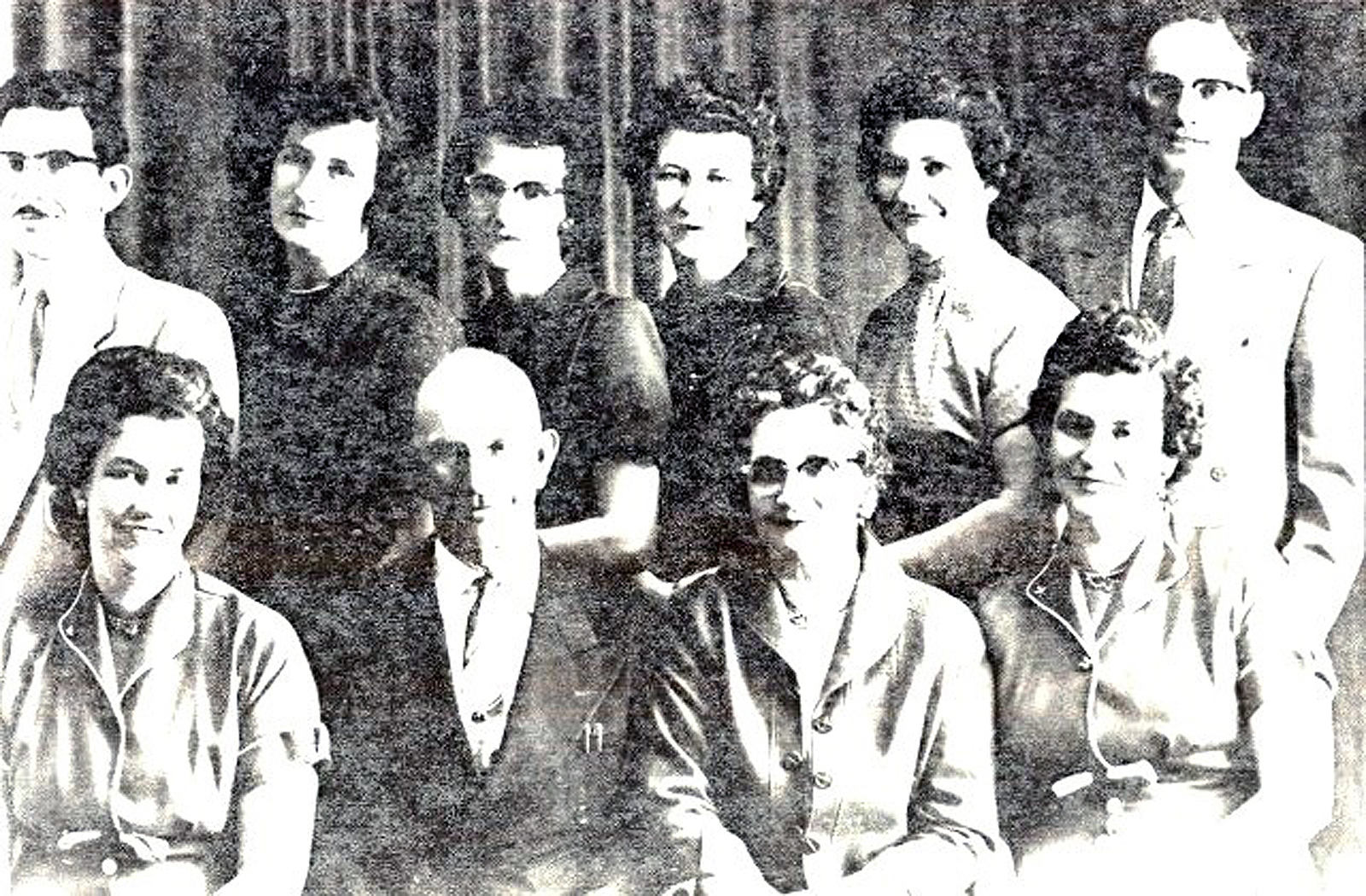 Front: Dora, Uncle Earl, Aunt Fannie, Dona, Back: Paul B., Billie Renee, Marveline,
LuDene, Ireta, Quinn
Front: Dora, Uncle Earl, Aunt Fannie, Dona, Back: Paul B., Billie Renee, Marveline,
LuDene, Ireta, Quinn
This family has been and remains outstanding in "family-togetherness". To describe Uncle Earl, he would have to be described as very quiet and unassuming. Not unassuming in the sense of not assuming responsibility to his family and community, but unassuming so far as forwardness toward any limelight. He was always exceptionally reserved.
His companion was different. Vivacious, but not to the extreme. She loved life and was exacting. She exemplified and loved action. She was a doer and was not content until she had others doers with her. No drone could be comfortable with her. She loved adventure and nothing pleased her more than to be seated in the front row at a sports event whether it be boxing, basketball, baseball or a footrace. It could hardly be farfetched to say that it is very possible that sports fans would have been happy to purchase a ticket to the game, not necessarily to their interest in the game nor even its outcome, but to witness and hear the excitement of one, Fannie Cazier. She, with sports, was much like Aunt Polly Blacker with comedy in a show house or with a group of friends. And so it was such a pleasure to be in the presence of Aunt Fannie when there was reason for excitement. Regardless of the winning or the losing, one could be assured of comments from Aunt Fannie. A ticket-selling impetus was surely, "Fannie Cazier will be there" and when she was, no one could say they didn't get their money's worth. This writer wonders whether they even produce Aunt Pollys or Aunt Fannies any more. They were respectively, one of a kind.
As to loyalty to the Church, Uncle Earl's and Aunt Fannie's family have been and are, the epitome of well-grounded faithfulness. Their goal has been "stay close to the Church for safety". After all, there is no greater protection a family can have if the goal is exaltation. No other heritage can be left to a set of parent's posterity than this one principle whichUncle Earl and Aunt Fannie left, and it hasn't been in a pretentious way.
Uncle Earl served a short-term - 6 months - mission to Iowa, and served as a branch president. Their son Paul served two years and eleven of their grandchildren and nine of their grandchildren's spouses have served and, now, reaching into their great-grandchildren, two have served for a family total of 44 1/2 years in the mission field. Uncle Earl and Aunt Fannie, as a stake missionary couple, served two years each. As one looks at their posterity, one can see that family missionary service is just beginning to bud.
Eldest daughter, Dona, married Vincent Tolman on the 8th of June 1939 and they became the parents of two girls and two boys, and have inherited seventeen grandchildren. Other than servicing as a telephone operator at the Afton exchange, Dona has had considerable clerking experience in local businesses, however her mother and household activities have been her joy. She has had many years experience as a teacher in Church auxiliary organizations and in the ward Relief Society presidency.

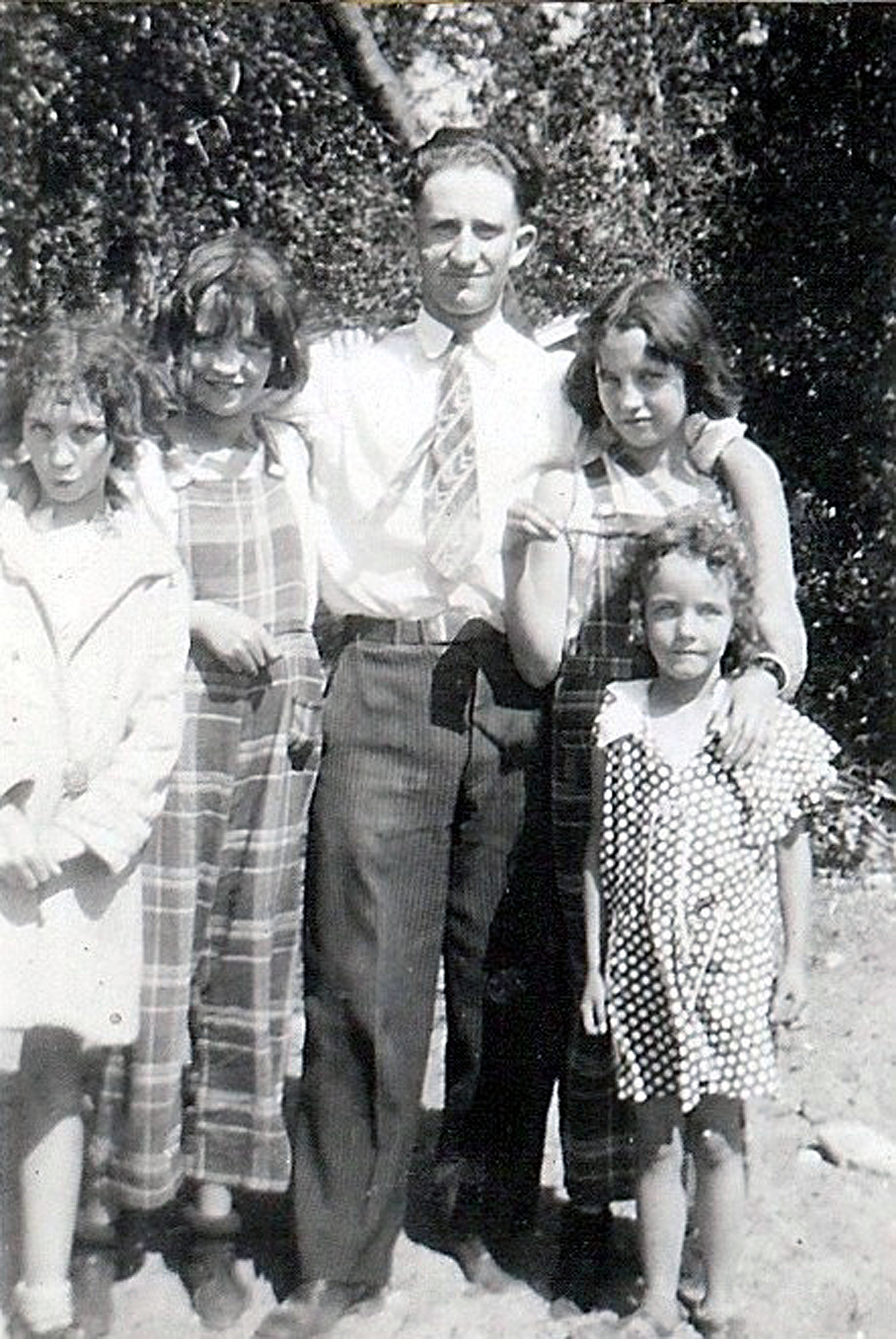
Dora, twin sister to Dona - identical twins - and what a problem to relatives, friends and teachers. As an example, when they were in high school they were selected to take the part of a character in the play, Huckleberry Finn. Dona took the part in the first and third act and Dora, the same character, but in the second act. The average viewer never knew but that it was all done by the same member of the cast. Even to this day, this writer, when meeting them after normal long absences, always, when approaching either of them each, 'Dona or Dora', how are you? Dora married Yates Perry on the 17th of Sep 1937. Dora and Yates have three sons and a daughter, ten grandchildren and six great grandchildren, with one deceased.
Dora is to retire in October of 1983, after having worked for the Lower Valley Power and Light company for 25 years. Both the twins graduated from the Star Valley High School. Dora has had many years experience with the auxiliary organizations of the Church and particularly likes teaching positions.
Next daughter in line, Ireta: She grew up assisting particularly with outdoor chores which included milking cows and helping at lambing time, particularly when her father was away from home shearing sheep. Ireta graduated from the local high school and on the 8th of June 1939, she and Neal Kennington were married. This wedding in the Salt Lake Temple was of particular interest due to the fact that her twin sisters and husbands had their marriages sealed at the same time in the same temple. Ireta and Neil have six children and presently have fifteen grandchildren. Ireta, like her two older sisters, has been active in several of the Church auxiliary organizations, including on the M.I.A. and Sunday School stake boards. Her husband, Neal, has been occupied with such church positions as a bishop, member of a bishopric, as a high councilman and counselor in the stake presidency. He is the stake genealogy coordinator, while Ireta is serving as a stake genealogy librarian and serving as an extractor in the Church extraction program.
Comes the first son of the Cazier family: Paul grew up on the farm, and naturally, contributed by assisting with all types of farm work, winters and summers. He graduated from the Star Valley High School and Seminary, as did his sisters before him. He served a mission in California and attended a barber school,which occupation he followed. He married Lois Call on the 30th of January 1947, and they have four children and thirteen grandchildren.
Like his parents and sisters and later brother, Paul has been active in the Church all his life, which included, while yet in Star Valley, stake M.I.A. and stake clerk. After moving to Salt Lake, he served as 2nd and 1st counselor - separately - to the Whittier Ward bishop and eventually became bishop of that ward. Subsequently he has served as a stake high councilman and a counselor in the stake Sunday School. His latest assignment has taken him back as a counselor in the bishopric. They still reside in Salt Lake City.
Another girl for the Earl Caziers, this time Marveline. Marveline is most enthusiastic in her appreciation for her good parents and the good home-life she had with her brothers and sisters. She likewise, graduated from the local high school and reports that, during the years, she has served in every auxiliary organization of the Church and favors her assignments in the M.I.A. (Mutual Improvement Association).
Marveline happened to have been born during the years which perhaps, became affected by World War II more than any other age group. She married Doyle F. Draney on 21st of September 1942. To them was born son, Eugene. The writer does not presently have the full story, but Doyle was required to become a part of Uncle Sam's military and was given assignments with the Pacific theatre of war. It was while the U.S. forces were attacking the island of Okinawa, only 325 miles from Japan, in order to gain an additional strategic foothold on their drive toward Japan, that the Japanese forces spent its full fury in the island's defense. The U.S. forces were not to be denied, despite the fact that the enemy's forces took a toll of some 5,000 American sailors and 130 ships. This was on the 9th of April of 1945, and Doyle was one of the casualties.
The war was nearer an end than Doyle or anyone else of his comrades had realized. The Americans did succeed in taking Okinawa, despite the cost, and continued preparations for a great final invasion of Japan itself, which never took place. Approximately four months later, two atomic bombs were dropped in Hiroshima and Nagasaki, which brought the Japanese warlords to surrender before General MacArthur on September 2, 1945.
And we continue to ask, "Why wars?" Whether in this life or not, the time will come when their uselessness will be agreed to. This family loss became real to the Cazier family, and particularly, to Marveline and her young son. Time helps to heal and after another nearly three years another good, young man came into Marveline's life. On the 31st of January 1946, they were married and to them have come four children, three boys and a girl. Their home, like all the other children of Uncle Earl and Aunt Fannie excepting Paul and Lois, is in Star Valley.
Next in order of age in the Cazier family is Quinn. He, like the other children, grew up on the family farm and completed his school work by graduating from the Star Valley high school and the seminary program. His favorite and, at which he was good, was basketball.
Quinn married Elayne Turner on the 15 September 1945, and to them have come three boys and three girls, all now married with children of their own, making a total of fifteen grandchildren.
Quinn, for their livelihood, has farmed, is serving as president of the valley's creamery board and has worked with the Social Security office. In the Church, he has served a stake mission, was a counselor to the Elder's quorum presidency, served as a ward clerk, and was very active in the church auxiliaries as president of the M.I.A. and Sunday School. He served as scout worker in the stake, was 1st counselor in the Afton 3rd Ward bishopric and as a high priest group advisor.
Another daughter, Lue Dene who shared in growing-up responsibilities in the home and on the farm excepting she was 'denied' - probably by circumstances - the privilege of learning to milk cows. Lue Dene also graduated from the local high school and seminary
Lue Dene married Ruel Jenkins on Christmas Day, 25 Dec 1947, and to them have been born son Lynn who is to graduate from medical school 22 May 1983, and daughter Joy who is a sophomore in the Star Valley high school. As with the others of the family, Lue Dene has served in all the church auxiliaries and as a 2nd counselor in M.I.A. and had the responsibilities of Speech and Drama. Her husband, Ruel, has been a worker in scouting, a counselor in his Elder's Quorum and has been president in the M.I.A.
Ruel is a war veteran, having served his country, has farmed and seen a lot of service station service. For many years Lue Dene has been employed at Aerotek, where she is still working. Aerotek is in the business of making airplanes.
The youngest of the family is daughter, Billie. It seems each daughter in turn of this family participated in doing farm chores as well as regular house work as they were growing up. "I had a very enjoyable home life. Mother and Dad were wonderful parents". The gist of these words were repeated by several of these children of this family. What a tribute to a parent!
Billie was interested in F.H.A. and served as president of the chapter. She also graduated from the Star Valley high school and seminary. Seemingly, each of the children of this family graduated from seminary, which certainly played a great part in the fact that each of them have been active in church work to this point in their adult lives. Billie has listed, "I have been a Sunday School teacher, Primary teacher, 1st counselor in Primary, MIA Maid-Laurel teacher, Mother's Education Leader, 2nd counselor in Relief Society and president of Relief Society".
Unquestionably, prior to the previously listed church activities, Billie and LaRoyce Nield were married on the 1st of November 1950, and to them have been born six children, their eldest having passed away when nine years of age. Billie and LaRoyce have 6 grandchildren. LaRoyce has had considerable experience with the church auxiliaries, having been a teacher and in the presidency of the Sunday School and the M.I.A. He has served in the Elder's Quorum presidency and served as a Deacon's advisor.
Billie reports, "We have lived in Star Valley milking cows and farming excepting for nine months when we lived in Murray, Utah, where Royce worked as a plumber.
And so we leave a successful set of parents, Uncle Earl and Aunt Fannie and now return to the Blacker family nest now presided over by Grandma Althera Blacker. Following Aunt Fannie's leaving home due to their marriage, there remained Uncle Kem, the youngest of the eleven children. We must not overlook the fact that Ivy, the young lady who came to make her home with the Blackers was still very much a part of the family at the time Aunt Fannie left - she probably sixteen or thereabouts. Too, let's not overlook the fact that Uncle Hyrum and Aunt Elva are living separately from Grandma. They are in the "new house", as we were all prone to call it, for it was not over four years since it had been built, and even less than that since it was completed. Uncle Hyrum was directing the affairs of the farm.
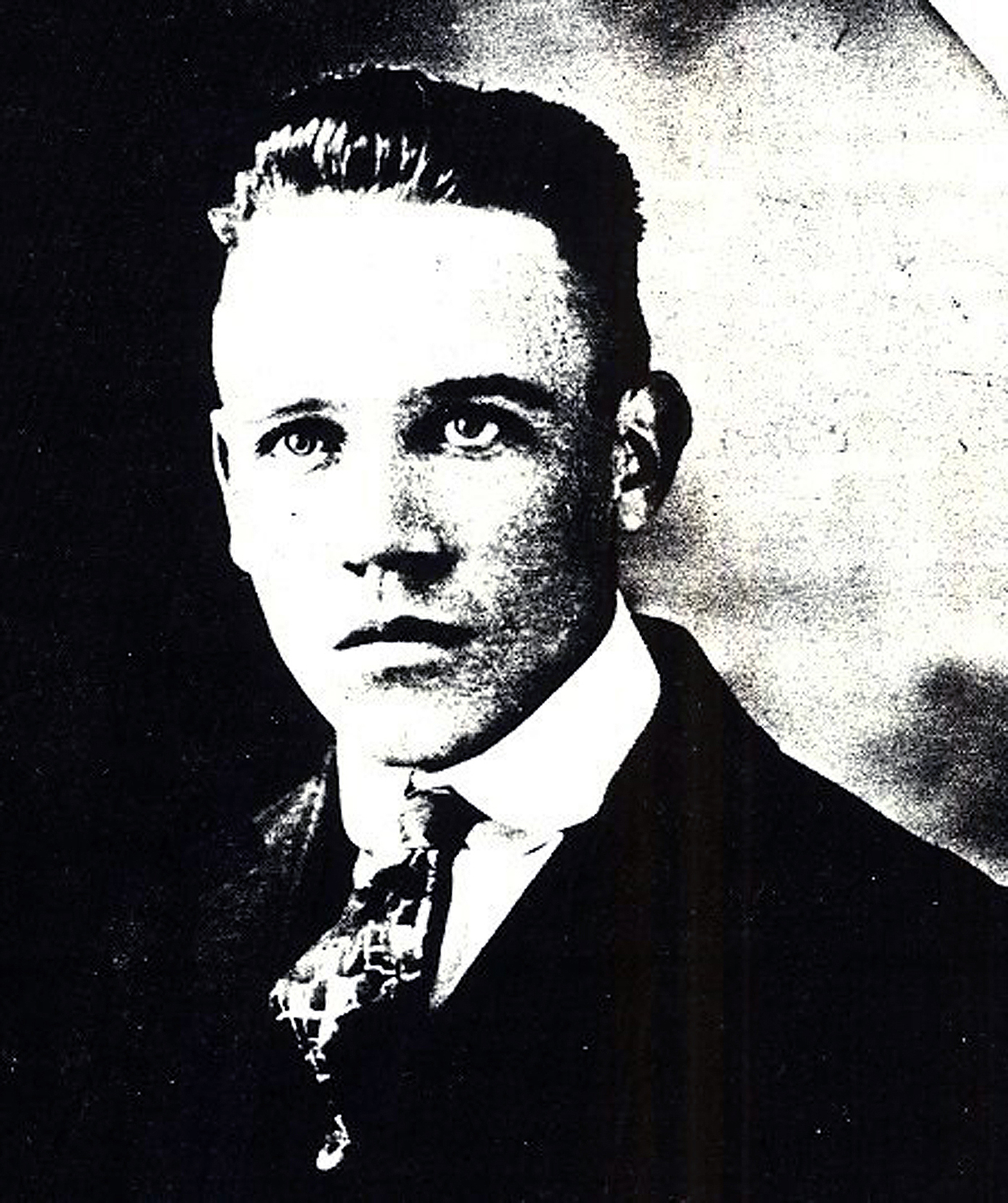
Uncle Kem, by this time, had undoubtedly completed high school for he was now 20 years of age. Uncle Kem had never been a robust, rowdy type boy during his growing up years, in fact, he like his brother Hyrum, had health problems. He was restricted in what he could do on the farm, and by his very nature was not inclined to be a "tiller of the soil" nor a laborer with animals. He wanted none of it, but with that lack of interest it did not mean that he had no other ability nor inclination. He had early accepted his health problem and early saw the need for an education, and this became his goal. The physical condition of his body was such that if he had a future - which he did - it had to be in another field than farming.
He loved the Church and he loved people and he loved teaching. How early he started university work this writer does not recall. We are aware that he received a mission call in 1919, and that he was 21 years of age at that time. It is entirely possible that he had at least a year of university work prior to his mission to Los Angeles, California.
With his two year mission completed, he returned to the University of Utah to pursue his education early in 1921, if not even as early as the fall quarter of 1920. Whether he had become acquainted with what proved to become his life's work, the Church seminary program, before he left for his mission or whether he became aware of it while on his mission we have no way of knowing. The program was relatively new by the commencement of the 1920s. At the time of the commencement of the seminary program in the school year of 1912-13, it was a revolutionary concept of education. Even in wholly Mormon communities, there were school patrons who felt religious teaching should not be given in connection with regular public high school work, even though the promoters of the program suggested a period of, what they called, released time, and that the seminary teacher and the housing facilities be separate and apart from the public school system.
By the early 1920s, progress had been made, particularly in solid Mormon communities. The prospect of becoming a seminary teacher appealed to Uncle Kem and it was to this end he directed his university work.
While serving in the California mission, he met a young lady missionary from Salt Lake City, Marie Desmond Hill, a daughter of a retired or near retiring sheepman, Nephi Hill, formerly of the Big Piney, Wyoming area. They had moved to Salt Lake City for his daughters to be close to a university.
Within months of the return from their missions, these two young University of Utah students, Kemuel Blacker and Marie Hill, were married in the Salt Lake Temple on the 30th of June 1921, and continued with their university work. Upon graduating in possibly 1923, his career as a seminary teacher commenced by his accepting Monroe, Utah, a little town in south-central Utah as his first school. If memory serves correctly, Aunt Marie taught school during these same years. She was an accomplished person with talents which set her apart from the average. She was superb at the piano, with which she often accompanied her singing Her talents would bring to a standstill all other activities in her home. Aunt Marie was one of the finest persons one would ever meet. She certainly was far from being forward. Her quietness and dignity of demeanor had to be recognized, and yet she never placed herself on a pedestal of any description. It was easy for her to make herself one of the family, and respect for her was not hard to come by. The better acquainted, the deeper the love.
With a semblance of regard for sequence of time in this family history, let us permit Uncle Kem and Aunt Marie to continue with their teaching in Monroe, while we return to the Blacker home in Afton, Wyoming.
On the 3rd day of January 1924, Grandma Althera Blacker commemorated her seventy-second birthday, but she was not well, in fact, had not been in the best of health for the past several months. For nearly fourteen years, she had lived as a widow. Her mother had passed away twenty-two years before, and she, Althera, had made the long, hard trip of approximately 125 miles by buggy to their old home in Almy. There she had assisted in her mother's burial, and a stood by the side of her grandmother's grave. Ann Powell Danks, whom she knew and loved very well, had been at rest for eleven years. Also nearby, was the spot where she, with others of her family, had placed the little body of her 2 year old baby, little Isaac, this in 1886.
Undoubtedly, it was on her return trip, that she took her daughter, Mary, and her father, Isaac Loveday, back to her log-house home in which she, with the others of her family, had been living the last six years. What a dutiful daughter to be intent on the care of her aged father, who was at the time - 1902 - 81 years of age.
Grandma Althera was well aware of their conditions back in the little rebuilt, at least, added-on-to log house with not more than a total of four or five rooms. There are those who then, and certainly those in our modern day of 1982, who would have said that she would have been justified in saying, "No, we don't have room." Grandma Althera was the type of woman who would never have given thought that her father was not to return with her. She was one who would have said, and probably did, "He took his turn caring for me, and it is now my turn to take care of him."
The decision was not hard as to what she should do, but a real problem existed. She had already endured much. She was small of stature, probably 5 feet 4 inches, and after eleven children, she was now 51 years of age. Her husband was 52, and the following children were now to be in the home, Mary, age 23; Tom, 21; Maria, 19; William, 16; Merintha, 14; Hyrum, 11; Fannie, 9; and Kem, the youngest, 5 years of age.
Grandma solved the problem - we don't know how, but this we do know, that she neglected no one. She was not that type of mother. It has been suggested earlier in this story, that marriages of the older children relieved the situation, but it was more than a year before Mary and Tom became part of a double wedding. It was two years before Maria was married, and then there was respite in marriages for a period of six to seven years before Merintha left the nest.
In the meantime, and a year and a half prior to Aunt Merintha's marriage, as it comes to all men, using an old cliche, Grandpa Loveday, nearing the age of 90, passed away on the 11th of May 1910. While details of his last illness are not now recalled, certainly there would have been a longer period of deterioration than would have been pleasant over the long haul. Already, some of us older ones are beginning to realize the difference between youth and 'the golden years' as someone has drummed up the courage to call our later years. It seems quite likely there would have been a period of bedfastness for Grandpa Loveday, but we must also be cognizant of the fact that, even though he was, almost to the day, 30 years younger, Grandpa Edward was in such poor health, that he probably was more impaired in health at 60 than his father-in-law was at 90. The little log cabin had to be serving as a hospital.
Just six months following the burial of daughter, Mary Blacker Wilkes, which was on the 28th of October 1909, the body of Althera's father was taken by buggy and team to the Afton Ward meeting house for the funeral service of Isaac Loveday.
In little log-cabin-hospital-home, another six months later, on the 27th day of November 1910, Grandpa Edward completed his term on earth. Surely, as with the previous passing, they were not surprised. Grandpa Blacker had become old before his time for getting old - not 60 for yet another two months. Most likely it was the same team of horses and buggy making this second trip the two and three-quarters miles to the same meeting house for services and thence to Grandpa Edward's final resting place.
To return to the home of grandma Althera, 58; William 24; Merintha 22; Hyrum 19; Fannie 17 almost and Kem just passed 13 and there had to be sadness to accompany them. It will probably be remembered that little Harold Gardner, a grandson of Grandpa Edward and two year old son of Uncle Brig and Aunt Maria passed away one day following his Grandfather and a duel funeral service was held.
And so, time passed and some of the events which it brought have already been reviewed in this account. Care will be taken not to do an overly amount of repeating, but we shall suggest that Grandma Althera was a part of all that transpired to any of her children. Please overlook my mentioning again the fact, that within another three years from the passing of Grandpa Edward, the family who were remaining, moved into a new house. I mention it again because it did mean so very much to Grandma. For approximately 17 years she had been so very patient, under often trying circumstances, due to her crowded living conditions. This move brought her a deep sense of pleasure - even joy. I will mention another account which has already been refered to, but which cannot go by without comment
A life-time dream of Grandma Blacker came true on the 14th of June 1916. Althera had been taught from childhood, the glorious principle of temple marriage. However, due to the fact of her being raised in an isolated area, and also that she had married a man who was not a member of the Church, she was not able to conform to that principle so necessary for eternal happiness. Even after her husband's conversion to the Church, they lived far away from a temple, which situation caused them to postpone being sealed together as a family.
Grandma knew that her family could be eternally hers only by going to the temple that she might be sealed to her husband and have her children sealed to their parents, In the ceremony by which they had been married, it was specifically stated "till death doth you part." The minister who married them in the St. David's church, of the parish of Llanwonno, near Mountain Ash, did not claim to have authority that his marriages would be binding for the hereafter. The authority for such eternal marriages was restored when the Prophet Elijah, whom the Bible promised would return, brought the keys of the sealing power of the priesthood to Joseph Smith and Oliver Cowdery in the Kirtland temple on the 3rd of April 1836. No where else in all the world are these eternal promises given, other than in the temples of The Church of Jesus Christ of Latter Day Saints.
 ALTHERA BLACKER FAMILY Picture taken in Salt Lake City in mid-June 1916. Temple
family sealings was purpose of the trip. Uncle George and family were then living
in Cumberland, and Aunt Merintha and family in Kemmerer, Wyoming. Aunt Sarah
Ann and family were living in Sugar House near Salt Lake City. All others were
living in Afton. Front row: Merintha, Althera, Fannie. Middle row: Maria, Sarah
Ann. Back row: William, Kemuel, George, Thomas, Hyrum
ALTHERA BLACKER FAMILY Picture taken in Salt Lake City in mid-June 1916. Temple
family sealings was purpose of the trip. Uncle George and family were then living
in Cumberland, and Aunt Merintha and family in Kemmerer, Wyoming. Aunt Sarah
Ann and family were living in Sugar House near Salt Lake City. All others were
living in Afton. Front row: Merintha, Althera, Fannie. Middle row: Maria, Sarah
Ann. Back row: William, Kemuel, George, Thomas, Hyrum
On the above mentioned date, 14th of June 1916, all members of the Blacker family who were eligible to enter the Salt Lake Temple, met together. The ordinance of sealing Grandma Blacker to her deceased husband was performed over a sacred alter of that temple. Following this, the children knelt around the same alter, and by the authority of the restored priesthood, were sealed to their parents. The blessings of such sealings are predicated upon proper observance of the laws of the gospel so long as one lives.
And so, providing that each individual who was present remains worthy, the great blessing of this family unit being bound together as a family - parents and children - will be assured. Only those who fail to comply will be denied this forthcoming blessing and that will be due to personal choice.
Such becomes the crowning principle of the gospel of Jesus Christ, the most glorious blessing offered to mankind for this provides an opportunity for mankind - only those in family units - to progress to become as God is.
The assurance brought to not only Grandma Blacker, but to each of the children involved, remained with her for the balance of her life. She lived for another eight years and her family was good to her. While she, to her dying day, demonstrated her independence, nevertheless, her children saw that she wanted for nothing. The last part of her life became somewhat easier for her. She had experienced many of the vicissitudes of life and her life was not easy, but she gloried in the goodness of her family. She experienced periods of concern for a sufficiency for her family's needs but, overall, these periods came to an end. This writer remembers well a sage statement by her, as several of the family were sitting about the room in an hour of visiting. "I have no desire to be rich. but I hope I will always have enough to buy what I need." And are any of us any different?
Seventy-two years and twenty-five days passed since she first saw the light of day on the 3rd of January 1852, in Pontypool, Monmouthshire when, in her own home, surrounded by most of her family, she closed her eyes for the last time on the 26th of January 1924. Perhaps no better can be done at this point than to copy her obituary as published by the local weekly newspaper in Afton, "The Star Valley Independent".
"ALTHERA BLACKER IS CALLED BEYOND"
'Passes Peacefully Away Last Saturday After Long Illness'
The many friends of Mrs. Edward Blacker will be grieved to hear of her death which occurred last Saturday at her ranch home in Afton. Practically all of her children were at her bedside when the end came.
Mrs. Blacker has been ill for a long time and while we are all grieved to hear of her passing, we are comforted by the thought that she is now past all suffering and laid at rest. Funeral services were held in the North Ward Chapel Monday.
Funeral services of Sister Althera Blacker were held Monday, January 28 at 1 p.m. in the Afton North Ward Chapel. The services were presided over by the Afton North Ward Bishopric. The speakers were Bishop Osborne Low, Bishop Charles Peterson, of Smoot, President Arthur F. Burton, and her oldest son, George Blacker. The choir rendered some favorite hymns, sympathetically. Sister Lois Wilde and Edith Hurd, whom Sister Blacker always enjoyed hearing, sang "I Come to Thee".
Bishop Low, the first speaker, told of Sister Blacker's remarkable devotion to her family, especially when they had sickness in the home, and how she seemed untireing in willingness and bodily strength to aid those who were in trouble. Bishop Peterson spoke of her as he knew her with her family in Almy, Wyoming thirty-nine years ago. How she was always on hand there in case of trouble. Brother Burton spoke of her desire to live and work in the Temple and, also how when he was called to administer to her he felt inspired rather to bless her than to promise her life. Although it was very hard for George Blacker to control himself, yet he conquered and paid a loving tribute to his devoted mother.
Mrs. Blacker was born in Wales on January 3, 1852. She is the mother of eleven children, eight of whom are living; they are George Blacker of Cumberland, Wyoming; Sarah Ann Nisbet of Acequia, Idaho; Thomas Blacker of Rupert, Idaho; Maria Gardner of Afton, Wyoming; William Blacker of Rupert, Idaho; Merintha Williams of Salt Lake City; Fannie Cazier of Afton, Wyoming, and Kemuel Blacker of Salt Lake City. All of her children were present except one who was ill. She has sixty grandchildren and is survived by her youngest brother, Kemuel Loveday who was present at the funeral services.

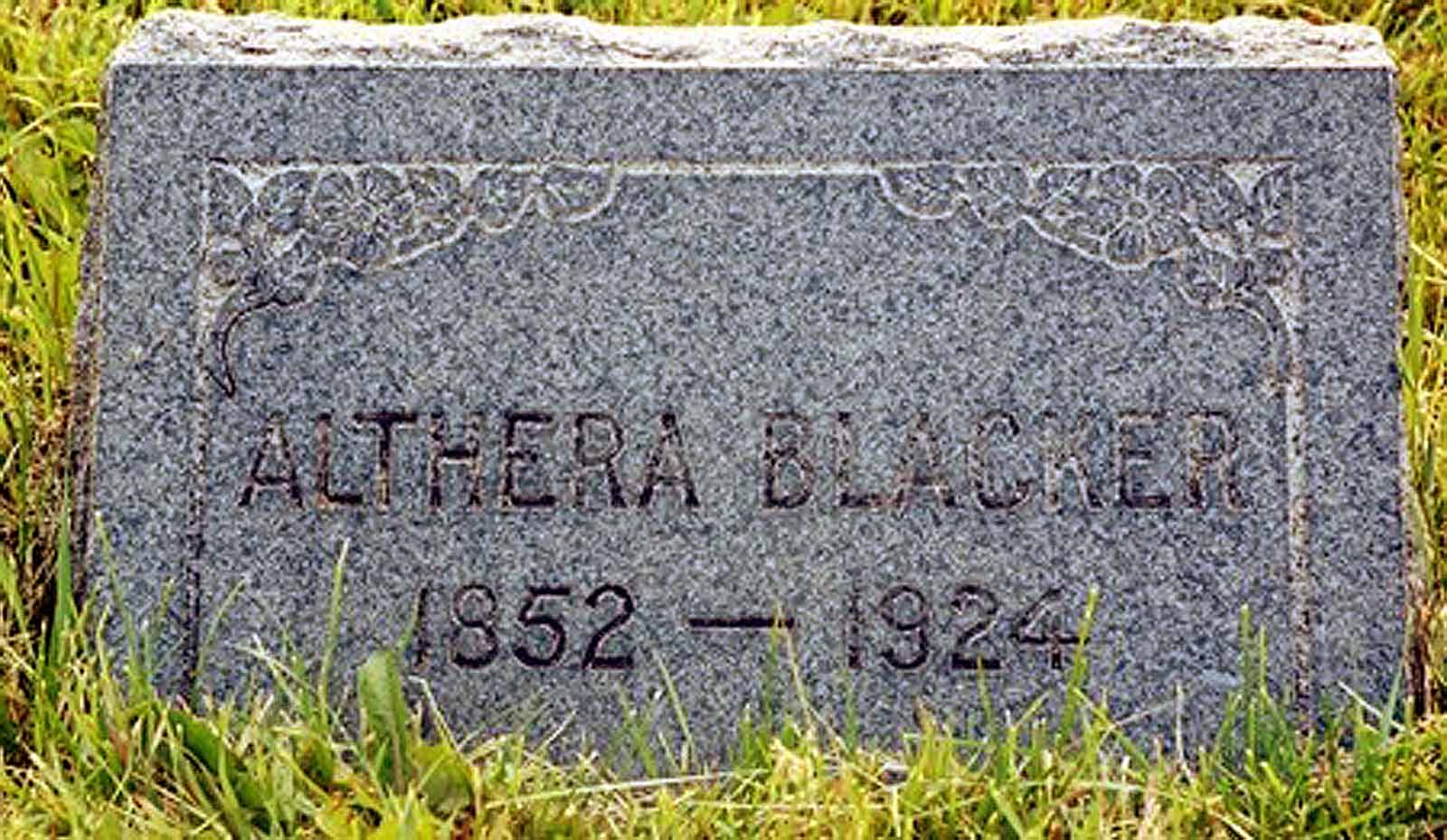
Grandma Blacker was laid to rest in the Afton cemetery in a grave at the side of her companion, Grandpa Blacker on the 28th day of January 1924, two days following her decease.
Again, returning to the account of Uncle Kem and Aunt Marie where we left them teaching in Monroe, Utah. How long they remained in Monroe we do not recall, nor is it of such importance that we need be so exact. We can be assured it wasn't overly long, perhaps a year, two years or three. We are aware that they were back in Salt Lake City and were continuing some university work, possibly toward a Master's degree. As has been written in Chapter 3 of this work, my father, Thomas and I drove to Salt Lake City in 1927. After meeting Uncle Kem and Aunt Marie, they in their Model T coupe and Dad and I in a Model T four-door touring car, began a trip, driving to Cumberland to visit Dad's and Kem's brother George and family. We stopped at Evanston to visit with their cousin, Ted Blacker, having recently arrived from Abertillery, in Monmouthshire. As I recall, the roads were all surfaced with gravel excepting near Salt Lake. Mention of this trip at this point is solely to confirm the fact that Uncle Kem and Aunt Marie were then living in Salt Lake on 13th East and not far from the University of Utah.
They were at this same apartment on the 20th of January 1928, on my entry in the Mission Home on Monday, January 23rd for my mission to Great Britain. Upon my return on the 3rd of April 1930, Aunt Marie met me at the D. & R.G. depot, and their home was then on State Street in Murray. By this time, Uncle Kem was teaching seminary at the Jordon High School. Whether he was teaching there at the time of my departure two years earlier I do not know. Uncle Kem and Aunt Marie made a wonderful couple and they were beautiful together. Uncle Kem was fun-loving. Teasing by him became a delight to the one being teased, as well as the lookers-on. It was for fun and he did a lot of it. For many years they were without children, but their front and back yards were often full of neighboring children. His success was early noted in his seminary work. He was a "born teacher" and was early recognized as such by the Church Department of Education. The Jordon School District was one of the larger districts of the state. At the time he taught, the seminary was being held in a wooden frame building near the high school and it became my pleasure to be invited by him to spend Friday morning (the 4th) with him in his classes. One could see that his students admired and loved him. It was with much regret to all of us, that Uncle Kem's health was not good. But he continued on with his seminary teaching. There can be no question, but that the arrival of a little son on the 25th of November 1930, was an answer to years of yearning and many years of prayer. They wanted children but seemingly were to be deprived of this great blessing. They were people of great faith, particularly, Aunt Marie, and it seemed as though there was nothing the Lord would withhold from them because of that proven faith. Such just had to be in the case of her late- coming little boy. It was as if the Lord said, "Daughter Marie, because of your great faith I can no longer withhold this child. You have waited sufficiently long." They named him, Kay Hill Blacker.
Interestingly, from the time Aunt Marie joined the family, we became aware that she was not overly fond of her husband's given name. Each of us have peculiarities and idiosyncrasies peculiar to ourselves. Without any particular reason they affect us in one form or another, so Aunt Marie's preference of not fully liking Uncle Kem's given name, never became a matter of criticism on the part of the family. She, undoubtedly with Uncle Kem's consent, used the letter 'K' which, in and of itself, seemed to require another supportive letter so she added - and again Uncle Kem accepted - the second "K" so in the later years of his life, he became known as K.K. Blacker. Could it have been that the sound of the letter 'K' was of such an affinity with her that it had a bearing on the name 'Kay' which they gave their firstborn? We early learned to highly respect Aunt Marie - what a lovely person she was.
Uncle Kem's health deteriorated. Their little boy became a year and a half old, under the watchful, and so very proud parents, when Uncle Kem was forced to bed. Too many things were wrong with him for him to be able to counter them all. Due to his long-time suffering, he resigned himself to the fact that he would never recover, but he lingered. It seemed his mission was nearing an end, but we all had hope, and especially so did Aunt Marie. She felt it was hardly right for her to give up - she simply couldn't give up. Her prayers were uttered with faith but seemingly, despite her hold on her husband, it appeared that the Lord was needing a super seminary teacher in another place.
Perhaps it would be timely to now turn to another portion of our taped life story of Uncle Will Blacker. As previously in the dialogue to follow, the 'L' is for the inquirer, Loyn, and the comments by 'UW:', Uncle Will. The date of the taped conversation, 27 July 1965:
UW: I'll have to tell you a sad experience when Kem died (his brother). He died in Murray, you know, my brother Kem.
L: He died when - 1931? (We were speaking as we were remembering after more than 30 years and we were both wrong, for it was in 1932.)
UW: Yes, in 1931. He had always said he was going to get better, he was going to get better. They had a very great friend down there, Bishop Miller, who was the bishop of their ward in Murray. He (Uncle Kem) was sick and I went down and was there this morning when Brother Miller came in to see how Kem was getting along. When Brother Miller came in that morning, Kem said, "Brother Miller, I want you to pray for me to die. I want you to administer to me and pray for me to die, for", he said, "I know I am not going to get well." Brother Miller tried to talk him out of it, but Kem said, "No, I just want you to administer to me and pray for me to die." Brother Miller didn't want to, but Kem said, "Brother Miller, if you won't, I'll get somebody else to." Brother Miller said, "Ok, if you insist, I'll administer to you and I'll pray for you to die." and he did.
That was in the morning and about noon or right after noon, Kem called Marie - his wife-to him. He wanted Marie to kneel and pray for him to die. If there was ever a sad thing, that was it. To think that he wanted his wife to kneel and pray for him to die. "Oh", she said, "Kem, I just can't do that!" He said, "I want you to", so he insisted and Marie finally did. Two or three hours after that, the boy passed away. (He was 34. L.B.) He said, "Marie, I know that you are the only one who is keeping me alive. You give up and pray for me to go." So she did, finally. That was the sad part.
L: It was surely a big loss to the family when Uncle Kem passed away. He meant so much to all of us.
UW: Yes, that was the saddest thing I think I ever saw in my life.
L: But there seemed no chance at all for Uncle Kem to ever get better.
UW: No, there was no chance and Bishop Miller was so surprised for Kem had always told him that he thought he was going to get well until that morning. I guess he got an inkling or something during the night. Brother Miller would always come in every morning. He was a wonderful man.


Uncle Kem's passing occurred on the 10th of June 1932 and he was buried on the 13th in the Elysian Garden Cemetery near Murray.
Uncle Kem was highly regarded by his peers, as was indicated by the fact that a member of the Quorum of Twelve Apostles, Joseph F. Merrill, who was, at that time, Chairman of the Board of Education for the Church and was the director of the seminary program of the Church. It would seem appropriate to say, with little fear of contradiction to the contrary, that no other member of the Blacker family has had such a distinction, as having a member of the Quorum of Twelve to be the guest speaker at a funeral service. Indeed it was, that Uncle Kem was a great and good man and a master teacher.
Five and one-half months following Uncle Kem's passing there came another little spirit into Aunt Marie's home to help fill the vacancy of her father, whom she never had the pleasure of knowing in mortality.
Aunt Marie was not the kind of woman to have considered the new arrival to become another hardship. There may have been tears - many tears - but they were not from fright of the challenges ahead. Rather, if there were tears, and we know there were, they would have come from the thought of how much Uncle Kem would have loved to have been a part of helping her raise his little son and, now, his newly arrived daughter, whom Aunt Marie chose to call Ann Marie. The baby's birthday was the 30th of November 1932.
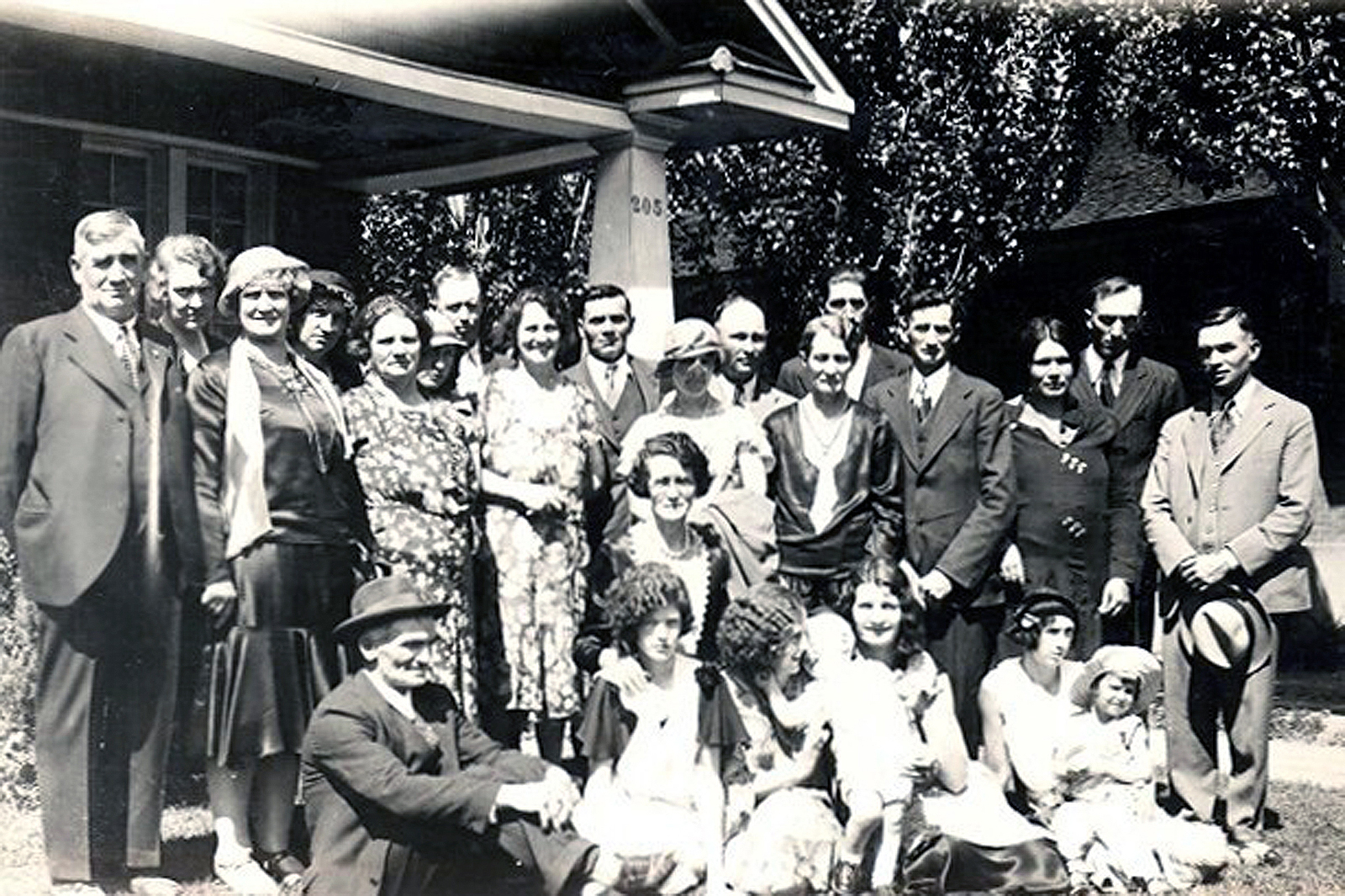 Blacker family members following Uncle Kem's funeral. Aunt Marie is between
Uncle George and Aunt Polly on left.
Blacker family members following Uncle Kem's funeral. Aunt Marie is between
Uncle George and Aunt Polly on left.
The fact that this home became a one-parent home was different from many one-parent homes because these two little children had a parent with the capacity to provide a double portion of love. Aunt Marie's full purpose with her son and daughter was to do all she could to prepare them for the time when the family unit would unite with her husband, and the little children's father, in a place where death would never bring a like experience of separation as was experienced on the 10th of June 1932. To Aunt Marie, this was not just a belief in the eternal nature of the family - it was confirmed knowledge - and knowing Aunt Marie as we do, we cannot doubt but that from that date to this - the fact that she has long since left his mortal life, notwithstanding - she has not yet ceased kneeling and praying that the good Lord will watch over and influence her two beloved offspring, and even their children, that when their times are announced that it will again be her pleasure to share them with her eternal husband in an even larger family unit from which there will be no further separation.
Kay and Ann became the beneficiaries of a good home life throughout their growing-up years. Both had married and were well on their way with their respective families - Ann, first, to Ron Astle in 1953 and Kay to Joyce Ricks in 1954 - prior to their mother's decease on the 21 February 1962.
For an overall account of Aunt Marie's life, and to maintain brevity, the Deseret News obituary will be considered timely:
"MARIE BLACKER, EX-MURRAY TEACHER, DIES
MURRAY - A former Murray educator, Mrs. Marie Desmond Hill Blacker, 67, 4889 Wasatch St. (250 East), died Wednesday of a cerebral thrombosis in a Salt Lake hospital.
Funeral services will be conducted Saturday noon in the Murray First Ward chapel, Church of Jesus Christ of Latter-day Saint, 180 Vine Street.
Mrs. Blacker, a teacher for more than 30 years taught at Liberty School in the Murray District from 1928 until her retirement in 1959. She also taught in the Granite School District from 1914-1928.
An active member of the Daughters of Utah Pioneers and the Church of Jesus Christ of Latter-day Saints, she served a mission and had been a former member of the Salt Lake Tabernacle Choir.
She graduated from the University of Utah in 1918, where she was active in drama.
Mrs. Blacker was born May 17, 1894 in Big Piney, Wyo., a daughter of Moroni Nephi and Anna Sanuelson Hill.
She married Kemuel K. Blacker June 19, 1919 in the Salt Lake Temple. He died June 10, 1932.
Survivors include a son, Dr. Kay Blacker, Mill Valley, Calif.; a daughter, Mrs. Ronald (Ann Marie) Astle, East Millcreek; seven grandchildren and a stepmother, Mrs. Edith Hill Cook, Salt Lake City.
Friends may call at 4760 S. State Friday from 7 to 9 p.m. and Saturday one hour prior to services. Burial will be in the Elysian Burial Gardens.
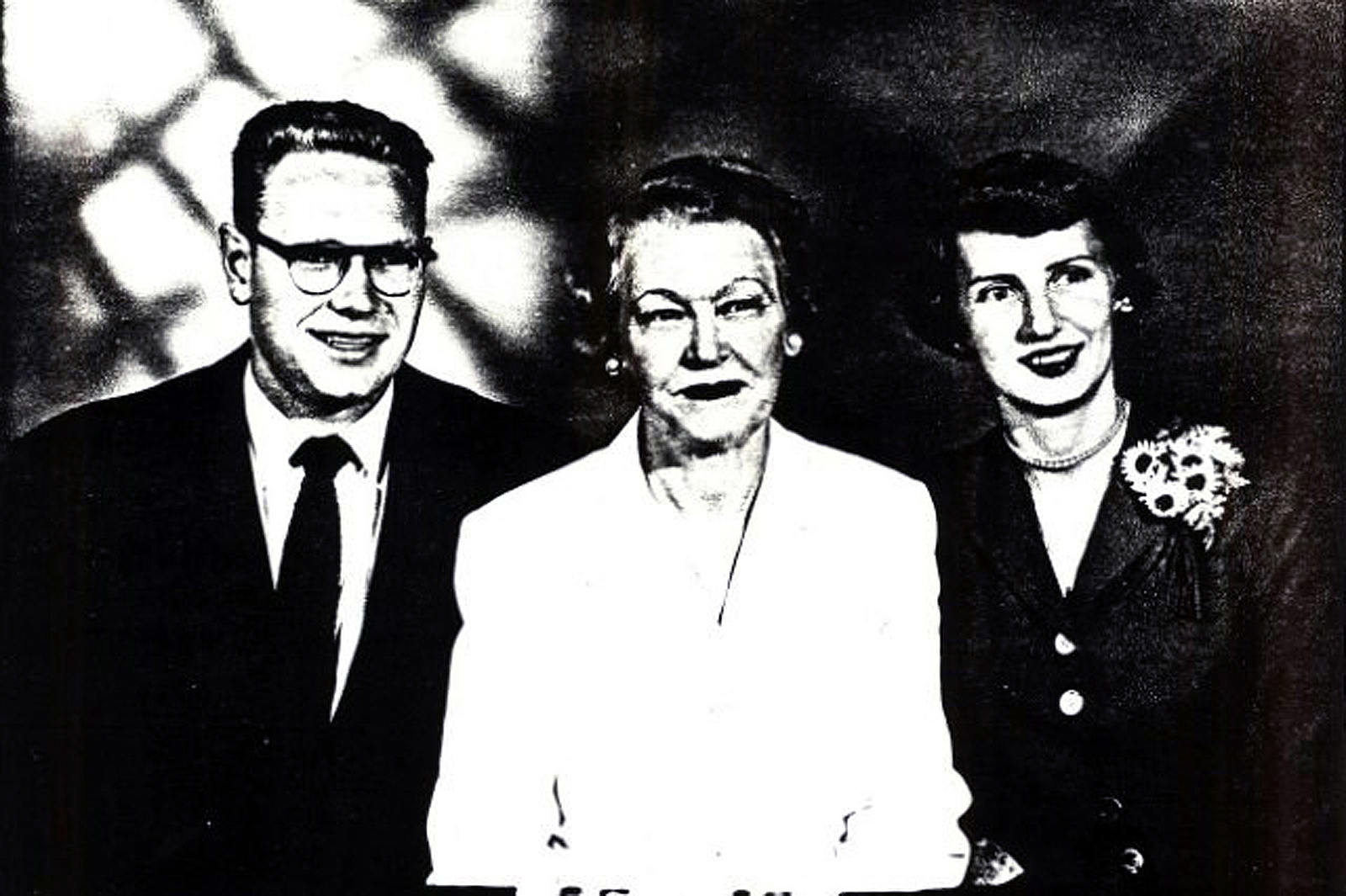 Aunt Marie with son Kay, and daughter Ann in 1953. She passed away 21 Feb, 1962
in Murray, Utah following many years serving as a school teacher, by which means
she provided for her family. All four members of this family graduated from
the University of Utah.
Aunt Marie with son Kay, and daughter Ann in 1953. She passed away 21 Feb, 1962
in Murray, Utah following many years serving as a school teacher, by which means
she provided for her family. All four members of this family graduated from
the University of Utah.
Upon reviewing the above obituary there was immediate concern about what had been written earlier in this history and the above given date of marriage. Family records confirm Uncle Kem's and Aunt Marie's marriage date as the 30th of June 1921, thereby disagreeing with the above marriage date.
Attempts for personal correspondence with Kay for data for this history have failed, due to outdated and non-current addresses. Also absence from home on Kay's part, and knowing he would not be back home in time to meet our schedule, has dictated another approach.
Reliance on his sister Ann's appraisal of Kay's and Joyce's family's lifestyle will, undoubtedly, prove to be more complete than were Kay and Joyce to offer their own, for it has been well said, "A modest man never talks of himself'. This may prove to be unfair, but thanks, Ann, and we shall quote directly:
Kay got his M.D. in general medicine and then went on to specialize in psychiatry and then specialized even further and is one of the select group of analytical psychiatrists. Joyce already had her degree in elementary education, but the past few years she went back to college and got her degree in music. She has also been studying voice and sings beautifully. She directs her ward choir, as well as directing a choir of another faith.
They have four children. Their oldest, Kem, is married and working in New York City in economics. Kerry is a junior in medical school at the University of San Francisco. Rick just got married last month, and both he and his wife are graduating from college and going on to law school next year. Roan is attending UCLA. I forgot to mention that Kay works for the University of California Medical School at Davis and also does private practice in his home. He has the opportunity to present his papers throughout the country at different universities and psychiatric conventions.
Thanks Ann, for an all brief, but interesting resume of your brother's family. Now let's review Ann's family. We continue to quote:
Ron (Ann's husband. L.B.) has been practicing dentistry in Carmichael, California, for the past 18 years. He served as bishop of Murray 1st Ward when we lived there and also served as counselor to the bishop a few years. He is now counselor to the Stake Young Men's president.
Besides my normal duties as a mother I have been taking some classes at the college and institute and have been actively involved in the PTSA at school. As far as church callings, I was Relief Society stake chorister for a few years; Stake Young Women Camp Director; Stake Young Women Beehive leader; Stake Young Women president; ward choir director; and now I am the ward Laurel Adviser.
We have six children, but had a foster Apache Indian son for four years while he attended high school here and graduated. Our oldest son, Ken is married and has twin daughters and a son and is working for Price Waterhouse in San Francisco as a CPA. Our daughter, Judy, attended BYU majoring in music education for three years and then got married and has two lovely daughters. Their family is living in Riverton, Utah.
Clint fulfilled a mission for the Church in Taiwan and is now attending BYU. His hobby is performing musically. Daughter, Marie, is a junior at BYU and also majoring in music education. She is in the acappella choir and had the opportunity to tour Israel with them last summer. The year before, she was in Young Ambassadors and toured Russia with them. Son, Alan, is a senior in high school and is being recruited heavily for a basketball scholarship to University of Arizona, Arizona State, BYU, Utah State, Boise State, Idaho State, University of Washington, University of California at Berkeley, etc. He is an excellent student and performs in a musical group and plans to go on his mission after his freshman year in college. We found it interesting that all these schools are willing to let him go on his mission. He wouldn't go there if they wouldn't.
Son, David, is a freshman in high school. His main interest is also basketball. He is 15 years old and already over 6'5". He too is hoping for a basketball scholarship when he is old enough and also is a good student and likes music. (A postscript at the end of Ann's letter tells of their eldest son). Ken also served a mission in the Denver, Colorado Mission.
Ann, thanks for your summary of your family's activities and for a vision of what they will become. It goes without saying, your parents will be pleased.